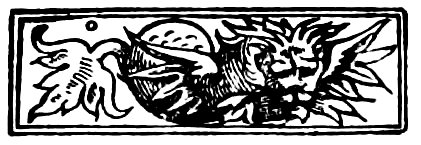
The Project Gutenberg eBook of The boke of Saint Albans, by Juliana Berners
Title: The boke of Saint Albans
Author: Juliana Berners
Commentator: William Blades
Release Date: July 24, 2023 [eBook #71266]
Language: English
Credits: Richard Tonsing and the Online Distributed Proofreading Team at https://www.pgdp.net (This file was produced from images generously made available by The Internet Archive)
Transcriber’s Note:
New original cover art included with this eBook is granted to the public domain.

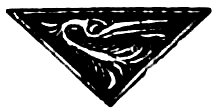

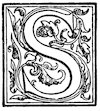
Several independent printing presses were established in England before the close of the fifteenth century; and from them issued numerous books which are invaluable to all students of antiquity from the light they throw upon the social habits and literary progress of our nation. Of these it may safely be said that not one exceeds in interest that work of an unknown typographer, which is here presented in facsimile, and which, from the town in which it was compiled, as well as printed, is known to all bibliographers as “The Book of St. Albans.” This work has always been a favourite, partly because our feelings are appealed to in favour of the writer who for centuries has taken rank as England’s earliest poetess, and is still, in all our Biographical Dictionaries, reckoned among “noble authors;” and partly because we love mysteries, and a mystery has always enshrouded the nameless printer. The subjects, too, so curiously alliterative—Hawking, Hunting, and Heraldry, have an enticing and antique flavour about them, being just those with which, at that period, every man claiming to be “gentle” was expected to be familiar; while ignorance of their laws and language was to confess himself a “churl.”
6As to the language and orthography of the book, it is a never-failing source of interest, being quite different from any other printed work of the fifteenth century, except the St. Albans’ Chronicle from the same press. Among bibliographers it ranks as “rarissimus,” the known copies being so few that they might probably be counted on the fingers of one hand.
Looking at the book, then, all round, it will be a convenient plan to consider these subjects separately, and to treat the volume in its four aspects of Authorship, Typography and Bibliography, Subject-matter, and Philology.



Historians and Biographers, together with Librarians and Booksellers, have a natural antipathy to anonymous books; and, wherever they can, are willing to accept the smallest amount of evidence as proof of paternity. It saves much trouble and avoids numerous errors in cataloguing, when a recognised name can be associated with an anonymous work. From this tendency a bad habit has arisen of attributing to particular writers books concerning which the evidence of authorship is doubtful, if not altogether untrustworthy.
In this very book we have a striking instance of such erroneous attribution. The three treatises, of which the book is made up, are quite distinct, and to a portion only of one of these is there any author’s name attached. Yet that name, “Dam Julyans Barnes,” altered by degrees to “Dame Juliana Berners,” is now universally received as the name of the authoress of the whole volume. With even less show of reason she is credited with the authorship of a “Treatise on Fishing” for which there is not the shadow of evidence, that treatise having been added ten years later by Wynken de Worde, who, when reprinting the Book of St. Albans, thought that the subject of Fishing would complete the work as a Gentleman’s Vade Mecum.
There are really four distinct tractates in the Book of St. Albans, although the two last being on Heraldry are generally counted as one.
8The first is on Hawking; to this no name of the author is attached, but it has a prologue which no one acquainted with the other writings of the printer can doubt to be his. Of this we shall have more to say anon.
The second tractate is on Hunting: it is specially associated with the name of Dame Juliana Berners, and will require a more extended elucidation than the others.
Here the evidence of authorship is as good as for most pieces of fifteenth-century production—a period at which literary rights did not exist, and when the scribe, if at all acquainted with the subject upon which the book he was copying treated, did not scruple to interpolate his own ideas, and that without any egotistical vanity, but merely from a feeling that all books being written for the good of men, and not from vanity in the author, it was a duty to improve them where possible. But as improvement mostly meant the addition of something on the same subject taken from another manuscript, we have the constant occurrence of one MS. being a compilation of two or three others, and yet appearing under the name of the last compiler.
In this treatise on Hunting we have the express statement at the end of the twenty-fourth page—“Explicit Dam Julyans Barnes.” This might certainly apply to the transcription only, but, when taken with Wynken de Worde’s version, the probability is, that the lady compiled as well as wrote it. In the reprint by Wynken de Worde, only ten years later than the original, he varies the colophon thus:—“¶ Explicit dame Julyans Bernes doctryne in her boke of huntynge,” the whole reprint ending “Enprynted at westmestre by Wynkyn the Worde the yere of thyncarnacōn of our lorde. M . CCCC . lxxxxvj.” So that he, a contemporary, evidently believed her to be the authoress. Later authorities attributed the whole book to her pen, but as they were in possession of no more evidence than we now are, and probably not so much, we should attach no weight to such statements, which were founded simply on a vivid imagination.
9But what is known of the lady who is admitted to have compiled the twenty-four pages on Hunting? Who was Dame Julians Barnes? Here, unless a sentimental and inventive sympathy be employed to throw an artificial light upon the darkness, we are in total ignorance. A biography of her has certainly been written, and all our Dictionaries and Encyclopædias devote a page or two to her history, which, in 1810, under Haslewood’s nurture, attained its full development. Even so far back as 1549, or nearly a century after her supposed death, the learned Bale, who wrote an account of all our English celebrities, allows his gallantry to bedeck her memory with garments fine. “Fœmina illustris!” he exclaims, “corporis et animi dotibus abundans ac forma elegantia spectabilis” (An illustrious lady! abundantly gifted, both in body and mind, and charming in the elegance of her mien). Considering that the name of the lady is the whole of the text upon which Bale had to build, this is by no means a bad specimen of imaginative biography, and became a good foundation for future commentators. The story, however, fared rather badly at first; for Holinshed, in 1577, while echoing Bale very exactly, is made, by a curious error of the printer, who mistook the letters rn for m, to call the authoress Julyan Bemes; while Baker in his Chronicles, too careless even to refer to the original text, adds another blunder to the story, and, thinking that Julyan must be a man’s name, dubs the authoress “a gentleman of excellent gifts, who wrote certain treatises of Hawking and Hunting.”
Chauncy, in 1700 (History of Hertfordshire), restored her sex to the lady, and then set to work upon making a family history for her. His first discovery was that, being a “Dame,” she was of noble blood. Finding also that the family name of Lord Berners was, in olden time, spelt occasionally Barnes, he soon supplied a father for our authoress, in the person of Sir James Berners. And so the game of making history went on merrily up to the time of Joseph Haslewood, who, in 1810, reprinted Wynken de Worde’s 10edition of the Book of St. Albans, and supplied a full-blown biography of the authoress, giving particulars of her birth and education, the occupations of her youthful days, and a most imposing pedigree. Let us quote Haslewood’s own words: “Julyans, or Juliana, Barnes, otherwise Berners, who has been generally designated as the authoress of the present volume, is supposed to have been born, towards the latter end of the fourteenth century, at Roding-Berners, in the county of Essex. The received report is that she was the daughter of Sir James Berners, whose son was created Baron Berners, temp. Henry IV., and that she once held the situation of Prioress of Sopwell Nunnery, in Hertfordshire.” He then attributes to her the authorship of all four works in the Book of St. Albans. The difficulty of accounting for a lady so placed writing upon such subjects, is cleverly, if not satisfactorily settled by assuming that she passed her teens at court, partaking of the amusements of the field, and writing for her own use a commonplace book on various subjects. Then retiring through disappointment (doubtless a love affair) to a cloister, her rank raised her to the position of prioress. There in her seclusion, writing amidst the solitude of listless hours and vain regrets, she versified the general rules of sport from her own pleasant recollection, and from the diaries of her youthful happiness, which fortunately she had preserved. If we remember the mania which seized all classes for diary-keeping at the beginning of this century, when Haslewood wrote this, it will deepen our sense of humour to note that he attributes private diary-keeping to a young lady who lived ante 1450.
But enough of such sham biography; let us return to facts.
The word “Dame” did not in the fifteenth century, as it does now, imply any connection with a titled family, it meant simply Mistress or Mrs. Chaucer speaks of Dame Partlet in this sense; and had the Dame Julyans Barnes of the fifteenth century lived now, she would have been just “Mrs. Barnes.”
Similarity of name in history, like similarity of sound in philology 11is a will-o’-the-wisp which has led many a writer into a bog. Allowing that Lord Berners’ name was sometimes spelt Barnes, is that sufficient reason for making our authoress a member of his family? I think not.
That the greater portion of the book on Hunting was compiled by Mistress Barnes, is probably correct,[1] and had she written much more, and produced even an original work on the subject, she would not have stood alone, even at that early period, as an authoress. Crystine de Pisan, two of whose works were printed by Caxton, was contemporary with Julians Barnes, and left not only numerous original writings behind her—one of which was upon the Art of War—but left her mark, and that no mean nor ignoble one, upon the political course and moral development of her countrymen. But Dame Julyans’ work upon Hunting is certainly not original, as indeed very few works upon any subject were at that period. This is evident from a glance at the text and the grouping of the subjects. It begins with distinguishing the varieties of beasts and their ages; the proper names by which to designate the beasts, singly and together; on hunting and dressing a Roe, a Boar, a Hare; of flaying; of the horns of a Roebuck; of the Hart; of the seasons; of the Hare. Then follows, from another source, an interpolation of a discourse between a Master of the Hunt and his man, going over portions of the same ground again; and this ended, we get back again to the original MS. and the dismemberment of various beasts. All through, with the exception of the interpolated conversation, the text is addressed to “My deare childe.” Thus we read—“Do so, my child;” “Think what I say, my son;” “My lief childer;” “Say, child, where you go? my dame taught you so.” Evidently that portion was originally written for a mother to use 12as a school-book, by which her son would learn to read, and, at the same time, become familiar with the terms of venery.
1. Taking Berners and Barnes to be the same word, it is curious to note—in connection with the work attributed to Dame Juliana, viz., The Book of Hunting—that the masters of that sport employed men called Berners, to be ready with relays of horses and to feed the hounds.—See Halliwell’s “Dictionary of Archaic and Provincial Words.”
In the Bodleian Library is a small manuscript on the Terms of the Chase, the beginning of which is:—
This manuscript was probably copied by some youth as a school-exercise, which would account for the following odd colophon—“Explicit, expliceat, ludere scriptor eat.”
Compare the above with the opening stanza of the verses we attribute to Mistress Barnes:—
2. “By frith or by fell” = by forest or by plain; but see Halliwell’s Dictionary.
3. Sir Tristram, the well-known knight of the Round Table, was a mighty hunter, and the great authority upon all subjects connected with the chase. Popular belief attributed to him the origin of all the special terms used in hunting, and his name was invoked to give authority to any statement upon this subject, just as in a later century the arithmetical rules of Cocker give rise to the popular phrase—“According to Cocker.”
The rest of the Oxford MS. is in similar accord with the print, but nowhere in it is there a word about Mistress Barnes.
The words “Explicit Dam Julyans Barnes” have been considered to prove that the lady was alive when the book was printed. If, however, Sir James Berners were her father, of which there is no evidence, she must have been close upon a hundred years old in 1486, as he died in 1390. But this is importing a needless difficulty into the theory, which is not rendered more probable by making the authoress and printer contemporary.
It may here be as well to say a few words about Sopwell Nunnery, over which, without a particle of evidence, our authoress is supposed to have presided. Sopwell Nunnery, Hertfordshire, was founded about 1140, under the rule of St. Benedict, and subject to the Abbot of St. Albans, from which it was not far 13distant. The rule of life among the inmates was very severe, and at the first the nuns were enclosed under locks and bolts, made additionally sure by the seal, on the door, of the Abbot for the time being (Chauncy’s History, p. 466). How long this lasted, and how the nuns liked it, history saith not; but, in 1338, a re-organisation had become imperative, and the Abbot of St. Albans, among other instructions, ordered that no nun should lodge out of the house, and no guest within it (Newcome, p. 468). There does not seem much scope left here for the Prioress to take an active part in field sports, though a hundred and fifty years later, which was about the period of our “Dame,” many relaxations of the strict rules may have become common. But, then, we have apparently accurate lists of all the Prioresses of Sopwell in the fifteenth century, and the name of Juliana Barnes does not appear at all in them. The known dates are these:—In 1416, Matilda de Flamstede was Prioress. Four years before her death, which was in 1430, she was succeeded by Letitia Wyttenham. The next whose name is known was Joan Chapell; the date of her appointment is not recorded, but as she was set aside in 1480 on account of her age, she had probably occupied the position for many years. In 1480, Elizabeth Webb succeeded Joan Chapell.
What is really known of the Dame is almost nothing, and may be summed up in the following few words. She probably lived at the beginning of the fifteenth century, and she possibly compiled from existing MSS. some rhymes on Hunting.
There is still the authorship of the other parts of the book to determine, and if similarity of wording and phraseology may be taken as evidence, they were all from one pen.
At the end of the book on Heraldry the printer has put the following—“Here endeth the book of Blasing of Arms translated and compiled together at Seynt Albons.” Here we have the printer’s own statement as to the origin of his text, and doubtless this, as well as the treatise on Hawking, were made up or “compiled” from more 14than one manuscript in French. Haslewood gives a list of such as are in the British Museum, in several of which portions of the printed work are contained. Works on Hunting and Hawking were not uncommon in the fourteenth and fifteenth centuries, and are still found in all large collections of manuscripts. There were several in the libraries of the Dukes of Burgundy in the fifteenth century, and many are still extant in the national collections of England and France.
The other tractates in the volume have an origin very similar to that of the Book of Hunting. The Book of Hawking is an evident compilation from several manuscripts, which accounts perhaps for its deficiency in arrangement and want of continuity. The Book of Coat Armour also has two distinct sources in contemporary works, one of which was the “De Officio Militari” of Nicholas Upton. From this the schoolmaster copied Book IV. almost word for word, supplementing it from “The Book of the Lineage of Coat Armour,” as stated already. The only other literary work which can be attributed to our printer is the extensive compilation known as the St. Albans’ Chronicle or the Fructus Temporum. But neither in the Chronicle, where he simply combined two histories into one, nor in the Book of St. Albans, which is also a compilation, does the schoolmaster show any literary ability above the average of scholars of his period.
As specimens of the schoolmaster’s powers of composition we annex the following, the originals of which can be seen in the ensuing facsimile pages:—
“In so much that gentlemen and honest persons have great delight in Hawking, and desire to have the manner to take hawks: and also how and in what wise they should guide them ordinately: and to know the gentle terms in communing of their hawks: and to understand their sicknesses and infirmities, and to know medicines for them according, and the many notable terms that be used in hawking 15both of their hawks and of the fowls that their hawks shall slay. Therefore this book following in a due form shows very knowledge of such pleasure to gentlemen and persons disposed to see it.”
“Likewise, as in the Book of Hawking aforesaid are written and noted the terms of pleasure belonging to gentlemen having delight therein, in the same manner this book following showeth to such gentle persons the manner of Hunting for all manner of beasts, whether they be beasts of Venery, or of Chace, or Rascal. And also it showeth all the terms convenient as well to the hounds as to the beasts aforesaid. And in certain there be many diverse of them as it is declared in the book following.”
“Here in this book following is determined the lineage of Coat Armours: and how gentlemen shall be known from ungentle men, and how bondage began first in angel and after succeeded in man kind, as it is here showed in process, both in the childer of Adam and also of Noe, and how Noe divided the world in three parts to his three sons. Also there be showed the nine colours in Arms figured by the nine orders of Angels, and it is showed by the foresaid colours which be worthy and which be royal; and of regalities which be noble and which be excellent. And there be here the vertues of Chivalry, and many other notable and famous things, to the pleasure of noble persons shall be showed, as the works following witnesses, whosoever liketh to see them and read them, which were too long now to rehearse. And after these notable things aforesaid followeth the Blasing of all manner Arms in Latin, French, and English.”
So wrote the schoolmaster. Let us now see what kind of book this is typographically.

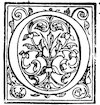
Old books must be loved, and their idiosyncrasies carefully studied, before they will yield up all their treasures; that done, the observant lover will obtain possession of both soul and body; he may revel in the intellectual feast provided by the author, or he may study the material and mechanical features of the books as represented by the peculiarities of paper and the habits and customs of the various printers. Then, by grouping these as a botanist does his flowers, according to their organisation into classes, orders, genera, and species, he may extract from his volumes true replies to questions which otherwise would remain hidden for ever. So true is the dictum, “The Mind it is which sees, and not the Eye alone.”
Many bibliophiles, however, of education and taste have been positively blind when outside the circle of their own particular studies. So it was with the Rev. Dr. M‘Neille, a well-known critic and book-collector of sixty years ago. When addressing Dr. Dibdin he wrote thus of “The Book of St. Albans”—“This book is itself useless, and only a bon morceau for the quizzical collector.” With such feelings towards one of the most curious works which this country produced during the infancy of the printing press, it was simply impossible that the interest of its pages should be revealed to him; and however rich in divinity and editiones principes of the classics the library of the 17worthy doctor may have been, it is evident that our Book of St. Albans could never have been aught but an alien on his book-shelves.
The works printed by William Caxton were almost without exception in the English tongue, while the contemporary presses of Oxford, St. Albans, and Machlinia were nearly all in Latin. Of the eight books at present known to have been printed at St. Albans, the only two in English were the “Fructus Temporum” and the work under review. The “Fructus” or St. Albans’ Chronicle is the same as that printed two years previously by Caxton, with the addition of certain ecclesiastical events and Papal chronology, probably added by the printer himself to please the monks.
The Book of St. Albans’ and the St. Albans’ Chronicle make a class of themselves; but as it is impossible to understand their position without a glance at the other works from the same press, we will give a tabulated description of the whole eight.
| BOOKS PRINTED AT ST. ALBANS IN FIFTEENTH CENTURY. | |||||||||||||
|---|---|---|---|---|---|---|---|---|---|---|---|---|---|
| Title of Book. | Language. | Size. | Date of Printing. | No. of Printed Leaves. | Type. | Size of Printed Page. | Signatures. | Printed Initials. | Ink. | Device. | Woodcuts. | Lines in Page. | |
| 1 | Augustini Dacti elegancie | Latin | 4to | n. d. | 18 | 1 | 5¾ × 3½ | none | none | black | none | none | 36 |
| 2 | Laur: de Saona Rhetorica nova | Latin | 4to | 1480 | 81 | 2–1 | 5¾ × 3½ | signed | none | black | none | none | 24 |
| 3 | Alberti quest. de modo Significandi | Latin | 4to | 1480 | 46 | 3–1 | 5¾ × 3½ | signed | none | black | none | none | 32 |
| 4 | Joan: Canonici Quest. sup. Phys. Arist. | Latin | fol. | 1481 | 174 | 3 | 8 × 5 | signed | none | black | none | none | 44 |
| 5 | Exempla sacre scripture | Latin | 4to | 1481 | 83 | 3 | 5¾ × 3½ | signed | none | black | none | none | 32 |
| 6 | Ant. Andreæ super Logica Aristotelis | Latin | 4to | 1482 | 335 | 3 | 5¾ × 3½ | signed | none | black | none | none | 32 |
| 7 | Chronicles of England | Engl. | fol. | 1483? | 295 | 2 | 8 × 5 | every leaf signed | yes | black & red | with | yes | 32 |
| 8 | The Book of St. Albans | Engl. | fol. | 1486 | 88 | 2–4 | 8 × 5 | signed | yes | black & red | with | yes | 32 |
But who was the printer? What was his name? Was he associated with the great Abbey? and is there any internal or external evidence in his works to connect him with any other printer or any other town?
The only notice we have of the printer is an accidental one by Wynken de Worde, who, in reprinting the St. Albans’ Chronicle, says 18in the colophon, “Here endith this present Chronicle ... compiled in a book and also enprinted by our sometime Schoolmaster of St. Alban.” He was a schoolmaster, then, and this will account for the nature of his early works, all scholastic and all in Latin. Not till the end of his typographical career did he realise the fact that the printing press, instead of being the hobby of a few learned men, was the educator of the people, the whole nation; and then he gave his countrymen what they wanted—a history of their own country and a book upon the whole (secular) duty of the gentleman, as then understood.
The name of the schoolmaster-printer is quite unknown. No notice of him is found in the records of the Abbey, nor does he appear in any contemporary document. Yet here, as in Mistress Barnes’s case, imagination has come to the rescue and a legendary name has been provided.
Finding that the Prologue to the Book of Hawking began with the words, “Insomuch as gentle men and honest persons have great delight in Hawking;” finding also that the St. Alban’s Chronicle from the same press began thus: “Insomuch as it is necessary;” and bearing in mind that certain old authors had veiled their names in the first words of their works, Dr. Chauncy arrived at the sagacious conclusion that the St. Albans printer wished to veil his name, which really was “Insomuch.” The joke, for it almost seems like one, does not bear even the scrutiny which itself invites, for although the schoolmaster uses the words in two other places, in neither case are they at the beginning of a chapter.[4] It should be added that in this the worthy historian of Hertfordshire only followed the lead of both Bale and Pits.
4. On sig. a j recto of “Cote Armour” is “Insomuch as all gentleness comes of God;” and upon sig. b iij verso is “Insomuch that in the fifth quadrat,” &c. The use of the word in these cases could have no veiled meaning, and it was probably only a peculiarity of diction which had become a habit with the schoolmaster.
Was he connected with the Abbey? I think not. There is not a word to suggest such a connection, although we may take it for granted that the Abbot and his fraternity could not have frowned upon 19the printer, or he would never have established himself. His imprints all mention the town of St. Albans, but never the Abbey, and his position was probably similar to that of Caxton, who was simply a tenant of the Abbot of Westminster, but, so far as is known, nothing more.
Was he connected with Caxton and the Westminster press? Without a shadow of doubt I say, No! Mr. E. Scott, of the MS. department in the British Museum, has indeed strung together a number of surmises to show that the Schoolmaster was employed by Caxton, and that all the books without date or place hitherto attributed to Westminster were really printed at St. Albans. But internal evidence is against any such gratuitous assumption. There is nothing in common between the two printers in any of their habits or customs except the possession of Caxton’s No. 3 type. This is the only one of Caxton’s types used outside his own office (for W. de Worde, his successor in house and business, must not be regarded as a separate printer). Caxton employed it from his arrival in England in 1477 till 1484, when it makes its last appearance in the headings of “Æsop,” the “Order of Chivalry,” and “The Golden Legend.” In 1485 Caxton obtained a new fount, similar in shape and character, and from that time the old No. 3 disappears to make way for the new and smaller type No. 5. This being more suited to the taste of the day, we find the larger and worn fount passing over to the country press of St. Albans, where the Schoolmaster first uses it in 1486, being the identical year in which its successor appears in Caxton’s “Royal Book.” We may here observe that after the stoppage of the St. Albans’ Press the same fount finds its way back again and is seen in W. de Worde’s reprint, in 1496–97, of the two English St. Albans books. But the discovery of a copy of Caxton’s Boethius in the old Grammar School at St. Albans, and the numerous fragments of old books extracted from its covers, are quoted as confirming the idea. Yet the book itself and all these fragments were from Westminster, not a single one being from a known St. Albans book, and they included the Caxton “Chronicles,” 1480, the “Dictes,” 1477, and the 20still earlier “Life of Jason;” so that we had better at once remove the whole Westminster press, dated and undated, to St. Albans, if such an argument is to have any force. These fragments, indeed, can only point to the fact that the copy of Boethius was bound in the printing office, as was commonly the case with the books from Caxton’s press.
Again, Mr. Scott draws attention to the fact that a page of the St. Albans’ Book, 1486, has been copied by a contemporary writer on to the blank leaves of one of Caxton’s earliest books. ’Tis true; but this copying of part of one book into another, printed ten years before, has no typographical bearing whatever. Lastly, the name Causton appears in an old St. Albans’ Register of the early part of the fifteenth century. But this, again, means positively nothing. Caxton’s name was not at all uncommon; there were Caustons or Caxtons in nearly every English county, and I have quite a long list of them.
It is highly probable that Caxton, while at Westminster, in the van of all the literature of his day, would have communications of some sort with the important town of St. Albans; but that the two printers assisted one another in the production of books, is, so far as any evidence goes, a pure fiction.
Let us now glance at the bibliographical aspect of the book.
The work itself has no title. It is difficult in our time, accustomed as we are to “teeming millions” of books, each with its own title-page, to conceive a period when the press sent out works without even the shadow of a title-page. Before the invention of printing, the author simply headed his first page with the name of the work, as “Here begins the Confessio Amantis,” or “Hic incipit Parvus Catho,” and, without preface or more ado, the text commenced. Sometimes even this little notification was omitted, and, as in Caxton’s “Jason,” “The Chess Book,” “Tulle,” and many other fifteenth-century books, the subject of the work had to be learned by reading the text. So it is with the book now under review; it comprises four distinct works, but to one only is there any heading, and that has the bare line “Incipit liber armorum.” 21The first, “The Book of Hawking,” starts straight off—“This is the manner to keep Hawks,” and occupies three signatures, a, b, and c, of eight leaves each, and sig. d, which has but four leaves, on purpose that this portion might be complete alone, if so desired. The same idea controlled the arrangement of “The Book of Hunting,” which, beginning on sig. e j, ends with Dame Juliana’s “Explicit” on the recto of sig. f iiij. This left the last seven pages of the quaternion to be filled up. Now it was a common practice, both with the scribes and with the early printers, when they got to the end of their text and found that a page or two of blank paper was left, to occupy the blank pages with such common household aphorisms or popular rhymes as came easily to the memory, or were at hand in some other book. So here the schoolmaster-printer fills up his vacant pages with a number of odd sentences and rhymes, most of which occur over and over again in numerous manuscripts of early poetry. Among others we notice the well-known:—
Also the folks proverb:—
Then the list of proper terms to be used by gentlemen and those curious in their speech is of very common occurrence:—
This was evidently copied from some MS., and ends with “¶ Explicit,” and nothing more. On the next page we have the proper terms for carving or dismembering beasts, fowls, and fishes, followed on the last leaf by a list of bishoprics and provinces.
22Having thus filled up all his leaves, the printer begins his third subject on a fresh signature, and introduces the “Liber Armorum” with the Preface (already printed). A long work on the “Blasing of Arms” follows, beginning on sig. c j, and ending on sig. f 10.
This is extremely interesting, both in matter and in the very rude woodcut representations of armorial bearings with which the text is profusely illustrated. Except in one or two cases of uncommon tints, these are all colour-printed, as are the initials to paragraphs. In the Grenville copy, the pressman having forgotten to roll the “forme,” the initials all appear in that semi-tinted state which would be the natural result of such an omission. We notice, too, that where the coats of arms require, say, three colours on one page, then the initials are also in three colours; but if only one colour is required for the arms, only one colour, and that the same, is used for the initials. Occasionally, where a peculiar colour was necessary, a brush was used to insert that tint by hand.
In workmanship the St. Albans printer, especially in the English books, is much inferior to the contemporary issue from the Westminster press. The types are worse, the arrangement worse, the presswork worse, and the ink worse. From this point of view alone, the theory that he would print for Caxton so much better than he did for himself, is not worth serious consideration.
The Book of St. Albans went through many editions, particulars of which are difficult to obtain.
How did the schoolmaster at St. Albans obtain his types? This is a puzzling question in the present state of palæotypography. Mr. Bradshaw of Cambridge has, by unwearied study of early printed books, thrown great light upon the connection and genealogy of numerous founts used by fifteenth-century printers, and systematic attention to the minute peculiarities of each printer is doubtless the only way in which those old books can be forced to yield up their secrets; but the task is immense, and beyond the powers of any one man to complete. Some day, however, when the palæotypography of this country, as well as of the Continental presses, shall have received that full technical and philosophical analysis which time is sure to bring, the more fortunate bibliographer of the future will be able with certainty to track the footsteps and operations of the early typefounders, and will be enabled to state for certain to what extent Caxton and the St. Albans printer were their own typefounders, and to what extent and to whom they looked for outside help. As the case now stands, we can only confess our ignorance of where the St. Albans types came from.

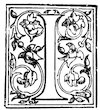
In the rude civilisation of the fifteenth century, a year’s experience of which would send most of us to our graves, the mental occupation as well as the bodily recreation of our ancestors was almost confined to hunting and hawking. “Fishing with an Angle” came in as a bad third, being too tame a pursuit for men who were no men if not men of war. Mimic war—war on the beasts of the field and the fowls of the air—war which could be pursued in times of peace, and which yet required knowledge, patience, fortitude, and courage—this had great attractions, and we cannot wonder at the general popularity of these pursuits.
The first treatise in the following reprint is upon Hawking, a pastime essentially aristocratic from the great expense it entailed in the purchase, breeding, and maintenance of the birds. This, indeed, coupled with the diminution of game consequent on the progress of civilisation and the increase of the population, led to the gradual decadence of the sport, and nearly to its extinction in the eighteenth century, although, in very rare cases, falconry is even now practised.
As we have seen, one of the most difficult objects in hawking was to obtain an easy command of the proper vocabulary, and so at first start our author instructs us in “The manner to speak of Hawks, from the egg.” We must not say a young hawk is hatched, but 25‘disclosed;’ they do not breed but “eyer;” it was a want of culture in any falconer to say that hawks were building their nest, they “timbered” it. When the young could first leave the nest they were “Bowesses,” and when they could fly they were “Branchers,” and then was the time to catch and train them.
When the young were caught, which was with nets, the first thing was to “ensile” them, that is, to “take a needle and thread and sew up the eyelids,” so that they “see never a dele.” After a night and a day the threads were cut softly for fear of breaking the “lyddis of the ighen,” then they were fed with well-washed flesh, but kept awake the next night and day, after which they were supposed to be tame, or “reclaimed.”
The various diseases to which Hawks are liable are then explained, and medicines prescribed for them. Some of these are very absurd and some contradictory. Then comes a variety of terms for every movement and habit, for every limb or part of the body, and for almost every feather in the plumage. In this minute description the author begins at the feet of the bird and so works upwards, as when “Knyghttis been harnesside.”
Next we are instructed how important it is to be careful of the manner of guiding the Hawk the first time it is ready to “nomme a partridge;” how to reward her by giving her the head and neck, after which on no account is she to fly again till she has “rejoiced,” i.e., sharpened her beak and shaken her feathers. More medicines follow, among which is how to get rid of “lies” (lice). “Take a piece of rough blanket and hold it to the fire till it is quite hot; wrap the hawk therein, and without hurting hold her ‘softely and stylly’ in your hands, and all the vermin will creep into the cloth.” A happy thought this!
The “Gesse,” or strip of leather by which the Hawk is held when carrying her on the hand, is next described, together with the creance or long line. More medicines still, and then how to treat Hawks when “in mew,” or moulting, a matter of great importance. To promote 26“mewing” give the flesh of a kid, a young swan, and especially rats flesh; stewed adders are also strongly recommended, or chickens which have been fed upon wheat soaked in broth of vipers.
Gout seems a common disease in various parts of the Hawk’s body, which may be known by swelling and “ungladness;” also rheum and fever and blains and agrum, which last is cured by a red-hot silver needle thrust into the nostrils. Botches in the jaw should be “kutte with a knyfe.” More terms follow for various habits and actions, the last paragraph being upon the variety of Bells used for Hawks. There should be two, one a “semytoyn” (semitone) below the other. “The Bells of Melen (Milan?) were the best, but,” says the author, “there be now used Dutchland bells, of a town called durdright (Dordrecht), and they be passing good, sonowre (sonorous) of ringing in shrillness, and well lasting.”
The whole ends with a list of various species of Hawks and their appropriateness to the various stations of life, among which are—
The second treatise is upon Hunting, and has a short preface, which probably came, like the first, from the pen of the Schoolmaster.
The work is all in metre, and evidently intended for boys to learn by heart. It begins by telling “my dere chylde” the various kinds of beast to be hunted; the changes of name they take as they grow older; the variety of horns; how to skin and dismember; the various cries and noises to be used; the seasons of hunting various beasts.
Then follow instructions how to hunt the Hare, and what to say to the hounds, who must always be addressed in French, as “arere!” when he enters the kennel-door; “this is the first word, my son, of venery.” “Sa sa cy auaunt,” “Sweff mon amy sweff,” and other similar cries are noted down, some to be shouted twice only and some thrice, 27the chief cry being “So how.” The knowledge of when and how often these cries should be used was most important, as their proper use would bring “worship among all men.” Here, apparently, in the midst of one essay, another is interpolated, and we are treated to a portion of some old dialogue like “The Master of the Hunt,” in which the “Man” asks all sorts of questions and the “Master” replies. It might indeed be dubbed “The Hunter’s Catechism.” This occupies eight pages, and then we fall back upon the original rhyme again and the instructions of the Dame to “my childe,” ending with the “Explicit” of Dam Julyans Barnes. Some leaves remaining to be filled up, the moral and other sentences, as already described at page 21, were added.
Perhaps the third treatise upon Coat Armour and the Blason of Arms is the most interesting portion of the book. The quaintness of some of the explanations is very amusing, and many people will find more points of sympathy, both historical and technical, with this than with the others.
The headline, “Incipit Liber Armorum,” gives us at once the title of the manuscript from which the text was compiled. “Heraldry Run Mad” might indeed have been an appropriate title for this, as well as all similar tractates; for the author, in his anxiety to honour the science, does not scruple to take the reader back historically not to Noah only, but to Adam, whose spade, he tells us, was the first shield in Heraldry, and who was the first to bear Coat Armour. The argument, if it may so be called, is:—All “gentilnes” comes from God; there were originally in heaven ten Orders of Angels bearing Coat Armour, but now only nine, Lucifer with “mylionys of aungelis” having fallen out of heaven into hell and other places. As a bondman might say that all men come from Adam, so might Lucifer say he and his angels came from heaven.
Cain, for his wickedness, was the first churl, and all his offspring were churls also by the curse of God. Seth, on the other hand, was a gentleman by his father’s blessing; Noah, too, was a gentleman by nature, but of his three sons, “Sem, Cham, and Jafeth,” Cham, for 28his unfilial conduct, was made “ungentle.” The address of Noah to his three sons is curious, and is thus supplemented:—
“Of the offspring of the gentleman Japhet came Abraham, Moses Aaron, and the prophets, and also the King of the right line of Mary, of whom that gentleman Jesus was born, very God and man, after his manhood King of the land of Judah and of Jews, a gentleman by his mother Mary, and Prince of Coat Armour.”
Some say that Coat Armour began at the siege of Troy, but it was of far greater antiquity than that, and was founded upon the nine Orders of Angels, who were crowned each with a diadem of precious stones—the Topaz (truth), Smaragdus (hardihood), Amethyst (chivalry), Loys (powerful), Ruby (courageous), Sapphire (wisdom), Diamond, a black stone (durable), Carbuncle (doughty and glorious). These represent Gentleman, Squire, Knight, Baron, Lord, Earl, Marquis, Duke, and Prince. Here we probably have the origin of the shape of various crowns and coronets. Everything is treated in nines, and the nine virtues and nine vices of gentleness follow, with nine rejoicings, nine articles that every knight should keep, and nine manner of gentlemen, in which we learn that the Evangelists and Apostles were all gentlemen of the right line of that worthy conqueror, Judas Machabeus, who in course of time had fallen to labour, and so were not called gentlemen. The four doctors of the Church—St. Jerome Ambrose, Augustine, and Gregory—were also gentlemen of blood and of Coat Armour. There are nine differences of Coat Armour and nine quadrats, all of which are explained. The “Blasyng of Arms” comes next, the preface to which is by the author, and not by the printer. It begins with the varieties of the Cross as borne in arms, each being illustrated by a rude woodcut printed in its proper colours, and the blason, or technical description of each is given in Latin, French, and English. All varieties of arms follow, with the mysteries of bends, engrail, borders, chequers, balls, cakes, rings, &c., offering but little which can be quoted, but forming an interesting and useful book of reference.

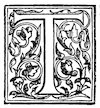
There is a strongly marked individuality in the spelling throughout all the treatises in this work. If the Hunting rhymes belong to Dam Julyans, their orthography, like the prose portions, is that of the Schoolmaster, who appears to have been a North-countryman, many words leading to that conclusion. The formation of the plural by adding the letters “is” or “ys” strikes the attention at once. Thus the plural of bells is bellis; egg, eggis; vetch, fetchis; fulmert, fulmertis; hawk, hawkys; herd, herdys; person, personys, and so on. The change of a y at the end of a word to an i is common, as onli, softeli, unthrefti; and for if; algate; awth for all the; bowke; chylder; clepit; clees; knaw; ken; yowre; and many others are Northern. As might be expected, many Anglo-Saxon and Anglo-Norman words now obsolete are found, such as benymme, blynne, byzete, canell, clepit, colver, dagon, gobbit, kawe, kydde, liggen, merde, nasethrils, nym,[5] raton, and many others.
5. In the slang of thieves to steal is to nim at this day.
The following vocabulary will show the chief words in which peculiarity of spelling or dialect are noticeable:—
We have now traced the various aspects in which this curious work may be viewed. There is not one of them that would not repay much deeper study, and the reader will, doubtless, sympathise with the writer in the wish that more could be discovered concerning the schoolmaster-printer. That his pioneer attempts to establish a printing press met with many discouragements was a matter of course; and, doubtless, he had many technical, business, and even social difficulties to overcome; for a reading public had to be created and patronage was scantily afforded. Nevertheless he struggled on for at least seven years, as we learn from the dates on his books, and whatever may have been his shortcomings, either as author or as printer, the fact of his having been one of the earliest promoters in this country of the grandest discovery which the mind of man has yet made, will unite all of us in honouring the memory and respecting the name, shadowy though it be, of the “Scole mayster of St. Albon.”

Thys is the maner to begynne to kepe hawkys: bot not aƚƚ maner hawkys. bott oonli Goshawkys: and Tercellis of Goshawkys. and spare hawkys. and in watt maner thay shaƚƚ be taake.
Now to speke of hawkys. first thay been Egges. and afterwarde
they bene disclosed hawkys. and communeli goshawkys
been disclosed. as sone as the choughe and in some place
more tymeli after the contre is of hete. and tymeli bredyng.
¶ And we sħaƚƚ say that hawkis doon Eyer. and not brede.
in the woodes. And we shaƚƚ say that howkys doon draw when
they bere tymbering to their nestes. and nott they beld ne make
ther nestes And in the tyme of their loue they caƚƚ. and not
kauke. And we shaƚƚ say that they trede.
¶ And when they bene vnclosed and begynneth to feder any
thyng of lengthe Anoon be kynde they wiƚƚ draw somwatt out
of the nest: and draw to bowis. and come agayn to ther nest
36And then thay be clepit Bowessis ¶ And after saynt Margaretis
day thay wiƚƚ flie fro tree to tree. And then thay bene
calde Brawncheris. And then it is time for to take hem
¶ And .vij. nighttis be fore saynt Margaritis day &̄ .vij.
nightis after is beste takyng of spare hawkes.
Who so wiƚƚ take hawkes he must haue nettis wich ben kalled vrines and tho must be made of good small threde. and it hade need to be died other green or blwe for espieng of thee hawke. and he most take with hym needeƚƚ and threde to ensile the hawkes that ben takien. And in this maner they must be ensiled. Take the needeƚƚ and threde: and put it thorow the ouer igh lid and so of that other. and make hem fast vnder the beke: thatt she se neuer a deeƚƚ and then sħe is ensiled as she awthe to be. Sum vsen to ensile hem with the needer igh lidde a bone the beke on the hede almost: bot that is the wors way For of reeson the ouer igh lidde closith more iustly then the nether be cause of the largenesse. When she is ensiled then bere thi hawke home on thi fiste and cast hir on a perch and let hir stande ther a night and a day and on that other day towarde eeuen. then take and cut eseli the thredes and take hem a way softeli for brekyng of the lyddis of the ighen. Then softe and faire begynne to fede her. and fair fare with her tiƚƚ sħe wiƚƚ sitte weeƚƚ vppon the fist. For it is drede for hurtyng of hir wengys. And then thessame night after the 37fedyng wake her aƚƚ nyght and the morow aƚƚ day. Then shee wiƚƚ be preui Inowgh to be reclamed. And the first meete that she shaƚƚ eete: lett it be hoot. and yeue her Inough ther of
And if yowre hawke be harde pennyd: she may be drawne to be reclaymed For aƚƚ the while that she is tender pennyd: she is not habuƚƚ to be reclaymed ¶ And if she be a Goshawke or Terceƚƚ that shaƚƚ be reclaymed euer fede hym with wasħe meete at the drawyng. and at the reclaymyng. bot loke that hit be hoote. and in this maner wasħe it. Take the meet and go to the water and strike it vpp and downe in the water. and wringe the waater owte. and fede hir ther with and she be a brawncher. And if it bene an Eyesse thow most wasħ the meete clenner then ye doo to the brawncher. and with a linne cloth wipe it and fede hir. And euermore the thrid day yeue her castyng when she is fleyng if she be a Goshawke or Terceƚƚ in this maner: Take new blanket cloth and cut .v. pelettis therof of an inche longe. And take the flesħ and cutt .v. morceilis: and withe a knyues poynt make an hoole in eueri morceƚƚ. and put therin the pellettis of cloth. and take a fair disħ with water and put hem therin. Then take the hawke and yeue her a morceƚƚ of hoote meete the mowntenawns of halfe hir sooꝑ. Then take hit that lyth in the waaṫ. and fede hir for aƚƚ nyght.
If yowre hawke be a spare hawke: euer fede hir with vnwascħ meet and looke that hir castyng be plumage. than looke that it be cleyn vnder the perch. and in the morow ye shal fynde the castyng vnder the perch. and ther ye shaƚƚ knowe whether the hawke be clene or noo. For sum gobbit wiƚƚ be yolow and sum greene. and sum glaymous. and sum cleere And if itt be yolow she engenderith the frounce. the wych is an eueƚƚ that wiƚƚ riese in the mowothe or in the cheke. And if it be grene. she engenderith the Ry. The condicion of this eueƚƚ is this. it wil arise in the hede and make the hede to sweƚƚ. &̄ the iyen aƚƚ glaymous. and dyrke· and bot it haue helpe: it wiƚƚ downe in to the legges. and maake the legges to rancle. and if it goo fro the legges in to the hede a gayne. thi hawke is bot loost. And if it be glaymous and roping she engenderith an eueƚƚ callid the Cray. that is whan an hawke may not muteyse
Take a siluer spoone and put the smaƚƚ ende in the fyre tiƚƚ it be hoote. Then let holde the hawke and oppyn hir beke and brin 39the soore and anoynte it with the mary of a goose that hathe lyne longe. and she shaƚƚ be hoole. And if the frounce be wex as greete as a note. Than ther is a grubbe ther in. and then thow most cutt it with a Rasure in this maner. Lette hoolde the hawke: and slitte ther the soore is. and thew shalte fynde ther as it ware the mawe of a pegeon. Take it owte aƚƚ hoole. and take a payre of sheeris and cutt the hoole of the soore. and make it as fayre as ye may with a lynne cloth. and wipe clene the bloode a way. and anoynt the soore with bawme .iiii. dais arewe and afterwarde with papylyen. tiƚƚ it be hoole.
The frounce commyth whan a man fedith his hawke withe Porke or cattis flesħ .iiii. days to geyder.
For defawte of hoote meete this sekenese the Ry commyth.
The Cray commyth of wasħ meete the wich is wasħ withe hoote water in the defawte of hoote meete. Also it commythe 40of thredis the wtch ben in the flesħ that the hawke is fedde with. For though thow pike the flesħ neuer so clene. yit thow shalte fynde thredes ther in.
And euermore ech thridde day let thyn hawke bathe hym. aƚƚ the somer if it be mere wether. and onys in a weeke in wynter if it be fayre wether. and not ellis. And whan thow bathes thy hawke: euer yeue hir a morceƚƚ of hoote meete vnwasħ though she bene a Goshawke.
Iff ye wiƚƚ that yowre hawke flye in the morowtide. fede hir the nyght before with hoote mete. and wasħ thessame meete in vreyne and wryng owt the water clene. and that shaƚƚ make hir to haue lyst and currage to flie ī the morow in the best maner.
Iff yowre hawke be fuƚƚ goorged. and that ye wold soone vppon 41haue a flighte take .iij. cornes of whete. and put hem in a morceƚƚ of flesħ. and yeue thessame morcellie to the hawke. and she wiƚƚ cast anoon aƚƚ that she hath with in her. and anoon after that she hath cast. Looke ye haue a morceƚƚ of hoote meete to yeue hir ¶ And if yowre hawke be ouergoorged. yeue her thessame medesyn.
Take dayses leeuys. and stampe hem in a morter. and wrynge owt the Iuse. and with a penne put it in the hawkis nares Ones or twyes whan the hawke is smalle goorged. and a non after let hir tyre. and she shaƚƚ be hoole as a fysħ ¶ Or ellis take percelli Rootis and serue hir with theyem in thessame maner. and when she tyrith holde rew ī yowre honde with the tyring and that shaƚƚ make hir voide. bot it is perlous to vse it often that the Iuce faƚƚ ner spryng in to hir yghes.
¶ Also and ye yeue yowre hawke fresħ butter or the marow of hogges that is in the bone of the butte of porke. it shaƚƚ make hir to cast water wele at the nares. and it will kepe the nares opyn. bot it wiƚƚ make hir hawtyn and prowde
Take and chafe with yowre hondys the fundement of yowre 42hawke with luke water a longe tyme. and after that take the powder of Saxifrage or ellis the powder of Rewe. and a quantite of may butter. and temper hit weeƚƚ to geder tiƚƚ thay ben euen medlide. than putte it in a littyƚƚ box and stoppe it faste. & as oftyn as yow fede yowre hawke an hoole meele anoynt hire meete a littyƚƚ ther with. and that shaƚƚ make hir to loue meet the bettir for loue of the oyntement. and it shaƚƚ saaue hir fro the Cray and from mony oder sekeneses: that gender ofte in an hawke.
¶ Also take the hoote hert of a swyne or of a pigge and feede her .ij. days therwith. and she shaƚƚ be hoole.
¶ Also take porke and weete it in hoote mylke of a cowe. &̄ fede the hawke therwith. and that shaƚƚ make hir mutyse att the best.
¶ Also poorke with the mary of the boon of the but of porke shaƚƚ make hir mutise &̄ fede hir with booth to geder.
¶ Also vse hir to fresh butter and it wiƚƚ doo thessame.
¶ Also oon mele or .ij. at the most of the hoote leuer of a pig shaƚƚ make hir to mutyse weele. be ware ye yeue hir not to grete a goorge therof. for it is a perlous meete
¶ Also take ye white of an egge. &̄ labur thessame ī a spoge as weele as ye wolde make glayre for rede Inke tiƚƚ it be like wat̄. put thessame ī a vesseƚƚ. & let the meete yt shaƚƚ be for hir soꝑ: ly a stepe ther in aƚƚ the day be for. &̄ at night fede hir therwt 43and that the wich shaƚƚ be for hir dyner in the mornyng let it ly aƚƚ the nyght. bot in any wyse that ye haue alway fressħ gleyre. and if hir fedyng be poorke it is the bettir. yt is proued
In the begynnyng of kyndeli spech of the termys that belong to hawkys here ye may fynde theym ¶ The first is holde fast at aƚƚ timys. and specially whan she batith. It is calde batyng. for she batith with hir selfe most oftyn causeles
¶ The secunde is rebate youre hawke: to yowre fyst. & thatt is whan yowre hawke batith. the leest meuyng that ye can make with yowre fyst she wiƚƚ rebate ayen vppon yowre fyst
¶ The thride is feede yowre hawke. and not gyue hir meete ¶ The fawrith is an hawke snytith. or sewith hir beke and not wipith hir beke ¶ The .v. youre hauke Ioukith. and not slepith ¶ The .vi. youre hawke proynith. and not pikith and she pronyth not bot whan she begynnyth at hir leggys. and settheth moystour like oyle. at hir taiƚƚ. and bawmeth hir fete &̄ strikyth the federis of hir wynges thorow her beke. and it is calde the note. than as she fetchis the oyle. And ye shaƚƚ vnderstonde an hawke wolde not be letted of hir proynyng. For that tyme that she proynyth she is lykyng and lusty. and whanne she hathe doone she wiƚƚ rowse hire myghtyly.
44And sum tyme yowre hawke cowntenansis as she piked hir. and yet she proynith not. and then ye most say she Reformith hir federis and not piketh hir federis. ¶ The .vij yowre hawke colyeth and not beckyth ¶ The .viij. she rowsith and not shakith her selfe ¶ The .ix. she streynith and not Clithith nor Cratchith ¶ The .x she mantellith and not stretchith whan she puttith her leges from hir oon after an other: and hir wynges folow after hier leggꝭ. then she dooth mantiƚƚ hir and whaan she hath mantilled hir and bryngith booth her wynges to geider ouer hir backe ye shaƚƚ say yowre hawke warbellith hir wynges. and that is oon terme dewe therfore ¶ The .xi ye shaƚƚ say yowre hawke mutessith or mutith and not sklysith. ¶ The .xij ye shaƚƚ say cast yowre hawke to the perch. and not set youre hawke vppon the perch.
First ye shaƚƚ say This is a fayr hawke. an hudge hauke a longe hawke. a short thike hawke. &̄ say not this is a grete hawke. also ye shaƚƚ say this hauke has a large beke Or a shortt beke. and caƚƚ it not bille. an hudge hede or a smaƚƚ hede fayre sesoned ye shaƚƚ say yowre hawke is fuƚƚ goorged and not cropped. and yowre hawke puttithouer and endueth. and yet she dooth booth dyuersely.
An hawke puttithouer when she remeuith the mete from hir goorge in to hir bowillis. And thus ye shaƚƚ knawe it whan she puttithouer she trauersith withe hir bodi. and specialli with the necke: as a Crane doothe or an other bridde
An hawke enduth neuer as long as hir bowillis bene fuƚƚ at her fedyng. bot assone as she is fedde. and restith she enduthe littiƚƚ and littiƚƚ. And if her goorge be wide and the boweƚƚ any thyng stiffid. ye shaƚƚ say she is embowellid and hath not fully endewed and as long as ye may fele any thyng in hir bowellis it is perlous to gyue her any mete.
Say an hawke hath a long wyng. a faire long tayƚƚ with vi barris owt. and stondith vppon the .vii. This hawke is entirpenned That is to say when the federis of the wynges bene bitwen the body and the thighis. This hawke has an hudge legge or a flat leg. or a rownde legge. or a faire enserid legge
Hawkes haue white maiƚƚ. Canuasmaiƚƚ or Rede maiƚƚ. And som caƚƚ Rede maiƚƚ Iren mayƚƚ. white maiƚƚ is soone knawe. Canuasmaiƚƚ is betwene white maiƚƚ and Iron maiƚƚ. And Iron maiƚƚ is varri Rede.
¶ A Goshawke nor a terceƚƚ in thare sore aage haue nott thau mayles named. bot it is calde their plumage. and after the cote. it is calde theyr Maiƚƚ ¶ And if yowr hawke reward to any fowle by countenance for to flee ther to ye shaƚƚ say cast the hawke ther to. and not lett fli ther to.
¶ And if yowre hawke Nomme a fowle. and the fowle breke a way fro hir. she hath discomfet mony federes of the fowle. and is brokyn a way for in kyndeli spech ye shaƚƚ say youre hawke hath Nomme or seesid a fowle and not take it
¶ And oft tyme it happith mony an hawke for egernesse when he shulde Nomme a fowle he seesith bot the federis. and as ofte as he doos so he Riflith. therfore such hawkys been called Rifeleres if they doo ofte so.
Now ye shaƚƚ vnderstande the naamys off the membries of hawkys: to begynne at hir fete and goo vpwarde as knyghttis been harnesside and armeed. & so we shaƚƚ enarme her
Fyrst the grete Clees behynde. that strenyth the bake of the hande. ye shaƚƚ caƚƚ hom Talons
The Clees with ī the fote ye shaƚƚ caƚƚ of right her Pownces
Bott certaynly the Clees that are vppon the medyƚƚ stretcheris ye shaƚƚ caƚƚ the loong Sengles.
And the vttermest Clees ye shaƚƚ caƚƚ the Pety Sengles
Vnderstond ye also that the longe Senclees be calde the key of the fote. or the Closer. For what thyng som euer it be yt yowre hawke strenyth: open that Sengle. and aƚƚ the fote is oppen· for the strength ther of fortyfieth aƚƚ the fote.
Knawe ye: that the skynne a bowte yowre hawkys legges & his fete is calde: the Seris of hir legges and hir fete. whether thay be watery hewed or of waxy colowre yolowe.
An hawke hath .xij. federis vppon his tayle. and oon principaƚƚ
feder of thessame is in the myddis. and in maner
aƚƚ that oder bene couertid vnder thessame feder. and that is called
the Beme feder of the tayle. And ther gooth blacke barris
ouerwarde the tayle. and thos same barris shaƚƚ telle yow whan
she is fuƚƚ summed. or fuƚƚ fermyd. For whan she is fuƚƚ barrid
she stondith vppon .vij. and then she is perfite rede to be Reclaymede.
¶ Ye shaƚƚ vnderstonde that as longe as an hawke stondeth
vnder the nombre of .vij. barris. And she be in hir sore aage:
it most be sayde that she is not fuƚƚ summed. for so longe she is
bot tender Pennyd whether she be brawncher or Eyes.
¶ And iff she be a mewed hawke. and stonde within .vij. barris.
ye shaƚƚ say she is not fuƚƚ fermed. for she is not habuƚƚ to be
Reclaymed. be cause she is drawe to soone owt of the mewe for
she is not harde pennyde. no more than a soore hawke.
To knaw forthermor of hawkes. an hawke hath long smale white federis. hangyng vndeer the tayƚƚ: from hir boweƚƚ downe warde. and the same federis ye shaƚƚ caƚƚ the brayles or the brayle federis. And communely euery goshawke and euery tercellis braylis bene bysprenged with blake speckes. like Armyns. and for aƚƚ that thay bene accomptid neuer the better. Bot and a sparehawke be so Ermyned vppon the brayles. or a Musket. oder ye shaƚƚ say she is Degouted to the vttermost brayle. and much it betokynis hardenes.
The federis abowte the formore parteys of an hawke: becalled the brest feederis. & the feederis vnd the wynges are plumage The federis vnder the beke be calde the barbe federis. And the federis that bene at the Ioynte: at the hawkes kne thay stonde hangyng and sharppe at thendes. thos be calde the pendaunte federis.
The federis at the wynges next the body be calde the flaggꝭ or the faggꝭ federis.
And the long federis of the wynges of an hawke bene calde the beme federis of the wyng. And the federis that sum caƚƚ the pynyon feder. of a noder fowle. of an hawke: it is calde the Serceƚƚ ¶ And ye shaƚƚ vnderstonde iff an hawke be in mewe yt same serceƚƚ feder shaƚƚ be the last feder that she wiƚƚ cast. and tyƚƚ that be cast. she is neuer mewed. yit it has bene seen: that hawkes haue cast that same first as I haue herde say. bot that other Rewle is gendraƚƚ. and whan she hath cast hir sercellis in mew. then and not erst it is tyme for to fede hir with wasħ meete and to begynne to ensayme hire.
Ensayme of an hawke is the grece. and bot if that be take a way with fedyng of wasħ meete and otherwyse as it shaƚƚ be 50declared here after. she wiƚƚ gedder a paneƚƚ wich may be hir vttermost confusion. and she flye therwith. and take blood. and colde ther vppon.
Ther bene also federis that cloos vppon the sarcellis. and thossame be calde the couertis or the couert federis. and so aƚƚ the federis be calde that bene next ouer the long beme federis. and the fagg federis vppon the wynges.
¶ The federis vppon the backe halfe be called the backe federis.
¶ The Beke of the hawke is the vpper parte that is croked.
¶ The neder parte of hir beke is calde the clape of the hawke.
¶ The Hoolis in the hawkes beke bene callede the Nares.
¶ The yolow be twene ye Beke &̄ ye yeghen is calde ye Sere.
Ther be oon an hawke long smale blake federis: like heres about the sere &̄ thossame: be calde Crinettis of ye hawke.
¶ Ye shaƚƚ vnderstonde that the first yere of an hawke whether she be calde Brawncher or Eyesħ. that first yere is calde hir sore aage. and aƚƚ that yere she is calde a sore hawke. for 51and she eskape that yere. with good fedyng she is likly to endure longe.
Iff ye wiƚƚ Reclaym yowre hawke ye most departe oon mele in .iij. melis. vnto tyme that she wiƚƚ come to Reclayme. and whan she wiƚƚ come to Reclayme encrece her melis euery day better and better. And or she come to the Reclame make her that she sowre not. For thogh she be wele Reclaymed hit may happyn that she wiƚƚ sowre: so hegh in to the Eyre. that ye shaƚƚ Nether se hir nor fynde hir.
¶ And iff yowre hawke shaƚƚ flie to the partrich. looke that ye Ensayme her or she flie. whether she be Brawncher or Eyes Or mewed hawke.
An hawke is calde an Eyes of hir Eyghen. for an hauke that is broght vp vnder a Bussard or a Puttocke: as mony be: hath wateri Eyghen. For whan they be disclosed and kepit in ferme tyƚƚ thay be fuƚƚ summyd. ye shaƚƚ knawe theym by theyr wateri Eyghen. And also hir looke wiƚƚ not be so quycke as a Brawncheris is. and so be cause the best knawlege is by the Eygh. they be calde Eyeses.
52¶ Ye may also knawe an Eyes. bi the palenese of the seres of her legges of the sere ouer the beke. And also by the tayntys that be vppon her tayƚƚ and her wengys wiche tayntys com for lacke of fedyng. when thay be Eyes.
A Taynt is a thyng that gooth ouerwarte the federis of the wynges. and of the tayƚƚ lyke as and it were eetyn with wormys and it begynyth first to brede at the body. in the penne and that same penne shaƚƚ frete asonder. and falle a way thurrow thessame taynte and then is the hawke disparagid for aƚƚ that yere.
Take the Rote of Rasue and do it in clene water. and lay thy flesħ ther in. to temper a grete whyle. and yeue it to yowre hawke to eete. and if she eete therof. drede not bot hit shaƚƚ benymme hir grece. bot within .iij. days she shaƚƚ not grettely abate.
¶ Also take puliaƚƚ and garlek and stampe it wele to geder. and wrynge owte the Iuce in a dysħ. and then weete the flesħ ther in. and fede yowre hawke therwyth. and bot it tempur yowre hawke. that is to say ensayme yowre hawke. with in .iiij. days. I merueƚƚ Bot looke eueri day that ye make new Iuce and whan ye fede hir. weete yowre meete ther in.
53¶ Also take the Iuce of percelly Moris otherwise calde percelly Rootis. and thossame of Isop. and wasħ yowre flesħ ther in and yowre hawke shaƚƚ be Ensaymed kyndly. and no grete abate to the hawke.
¶ Som vse to lay thare flesħ in water almost a day. and yeue thessame to the hawke at soper. and that at lyth aƚƚ nyght. to geue to hir in the mornyng. and thus to fede hem in mew or thay be drawen a bowte a monyth or .vi. weekys. and to ensayme theym or thay com on fist. as sone as thay cast theyr cerceƚƚ. then is the tyme to begynne to fede hem soo.
Understonde ye for certayn: that as longe as yowre hawkes fete be blakysħ and rough: she is fuƚƚ of grece. and euer as she ensaymyth. hir fete wiƚƚ wax yolow and smothe
Whan ye haue ensaymed yowre hawke: and Reclaymyd hir. and that she is redi to flie to the partrich. ye most take a partrich in yowre bagge. and goo in to the felde. and let 54yowre spanyellis fynde a Couy of partrichys. and when thay be put vpp. and begynne to scatre. ye most haue markeris to marke som of thaym. and then cowple vp yowre houndys. wan ye haue so doon. let sum felow of yowris preueli take the partrich owte of yowre bagge. and ty it by the legge: with a creaunce. and cast it vp as high as he can. and as soon as the hawke seith hir she wiƚƚ flie ther to. and if yowre hawke sees the partirich a boone. yeue hir a rewarde: theruppon. and go after yt by laysoure to the partrich that be marked and doo as I shaƚƚ teƚƚ yow here folowyng.
¶ Iff ye haue a chastised hounde: that wiƚƚ be rebuket: and is a Retriuer. vncouple him and no moo of yowre houndis. and goo to a sengler partrich: of the couy so sparplid. and be as nygh as ye can to the Risyng therof and if yowre hawke desire cast hir to it. and if she take it then is yowre hawke made for that yere. and of thessame partrich that she sleth. thus ye moost rewarde hir as it shewith here next folowyng.
Take a knyfe and cutt the hede and the necke from the body of the partrich. and stripe the skynne a way from the necke. and yeue that same to the hawke. and couer the body of the fowle with a bonett or an hatt. and lay thessayd hede and the necke theruppon. 55and if she wiƚƚ forsake the fowle that she plumyth on. and com to the rewarde. then preuyli take a way the partrich. and rewarde yowre hawke with the Brayne. and the necke. Beware that she eete no bonys. for that is eueƚƚ to endewe. and it wiƚƚ make hir vnlusty: for to flye. And thus ye most serue hir of as many as she sleth. bot let hir rewarde be the lasse. for ellis she may be sone fuƚƚ goorged. and then she may flye no more a grete while.
And whan yowre hawke hath sloyne a fowle. and is rewarded as I haue sayde. let hir not flie in no whise tyƚƚ yt she haue Reioysed hir. that is to say. tyll she haue sewed. or snyded her beke. or ellys rowsed her. and whan she hath done any of theys. or aƚƚ. go and retriue moo and she wiƚƚ nym plente.
Lerne wele oon thyng. and beware therof. whan yowre hauke hathe nomme a partrich. stonde a goode way of. and come not to nygh her. and dryue a way yowre houndys for rebukyng of hir. for many hawkys loue noon howndys. and also 56many howndys wiƚƚ benymme theym theyre gamme from ther fote. and that is parlous. and whiles yowre hawke plumith cumme softely towarde hir. alway nere and nere. and if she leue plumyng. and loke vppon yow. stonde styƚƚ and cherke hir. and whistyƚƚ hir. tyƚƚ she plume ayen. and thus serue hir tyƚƚ ye be right nere hir. Than softe and layserly: faƚƚ oppon yowre kneys. and preuely while she plumyth sett yowre honde and be sure of the gesse. and than ye may gyde aƚƚ thyng as ye wyƚƚ. and if ye doo the contrary: she wiƚƚ for feere cary hir game or let it go quyke. and that is bot losse to yow and yowre hawke also.
Take the Iuce of Salandyne. and wete a morceƚƚ of flesħ therin. the mowntenaunce of a Note. and yeue that morceƚƚ to the hawke. and that shaƚƚ make hir for to cast hir olde casttyng. and the hawke shaƚƚ be safe.
Wassħ the flesħ that yowre hawke shaƚƚ be fedde with: in ye Iuce of feneƚƚ. and that shaƚƚ take away that pride from hir and make hir to leue hir sowryng whether she be lene or fatte. 57And mony tymes an hawke wiƚƚ sowre whan she lackyth bathyng.
Take quycke siluer and put it in a bassien of brasse. and do ther to saladyne: and askys. and medyƚƚ it wele to geder. tyƚƚ aƚƚ the quycke siluer be dede. and medyƚƚ therto fat of bonnys. and anoynte the hawke ther with. and hang it aboute hir necke tyƚƚ it faƚƚ a way. and that shaƚƚ slee the lies.
¶ Also powdre of orpement blowen vppon an hawke: with a penne shaƚƚ slee the lies.
¶ Also take a dagon or pece of Rough blanket vnshoron and holde it to the fire. vnto tyme it be thorough owte warme and wrappe the hawke therin. and than holde hir softely and stylly. for hurtyng in yowre hondys. and the vermyn wiƚƚ crepe in to the cloth.
¶ Also holde hir in the sonne in a fayre day. & ye shaƚƚ se the vermyn crepe owte vppon her federis. then take a knyfe and wete the oon side of the blade therof wt yowre mowth. &̄ alway as thay appere lay the wete side of the knyfe to theym. and they wiƚƚ cleue ther to. and then ye may slee thaym.
After the opynyon of many Ostregiers: and ye fede yowre hawke contynually with Porke with Iayes. with Pyes. Or especially bere hir moch in Rayeny weder. thay shaƚƚ be lowse.
Now be cause I speke of Ostregeris: ye shaƚƚ vnderstonde that thay be calde Ostregeris that kepe Goshawkys. or Tercellis. and tho that kepe Sperhawkys and muskettys ben called Speruiteris. and keperis of aƚƚ other hawkys ben callidde Faukeneris.
Hawkys haue aboute ther legges Gesse made of leder most commynly. some of silke. wich shulde be no lenger bot that the knottis of theym shulde. appere in myddys of the lefte honde: betwene the longe fyngre and the leche fyngre. be cause the lewnes shulde be fastened to theym. with a payre of tyrettis. wich tyrettis shuld rest vppon the lewnes. and not vppon the gesses. for hyngyng and fastynyng vppon trees when she flyeth. and the saame lewnes. yow shaƚƚ fastyn than abowte yowre lyttyƚƚ fyngre slackely. in compaysyng the saame in .iiij. or .v. 59folde. as a bowstryng vnocupyede and the terettys serue to kepe hir from wyndyng whan she bathes ¶ Also thessame letheris that be putt in hir bellis: to be fastyned a boute hir leggys ye shaƚƚ calle Bewettis.
Also ye shaƚƚ caƚƚ the long lyne that ye do caƚƚ youre hawke to Reclaym with: yowre Creaunce. what so euer it be.
Putt the flesħ that yowre hawke shaƚƚ eete: in fayre water. and fede her therwith .iij. days. and she shaƚƚ holde hir flesħ at the best.
An hawke that hath loost her corrage: aman may knawe if he wiƚƚ take good hede. For siche is hir maner. whan she is cast to a fowle. she fleith a waywarde as thogh she knewe nott the fowle. Or ellis she wiƚƚ flie a littyƚƚ way after. and a noon she yeueth it vpp. and for suche an hawke thys is a goode medecyn.
60¶ Take Oyle of spayne and tempere it with clere wyne. and with the yolke of an egge and put therin befe. and therof yeue to yowre hawke .v. morcellis. and then set hir in the sonne. and at euen fede hir with an olde hote coluer. and if ye fede hir thꝰ iij tymys that hawke was neuer so lusty nor so Ioly before. as she wiƚƚ be after and come to hir owne corege.
¶ Othir make poudre of mecles that stynkith. and putt the poudre on the flesħ of a pecoke and mediƚƚ the blode of the pecoke among the poudre. and make hir to eete the flesħ.
Take ferne Rotis that growith on an Oke. and oke appillis and make Iuce of theym. and wete hir flesħ therin. &̄ feede the hawke .ij. timys or .iij. and that shaƚƚ make hir to leue that
An hawke that hath the teyne a man may sone knaw if he take hede. for this is hir maner She wiƚƚ pante more for oon batyng then an other for .iiij. & if she shulde flie a littyƚƚ wile she shuld almost lese her breth. whether she be fatte or lene. and alway she makyth heuy chere. and for that this is the medycyne.
61Take a quantyte of the Redenesse of haseƚƚ with the poudre of Rasne and peper and somwhat of gynger. and make thereof in fresħ grece iij. pellettys and holde the howke to the fire and when she felith the hete make hir to swalowe the .iij pellettys by strength. and knytte fast her beke that she cast it not owte and do so thries. and she shaƚƚ be safe.
¶ Also take Rasne and Rubarbe. and grynde it to gedre. and make Iuce therof and wete the flesħ therin. and yeue it hir to eete. and she shaƚƚ be hooƚƚ.
¶ Also take alisawndre and the Roote of prima rose and the Roote of gro gnauteles and seeth aƚƚ in the bottre of a kow and yeue hir .iij morcellis euery day vnto the tyme that she be hoole. and looke that she be voide when ye yeue hir the medecyne.
Who so takys an hawke from the Eyerer: hym behoueth to doo wisely. in bryngyng hym easeli. and to kepe him wele from colde. and from hurtyng of theyr bonys. for thay be fuƚƚ tendre. and thay most haue grete rest. and thay may not haue stynkyng & filthy Eyre bot as clene as can &̄ may be thoght. and euermore yeue him clene meete. and hote. &̄ a littyƚƚ & oftyn. & change oftyn ther meete bot loke it be hot 62and cutt her meete in to smale morcellis. for thay shulde nott tyre on bonys tyƚƚ they myght flie. Then after when she begynnyth to penne. and plumyth. and spalchith and pikith her selfe. Putt hir in a cloose warme place. that no fulmertis nor fecheus. ne other vermyn com nott in to hir. and let the place be secure from wynde and rayne. and then she wiƚƚ preue hir selfe and euer more yeue hir good hote meetys. For it is better to a man to fede his hawke while she is tendre with hoote meetis. to make hir good with somme cost. then to fede hir with eueƚƚ meetis to make hir vnthrefti with lytyƚƚ cost. ¶ And looke whan she begynnyth to ferme then yeue hir bathyng.
Merke wele this sekenese and beware therof. This is the medecyne therfore. ye shaƚƚ take an herbe that is called Neppe and putt it in a smaƚƚ gut of a Capon or of an henne. and knyt it with a threde. and let hir Resaue it hooƚƚ. and she shaƚƚ be hooƚƚ and saafe ¶ Thus ye shaƚƚ knawe whan yowre hawke hath wormys in hir bowke. Looke whan she hath castyng and ye shaƚƚ fynde oon or .ij. a bowte hir castyng place iff she haue ony.
Take the lymayƚƚ of Iren: &̄ medyƚƚ it wt flesħ of porke &̄ 63yeue it to ye hauke .ij. days for to heete. and she shaƚƚ be hooƚƚ
Whan ye se yowre hawke hurte his fete with his Beke. and pullyth her tayƚƚ. then she hath the aggresteyne. For this sekennese take Merde of a dove. and of a shepe. and of an allow. and stronge vynegre. and do aƚƚ softely in a bassyn of brasse. &̄ Medyƚƚ hem wele to geder: to serue .iij. days after. and yeue hir flesħ of a coluer with ony and with powder of peper. and set hir in a derke place. and doo so .iv. days. and when ye see New federis in the tayƚƚ. wasħ hir with euerose. and she shaƚƚ be hoole and saafe.
For this Croampe take a whyte looff of brede sumwat colder then it commyth owt of the oouen. and let holde the hawke sooftely for hurtyng. and kut the loofe almoost thorow owte. and display the wynge esely. and holde it betwene the .ij. partes of the loofe. and let it be hoolde so. the space of alfe a quarter of an howre. and she shaƚƚ be hoole.
¶ The Croampe commyth to an hawke with takyng of coolde in hir yowthe. Therfore it is goode for an hawke to kepe hir warme: yonge and hoold. and this medycyne is good at aƚƚ tymes for hir whether she be yonge or holde.
Iff ye loue wele yowre hawke. kepe her wele. and put hir nott late in mewe. for who so for couetesnese of flieng leses the tyme of his hawke mewyng. and withholdis her to long therfro he may after putt hir ī mewe at auenture. for then a parte of hir mewying tyme is past. ¶ Who so puttyth his hawke in mewe in the begynning of Lentyn. if she be kepit as she awth to be she shaƚƚ be mewed. in the begynnyng of Auguste.
Sett and dispose yowre mewe. in this maner so. that no weseƚƚ
ner pulcatt ner non other vermyn entre ther to Ner none
wynde. ner no grate colde Ner that it be ouer hote. Let that on
parte of the mewe be turned to warde the sonne. so that in the moost
parte of the day: the sonne may come Inne.
¶ Also ye most se that she be not auexed ner greued withe
mych noyse. ner with song of men. and that no manner folkes
come to hir. bot oonly he that fedyth hir.
¶ It behouyth that yowre hawke haue a fedyng stokke in hir
mewe. and a longe stryng tyed therto: to fastyn hir mete with
for ellis she wiƚƚ cary it a bowte the hous. and soyle it with dust
And perauenture she wiƚƚ hyde it tiƚƚ it stynke. and then fede
vppon it. and that myght be hir deth. and therfor when it is
bondyn to the sayd fedyng stocke. she shaƚƚ nether at the fedyng
ner at the tyryng ne at the lightyng ne at the Rysyng hurtte
hir selfe. And whan she hath fedde. take a way the remenaunt
if any leeue. and in anywyse that she haue clene mete. and att
euery meeƚƚ fresħ. for of stale metis and eueƚƚ metis she shal
engender mony sekeneses. ¶ And loke ye go neuer to yowre
65mew hot when ye shaƚƚ yeue yowre hawke meete. or ellis to bryng
water to bathe her. and suffyr no Rayn to weete hir at no
tyme. and ye may. and as for hir bathyng that shaƚƚ no thīg
hynder hir mewyng.
Off oon thyng ye most be ware weeƚƚ yff she haue any sekenes that ye make her hole or ye put hir in mewe. for as I vnterstonde a seke hawke shaƚƚ neuer mew weƚƚ. for though she mewe she shaƚƚ not endure bot while she is grete and fatte. for at the abatyng of hir astate she may no lenger endure.
¶ Some tyme with owt any medicyne many men deuysyn hou thay myght mew ther hawkys for sum put hawkys in mew at high estate. and sum when thay be right low. and sum whan thay be fuƚƚ. and sum when they be Empty and lene. and sume when thay be myserabuƚƚ lene. Bot therof it is no force. iff she be hole Neuertheles. I shaƚƚ say myn aduyce as I haue sene &̄ lerned.
Who so puttith a Goshawke or a Terceƚƚ or a spere hawke in to mew so high that she may be no higher. she wiƚƚ holde hir longe in the poynt: or that she lese or lent any federis. And who so puttith hir in mew lene. it will be long or she be remounted and who so puttith hir in mew to hungry and to lene: if she haue meete at hir wiƚƚ she wiƚƚ eete to moch. be cause of hungre. and ꝑauenture she may be dede ther by. as hath ofte be sene
Bot who so wiƚƚ that an hawke endure and mew kyndli. myn counceƚƚ it is that she be not to high noder to low. noder in grete 66destresse of hungre. bot like as she wolde flee best then take hede the first day of to moch eetyng. vnto tyme that she be stawnchid and after that a man may take her sich mete as I shaƚƚ teƚƚ more playnli here after
Loke with wat meetis she hath bene most vsed to be fedde and fede hir therwith .viij. days contynualli. and tho .viij. days yeue hir birdis Inow. both morow and euyn. and let hir plomme vppon hem wele. and take castyng of the plomage. and that shaƚƚ talawnt hir wele. and cause her to haue goode appetide and it shaƚƚ clense wele hir bowillis and whan she is weeƚƚ clensed. ye may yeue hir what meete that ye wiƚƚ so it be clene and fresħ
¶ Bot the beste mete to make an hawke to mewe moost sone wyth owte any medecyne is the fleshe of a kydde and of a yong Swanne and of a chikyn and especiaƚƚ Ratonys flesħ so thei be not assaughte Noon like to hit and of a yong goos for sich meete is hote of it selfe.
¶ And take gobittis of grete fresħ Elis. and specialli the colpon next the Naueƚƚ. and weete it in hote blode of moton it is goode to make her to mewe. bot specialli it shaƚƚ make her wight after hir soore aage
¶ Thees sayd fleshes bene goode to mewe an hawke: and to kepe hir in state bot loke she haue goode plente euery day. so that she Rather leue parte then lacke any. and euery .ijj. day let hir bath if she lyst
67¶ And when she waxith nygh ferme yeue hir hennys and fatt porke and of an hounde is passing good.
¶ An hawke is neuer fuƚƚ ferme nor redy forto drawe owte of mew vnto tyme hir serceƚƚ be fuƚƚ groyn. yet haue I sene sū folkys take hem owte of mewe when the sarceƚƚ were bot halfe ispronge. and that is parlous. for they are not then harde penned.
¶ Som folkys vsen when an hawke has cast hir sarceƚƚ to begynne and wasħ hir meete. and fede hir so in mew with wasħ meete a monyth or .vi. weekys or euer thay drawe thaym.
¶ Bot of aƚƚ fleshes after she is mewed. a resenable goorge of an hoote haare is beest. and also of a crowe hoote. bot it moste be wasħ in water: and then it is the better. For that wiƚƚ not benymmen hem hastely theyr grece. ner put hem in no grete febulnes. for it durith sumwat with hir.
Now I shaƚƚ teƚƚ yow verray true medecynes for to mewe an hawke hastyly that ye shaƚƚ beleue for trowthe and ye wiƚƚ as-say theym.
¶ Ther be in woddys or in hedgis wormys calde edders that ben Redde of nature. and he is calde veꝑa. and also ther be snakys of thessame kynde. and they be verri bitter. Take .ij. or .iij of theym and smyte of ther hedes and thendys of theyr taylis. Then take a new erthen pot: that was neuer vsed. and cut hem 68ī to smaƚƚ gobettys. and put thossame therin. and let hem sethe stronglich. a grete while. at good layser. and let the pot be couered. that no ayre com owte of it ner no breth and let it sethe so long that the saame colpons seth to grece. then cast it out and doo a way the bonis. and geder the grece. and put it in a clene vessiƚƚ. and as oft as ye fede yowre hawke: anoȳt her meete therin. and let hir ete as moch as she wiƚƚ. and that meete shal mewe her at yowre awne wiƚƚ.
Take whete: and put it in the brothe that thedderis were sothen in. and when ye se the whete begynnyth to cleue: take it owt and fede hennys or chykynnes therwith. and fede yowre hawke with thessame polayn.
Take powder of Caneƚƚ. and the Iuce of franke cost and the Iuce of paranye. and take morcellis of flesħ .iij. or .iiij. if ye lust and weete them therin. and make the hawke to swalow hem and serue hir so mony tymys.
¶ Also take the skynne of a snake or of an Edder. and cut it in to smale peces. and temper it with hoote blode: and cause yowre hawke oftyn tyme to fede therof and she shaƚƚ not mewe.
When ye se yowre hawke blaw oftyn tymes: and that it commys of no batyng. ye may be sure she hath the gowte in the throte And for that Take the blode of a pekoc. and Encense myrabolanana. and clawis of gelofre. and caneƚƚ and gynger. and take of aƚƚ thes euynlich and medyƚƚ hem with pecokkys blode and seth it tyƚƚ it be thycke. and therof make morcellis. and yeue the hawke therof eueri day. at mydmorne and att Noone.
When ye se yowre hawke may not endew her meete nor remoūte her astate. she hath the gowte in the hede and in the Raynes.
¶ Take Momyan̄ oderwise called momyn̄. among Poticaries ye may haue it. and the skynne of an haare and yeue it to yowre hawke to eete .ix. tymes with the flesħ of a catt. and iff she may holde that meette she shaƚƚ be saafe.
When ye se that yowre hawkes clees wax white: then she has the fallera. For this sekenes take a blacke snake. and cutte a way the hede. and the tayƚƚ. and take the myddyƚƚ. and fry it in an erthyn pote. and take the grece and saue it. and anoynt the flesħ of a pecoke therwith and yeue it to the hawke for to 70eete viij. days: and ye haue no pecoke yeue hir flesħ of a colu̇ and after the .viij. days yeue hir a chekyn. and wasħ it a littil and yeue it hir to eete. and take the tenderist of the brest withe the ffresheƚƚ bone and let hir eete it. and if she amende anythyng she shaƚƚ be hooƚƚ.
When ye se youre hauke lay hir oon fote vppō her oder fote. she is take with the crampe. Then drawe hir blode vppon the fote yt lies vppon that other fote. and vppon the legge also. and she shaƚƚ be hoole.
Take powdre of Bays: and put it vppon the flesħ of a Coluer. and yeue it ofte to yowre hawke and with owte dowte she shaƚƚ be hoole.
When yowre hawkes fete be swollyn she hath the podagre then Take fresħ may butter and as moch of Oyƚƚ of olyf and of alyn. and chaufe it wele to gedre at the fiere and make therof of anoyntement. and anoynt the fete .iiij. days. and set hir in the sonne. and yeue hir flesħ of a cat. and if that auayƚƚ nott Seth the cuttyng of a vyne. and wrappe it a bowte the swellyng. and let hir sit vppon a colde stone and anoynt hir with butter or freshe grece. and she shaƚƚ be hooƚƚ.
A man maẏ knaw by the chere. and vngladnes of an hawke this infirmyte bot yit it is straunge to knawe: thyngys that a man may not se: in what sekenes and what maner thay be greuyde and specialli whan a man whote not wherof it commyth ¶ Fede yowre hawke wele vppon an henne and then make her to fast .ij. days after: to avoide weele hir bowellis. The thryd day take hony soden̄ and fyƚƚ hir body fuƚƚ. and bynde hir beke that she cast it not owt of hir body and then set hir owtt in the sonne. and when it drawith towarde euen fede hir with an hoote fowle. for as I herde my maystris say and she be nott hooƚƚ herof. loke neuer oder medecyne.
¶ Take the Rote of smaƚƚ Rysshes. and make Iuce of hem and weete yowre flesħ therin and make her to eete it.
Take a way the federis abowt the wonde and take the white of an Egge and Oyle of Olyue. and mediƚƚ it to geder. and anoynt the wonde and kepe it with white wyne. vnto tyme ye se dede flesħ. and then put in the wonde Escompe saƚƚ vnto tyme the 72dede flesħ be wastyde. after take encence: and clene as myche of that oon as of that oder. mediƚƚ it infere. and whan ye wiƚƚ anoynt the soore heete yowre oyntement and anoynt it with a pen: tyƚƚ the tyme the skynne grow ayenne. and if ye se dede flesħ theron: and woƚƚ haue it a way Take venecreke & then anoynt itt with this Oyntement afforsayde and she shaƚƚ be hooƚƚ
When ye se yowre hawke fat abowte the hert trust it for trouth she hath the artetike. Therfore do let hir blode in the Origynal vayne. and after that yeue hir a frogge for to eete. &̄ she shaƚƚ be hooƚƚ
When yowre hawke is Encombred in the bowillis ye shaƚƚ knaw it by hir Eyghes. for hir Eighen wiƚƚ be derke and she wiƚƚ looke vngladli and hir metessing wiƚƚ defowle hir foundement. Then take the hawkes meete and anoynt it with powdre of canneƚƚ and yeue it hir to eete. and she shaƚƚ be hooƚƚ.
Fede yowre hawke with an Irchyn onys or twyes. & it shaƚƚ helpe hir:
Take the Iuce of wormewode and put it ther thay be and thei shaƚƚ dye.
When ye go to the felde in the latter ende of hawkyng and desire that yowre hawke shaƚƚ vse hir crafte. Do to hir in this maner let hir sle a fowle. and let hir plym vppon it asmoch as she wiƚƚ. and when she hath plymmed Inough go to hir softely for frayng. and rewarde hir on the fowle. and after that ye may cast hir on a perch. & asweƚƚ she may vse hir craft so. as that she slew aƚƚ the yere.
¶ Anoynt hir fundement with Oyƚƚ. and put the powder of alym with an hole straw.
¶ Also take an herbe callid cristis lardder. & anoynt hir mowthe within and she shaƚƚ be hooƚƚ.
¶ Also take smale flambe rotis and polipodi and the cornes of sporge and grinde it weeƚƚ and seeth it in butter. and drawe it thorugh a clooth. and make throf .iij. pellettis of the grettenes of a Not. and put it in his mowth in the morowtide. and loke that she be voide. and then let her fast tiƚƚ euensong. and fede hir littiƚƚ and littiƚƚ. and she shaƚƚ be hooƚƚ.
Take the Iuce of the Roote of ffeneƚƚ. and do it where the vermyn be. and thay shaƚƚ dye.
When ye se yowre hauke cloose her Eyghen. and shakith hir hede. then hath she the Reume in the hede. Therfore yeue hir larde of a gote the first day and the secunde yeue hir epatike with the flesħ of a chycon and she shaƚƚ be hooƚƚ.
¶ Take the Iuce of haarhounde and weete thyn hawkys mete therin. and fede her therwith onys or twyes. and she shaƚƚ be hooƚƚ.
An hawke that is seke withi thentrayles: is of an oder aray then in oder sekeneses. for if she holde not her mete bot cast it. that is tokyn of the foule glet. for surfete of federis that be yeuen to hawkis in theyr yowth and afterwarde when thay come vnto trauayƚƚ. and ben anoyde of the Reuer then thay waxen slow to flye and desire forto rest. and when thauke is vppon hir perch then she wiƚƚ slepe forto putouer. at thentrīg 75and if she holde flesħ any while in hir goorge: it wiƚƚ loke as it wor sooden and when she is waked she assayeth to put ouer at thentryng. and it is agluttide and colded: with the glett yt she hath engenderid. and if she shulde ascape she most put ouer. or ellis she most dye. or cast it and if she cast it she may be holepe with the medecyne.
Take yolkys of Egges rawe. and whan they be wele beton to geder. put therto spanyshe salte. and as mych hony therto. & weete therin thy fleshe. and fede thyn hawke .iij. days therwith and if she make daunger to eete it. let holde thyn hawke. and make hir to swalow .iij. or .iiij. morcellis in a day. and securli she shaƚƚ be hooƚƚ ¶ Yit I shaƚƚ say to yow a noder thyng. take hony at the choungyng of the moon. and a kene nettyƚƚ and therof make smaƚƚ powdre and when it is weƚƚ grownde. take ye brest boon of an henne. and a noder of a coluer. and hakke it with a knyfe. and do a way the skynne. and do theron the powdre and aƚƚ hoote with the powdre fede hir. and do so thries. and she shaƚƚ be hooƚƚ.
Iff an wicked felon be swollyn in sich a maner yt a man maȳ heeƚƚ it. that the hawke shaƚƚ not dye thus a man may helpe hir strongly. and lengthe hir lyfe. bot the hawke wiƚƚ be very eegre and glettous of the seekenes. and therfor ye moost 76Take the Rote of comfory and sugre iliche mych. and sethe it in fresħ grece with the thridde parte of hony. and then draw it thorogh a fayre clooth. and oft yeue it to the hawke and she shaƚƚ amende.
Off the frounches it is dredde for hawkes. for it is aṅoyus sekenes. and drawith hir to deth. and with holdeth hir strengthe. for men sayn that it commyth of colde. For colde doth hawkes mych harme. and makyth flewme faƚƚ owte of the brayne &̄ the Eyghen wiƚƚ sweƚƚ and empeyre in her hede. and bot she haue hasteli helpe it wiƚƚ stoppe her nase thrillis. And therfor Take Feneƚƚ Maryaƚƚ and Kersis ilich moch. and sethe it & draw it thorough a cloth. and oderwhiles: wasħ her hede therwt and put som in the Roofe of her mowth. and she shaƚƚ be saafe
Wete hir fleshe in sarfoiƚƚ or ellis seeth Rafne in water and put her fleshe therin: when it boylith.
¶ When thou seeth thy hauke vppon his mouth and his chekis blobbed. then she hath thys sekenes calde Agrum. Therfor take a nedeƚƚ of siluer and hete it ī the fire. and brynne the Narellis thourogh owte. then anoynt it with oyle of Olyff.
Take a quantyte of poorke and ony and butter Iliche myche and porgede grece and do a way the skynne. and sethe hem to geder. and anoynt thy flesħ therin. and fede yowre hawke therwith. and she shaƚƚ encrece myghtely. Ellis take the wynges of an Eued. and fede hir and kepe hir from traueƚƚ and do so ofte though the eued be neuer so fatte. and if yowre hawke be not passing fat within a fortenet wondre I thynke.
Kutt theys botches with an knyfe. and let owte the mater of theym. and after clense theym clene with a syluer spone or ellis fille the hooƚƚ with a powdre of arnement Ibrent. and vppon that powdre do a littiƚƚ larde: that is resside and so it wiƚƚ a way.
¶ Take fresħ butter and put therto sugre and put it in a clene cloth and Reclayme her to that and kepe it in a box in youre. bagge.
When ye se yowre hawke Nesyng and Castyng wat thorogh her Nostrellis or hir nares then dowteles she is Refraned. 78For that sekenes: take ye greynes of shaffelegre and of peper and grynde it weeƚƚ. and temper it with strong vynegre and put in hir Nares and in the Rooff of hir mowth and yeue hir flesħ to eete. and she shaƚƚ be saaff.
¶ Ye shaƚƚ take fayre Morsum and poudre of gelefre: and meddiƚƚ it to gedre. and yeue it to yowre hawke to eete. and if she holde it past the secunde day after. she shaƚƚ be hoole.
¶ When yowre hawke may not metese then she hathe thatt sekenes calde the stoon. And for this sekenes: ye shaƚƚ take the hert of a swyne and the grece of a swyne. and cutt it with the flesħ of the hert and she shaƚƚ be holpe.
For thys sekenes take the Roote of Pillipody that growth vppon Okys. and seth it a grete while then take it fro the fire and let it stonde and wax lew warme. then wasħ yowre flesħ therin. and feede yowre hawke .iij. tymes. and she shaƚƚ be hoole
Take pressure made of a lombe that was borne in vntyme &̄ maake therof .iij. morcellis and put it in a gut of a coluer 79and fede her therwith and loke the hawke be voide when ye yeue hir thys medecyne.
¶ Also take Iuce of dragonys and put fuƚƚ the gut of a pegion and then cut it and departe it as the hawke may ouerswolow it. and put it in his body. and knytt his beke for castyng
¶ Also yeue hir the ballockys of a Buc as hote as thay ben cut owte. and make powdre of the pyntyƚƚ and cast it vppō the flesħ of a Cat. and fede her therwith & she shaƚƚ be hooƚƚ.
She tyrith vppon Rumppys. She fedith on aƚƚ maner of flesħ. She goorgïth when she fillith hir goorge with meete. She bekyth when she sewith: that is to say she wypith hir beke. She Rousith when she shakith aƚƚ hir federis and hir body to gedre. She Enduyth when hir meete in hir bowellys faƚƚ to digestion. She mutith when she auoydith hir order. She perchith when she stondyth on any maner bowe or perch. She Ioykith when she slepith. She puttithouer when she Euoidith hir meete owte of hir goorge in to hir bowillis. She proynith when she fetchyth oyle with hir beke ou̇ hir tayle and anoyntith hir fetr & hir federis. She plōmyth when she pullith federis of any fowle 80or of any other thyng and castys hem from her She warbbelyth when she drawith booth her wyngys ouer the myddys of her boeke. and ther they mete both and softely shakyth them. and let hem faƚƚ ayen. And she mantyllith when she stretchith her oon wyng a long after her lege. and afterwarde that other wyng. and moost comynly she doth that affore or she warbelyth hir.
Ther is a question axyd whether a man shaƚƚ caƚƚ a spare
hawke Or a spere hawke Or an aspere hawke. & Ostrigers.
and also Sparuiters: sayen she may be callid aƚƚ .iij.
Namys. for thees resonys. She may be callid a Spere hawke
for of aƚƚ the hawkys that ther be she is moost spere. that is to
say moost tendre to kepe. for the leest mysdyetyng and mysentendyng
sleth
¶ Also she may be calde an aspare hawke of sharpenesse
of hir corage. and of hir lokyng quicly. and also of her fleyng
For she is moost asper and sharpe in aƚƚ thyngꝭ that belong
vnto hir of any other hawkys
¶ She may be also callid a spare hawke for .ij. Resones. oon
is she sparith goshawkys and tercellys both. siche as ben in
their soore aage. vnto tyme thay may be Reclaymyd. and made
redy to flye. as Goshawkys and tercellys that be not fully
mewed: vnto tyme they may be clene ensaymyd and redy to
flye. for aƚƚ the whyle thay bene vnabuƚƚ. the spare hawke occupithe
thesseson. and sleth the partrich weeƚƚ. that is to say froom
saynt Margaritys day vnto it be lammas. and so forth in the
yere.
¶ And she wyƚƚ slee weeƚƚ yong fesawntis: yong heth cockys
81in the begynnyng of the yere. And after Michelmas whan partriches
passe her daunger I haue seen them made sum to sle the pie
sum to sle the Tele vppon the Reuer: at the Iutte. sume to sle
the wodecok and sum for the blacke bride and the thrushe.
¶ The wodecok is comborous to sle: bot if ther be crafte. therfore
when ye come to a wode or a quech of bushus. cast yowre
sparehawke in to a tre and beete the busħes then and if any wodecok
a rise she wiƚƚ be sure therof. ¶ Ye most first make hir
to a fowle cast vp owt of the bushes. and yowre hawke most
sit on loofte as ye make hir to a partriche. Also as I sayde ye
may caƚƚ hir a spare hawke: for an oder cause. for and ther weer
a shippe fraght fuƚƚ of hawkis. and no thyng ellis. and ther were
a spare hawke among thaym ther shuld no custom be payd because
of hir. And so for the most comune name thay be calde spare
hawkes for the resones a forsayd.
An hawke fleeth to the Ryuer dyuersis ways. and slethe the fowle dyuerli. That is to say she flieth to the vew or to the beke. or to the toƚƚ. & aƚƚ is bot oon. as ye shaƚƚ knawe here after She fleeth also to the quarre: to the crepe. and no mo ways bot thoos .iij. And she Nymmyth the fowle at the fer Iutty or at the Iutty ferre.
A Goshawke or a terceƚƚ that shaƚƚ flee to the vew. to the
toƚƚ or to the beke. in this maner she is taught ye most
fynde a fowle in the Reuer or in a pitte preueli. and theen sett
youre hauke a grete space of. vppon a mooƚƚ hiƚƚ or on the grownde.
and crepe softeli towarde the fowle: from yowre hawke
streght way and when ye come almost ther as the fowle lyeth.
looke backewarde towarde the hawke. and with yowre hande or
with yowre tabur styke: becke yowre hawke to come to you. and
when she is on wyng. and comyth low bi the grounde. and is almost
at yow. then smyte youre tabur. and cry huff. huff. huff
and make the fowle to spryng. and with that noyse the fowle wil
rise and the hawke wyƚƚ nym it.
¶ And now take hede. Iff yowre hawke nym the fowle at the
fer side of the Ryuer or of the pitt from yow Then she sleeth the
fowle at the fer Iutty and if she slee it vppon that side that ye ben
on. as it may hape dyuerse times. Then ye shaƚƚ say she hath sleen
the fowle at the Iutty ferry.
¶ Iff yowre hawke nym the fowle a lofte: ye shaƚƚ say she toke
it at the mounte or at the souce.
¶ And if the fowle spryng not bot flee a long after the Reu̇
and the hawke nym it then. ye shaƚƚ say she slew it at the Raundon̄.
And yowre hawke fleeth at or to the Creepe when ye haue yowre hawke on yowre fyst and crepe softely to the Ryuer or to the pit. and stelith softeli to the brynke therof. and then cry huff. and bi that meane Nym a fowle. Then it is slayn at the Crepe oder at the fer Iutty. or at the Iutty ferry. as a booue is sayde.
83¶ And if it happyn as it dooth oftimes the fowle for fere of yowre hawke woƚƚ spryng and faƚƚ ayen in to the Ryuer. or the hawke sees hir. and so lie styƚƚ and dare not arise. ye shaƚƚ say then yowre hawke hath ennewed the fowle in to the Ryuer. ond so shaƚƚ ye say and ther be moo fowles in the Ryuer then thatt yowre hawke nymmyth if thay darenot arise for fere of yowre hawke
Understonde ye that a Goshawke shulde not flie to any fowle of the Ryuer with bellis in no wise. and therfore a Goshawke is calde a theef.
And yowre hawke fleeth to the querre. when ther be in a stobuƚƚ tyme Sordes of mallardes in the felde and when she espith theym and commyth couerte her selfe. and flie preuyli vnder hedges or law bi the grownde. and nym oon of hem. or thay rise then ye shaƚƚ say that the fowle was slayn at the querre.
Som folke mysuse this terme draw. and say that thayr hauke wiƚƚ draw to the Ryuer. And that terme draw is propurli assigned to that hawke that wiƚƚ slee a Roke or a Crow or a Reuyn: vppon a londe sittyng. and then it most be sayd that sich an hawke wiƚƚ draw weeƚƚ to a Rooke.
Take a tame Malarde and set hym in a fayr playn. and let hym goo where he wiƚƚ. then take yowre hawke vppon yowre fist. and goo to that playn. and holde vp yowre hande a praty way of from the Malarde. and looke if the hawke can espie it. by hir awyn corage and if she haue fowude the fowle and desire to flee ther to. let hir slee it. and plymme weƚƚ vppon hir. and serue her so .ij. or .iij. tymes and then she is made to the quarre.
I haue knawyn gentylmen that whensoeuer and whersoeuer thay se any tame Dookes. and if theyr hawkys wolde desire to thaym. then thay wolde let flee to theym in coragyng theyr haukys to be weeƚƚ fleyng to the quarre an oder tyme.
Looke where an hawke perchith for aƚƚ nyght: in any maner place. and softe and layserly clymbe to her with a sconce or a lanterne that hath bot oon light. in yowre hande and let the light be towarde the hawke so that she se not yowre face and ye may take hir by the leggys or oder wise as ye lyst. and in lyke wise aƚƚ other maner fowle.
The bellis that yowre hawke shaƚƚ wheer looke in any wise
that thay be not to heuy ouer hir power to weyr. also
that noon be heuyer then an other bot like of weyght.
Looke also that thay be sonowre and weƚƚ sowndyng and shil
and not both of oon sowne: bot that oon be a semytoyn vnder
a noder. and that thay be hoole and not brokyn and specialli
in the sowndyng place. For and thay be brokyn thay wyƚƚ sowne
fuƚƚ dulli.
Off spare hawke bellis ther is chooce and lyttiƚƚ of charge
of thaym: for ther beeth plenty.
¶ Bot for Goshawkes somtyme Bellis of Melen were
calde the best. and thay be fuƚƚ goode for thay comunely be sownden
with siluer and solde ther after. Bot ther be now vsed
of Duchelande bellys: of a towne calde durdright. and thay
be passing goode. for thay be wele sortid weƚƚ sownded. sonowre
of Ryngyng in shilnes and passing weƚƚ lastyng.
¶ Here endyth the proceis of hawkyng. And now foloys the naamys of aƚƚ maner of hawkys &̄ to whom they belong.
Theys be the names of aƚƚ maner of hawkes. First an Egle. a Bawtere. a Melowne. The symplest of theis .iij wiƚƚ slee an Hynde calfe. a Fawn̄. a Roo a Kydde. an Elke. a Crane. a Bustarde a Storke. a Swan̄. a Fox in the playn grownde. And theis be not enlured. ne reclaymed. by cause that thay be so ponderowse to the perch portatiff. And theis .iij. by ther nature belong to an Emprowre.
Ther is a Gerfawken. a Terceƚƚ of a gerfauken. And theys belong to a kyng.
Ther is a Fawken gentiƚƚ. and a Terceƚƚ gentiƚƚ. and theys be for a prynce.
¶ Ther is a Fawken of the rock. And that is for a duke
¶ Ther is a Fawken peregryne And that is for an Erle
Also ther is a Bastarde and that hauke is for a Baron
¶ Ther is a Sacre and a Sacret. And theis be for a Knyght.
¶ Ther is a Lanare and a Lanreƚƚ. And theys belong to a Squyer.
¶ Ther is a Merlyon. And that hawke is for a lady
¶ Ther is an Hoby. And that hauke is for a yong man And theys be hawkes of the towre: and ben both Ilurid to be calde and reclaymed
¶ Ther is a Goshawke. and that hauke is for a yeman
¶ Ther is a Terceƚƚ. And that is for a powere man.
¶ Ther is a Spare hawke. and he is an hawke for a prest
¶ Ther is a Muskyte. And he is for an holiwater clerke
And theis be of an oder maner kynde. for thay flie to Querre and to fer Iutty and to Iutty fferry.
Ther be beestys of the chace: of the swete fewte. And tho be the Bucke. the Doo. the Beere. the Reynḋ the Elke. the Spyccard. the Otre. and the Martron.
¶ Ther be beestis of the chace of the stynkyng fewte And thay be the Roobucke. and the Roo. the Fulmard. the Fyches. the Baude. the Graye. the Fox. the Squyreƚƚ. the whitrat. the Sot. and the Pulcatte.
Theis be the namys of houndes. First ther is a Grehownd a Bastard. A Mengreƚƚ. a Mastyfe. a Lemor. a Spanyeƚƚ. Rachys. Kenettys. Teroures. Bocheris houndes. Myddyng dogges. Tryndeltayles. and Prikherid curris. and smale ladies popis thai beere a way the flees and dyueris smale fawtis.
A Grehounde shulde be heded like a Snake. and necked like a Drake. Foted like a Kat. Tayled like a Rat. Syded lyke a Teme. Chyned like a Beme
¶ The first yere he most lerne to fede. The secund yere to felde hym lede. ¶ The .iij. yere he is felow lyke. The .iiij yere ther is noon sike. ¶ The .v. yere he is good Inough The .vi. yere he shaƚƚ holde the plough ¶ The vij yere he wiƚƚ avayle: grete bikkys for to assayle. ¶ The .viij. yere likladiƚƚ. The .ix. yere cartsadyƚƚ. ¶ And when he is commyn 113to that yere: haue hym to the tanner. ¶ For the beest hownde that euer bikke hade. at .ix. yere he is fuƚƚ badde
A Goode hors shulde haue .xv. ꝓpretees. and condicions.
yt is to wit .iij. of a man .iij of a woman .iij. of a fox
iij. of an haare and .iij. of an asse.
Off a man boolde prowde and hardy.
Off a woman fayre brestid faire of here & esy to lip vppon.
Off a fox a faire tayle short eris with a goode trot.
Off an hare a grete eygh a dry hede. and weƚƚ rennyng
Off an asse a bigge chyne a flatte lege. and goode houe.
Weƚƚ trauelid women ner weƚƚ trauelid hors wer neu̇ goode
¶ Arise erly. serue god deuouteli. and the worlde besily doo thy werke wiseli. yeue thyn almese secretly Go by the way sadly. Answere the peple demurely. Go to thi mete appetideli. Sit ther at discretely. Of thi tonge be not to liberalli. Arrise therfrom temꝑatly. Goo to thi soper soborly And to thy bedde merely. Be in thyn Inne Iocūdely Plese thy loue duly. And slepe surely.
¶ Ther be .iiij thyngꝭ principaƚƚ to be drad of eu̇y wise man
The first is the curse of owre holy fader the pope.
The secunde is thindignacion of a prince Quia indignacion
regis vel principis mors est
The thridde is the fauor or the wiƚƚ of a Iuge.
The iiij. is Sclaunder & the mutacion of a comynalte.
Caunturburi. and Yorke. Stafford. Darby Notingham. Northumberlonde. Durham. Westmerlond. Tendale. Karlile
Beyng in worthenes aarmes for to beere by the Royaƚƚ blode in ordynance all nobuƚƚ and gentyƚƚ men from the hyest degre to the lawyst ī thys booke shaƚƚ be shewed. and to deseuer Gentilnes from vngentilnes. ¶ In so moche thatt aƚƚ gentilnes cummys of god of heuyn. at heuyn I wyƚƚ begyn where were .x. orderis of aungelis and now stonde bot .ix. in coote armuris of knawlege encrowned fuƚƚ hye with precious stones. where lucifer with mylionys of aungelis owt of heuyn feƚƚ vnto heƚƚ and odyr places and ben holdyn ther in bondage. and aƚƚ where creatid in heuyn of gentiƚƚ nature. A bonde man or a churle wyƚƚ say aƚƚ we be cummyn of adam. So lucifer with his cumpany may say aƚƚ we be cummyn of heuyn. ¶ Adam the 122begynnyng of man kynde was as a stokke vnsprayde and vnfloreshed. and in the braunches is knowlegge wiche is rotun and wiche is grene.
Now for to deuyde gentilmen from chorlis in haast it shaƚƚ be
preued. Ther was neuer gentilman nor churle ordenyd by kynde
bot he had fadre and modre. Adam and Eue had nother fadre
nor modre. and in the sonnys of Adam and Eue war founde
bothe gentilman and churle. By the soonnys of Adam and
Eue Seth Abeƚƚ and Cayn deuyded was the royaƚƚ blode fro
the vngentiƚƚ. A brother to sley his brother ꝯtrary to the law
where myght be more vngentelnes. By that did Cayn become
a chorle and aƚƚ his ofspryng after hym by the cursyng of god
and his owne fadre adam ¶ And Seth was made a gentilman
thorow his fadres and moderis blissyng. And of the
ofspryng of Seth Noe come a gentilman by kynde
¶ Noe had .iij. sonnys begetyn by kynde. by the modre .ij.
were named Cham and Sem. and by the fadre the thirde was
namyd Iafeth. Yit in theys .iij. sonnys gentilnes and vngentilnes
was founde ¶ In cham vngentilnes was founde
to his owne fadre doon̄ to discuuer his preuytes and laugh
his fadre to scorne ¶ Iafeth was the yongist and repreued
his brodre. Than like a gentilman take mynde of Cham. for
his vngentilnes he was become a chorle: and had the cursyng
of god and his fadre Noe. And whan Noe awoke he sayde
to Cham his sonne: knowyst nott thow how hit become of
123Cayn Adam soon: and of his churlisħ blode. Aƚƚ the worlde
is drownde saue we .viij. And now of the to begynne vngentilnes
and a cause to destroye vs aƚƚ: vppon the hit shaƚƚ be &
so I pray to god that it shaƚƚ faƚƚ. Now to the I gyue my
curse wycked kaytife for eu̇. and I gyue to the: the north parte
of the worlde to drawe thyn habitacion for ther shaƚƚ it be.
where sorow and care colde and myschef as a churle thow
shalt haue. in the thirde parte of the worlde wich shaƚƚ be calde
Europe that is to say the contre of churlys.
¶ Iafeth eū heder my sonne thow shaƚƚ haue my blissing
dere ī stede of Seth Adam son I make the a gentilman to the weste
parte of the worlde. and to the occident ende: where as welth
and grace shaƚƚ be. ther thyn habitacion shaƚƚ be. to take that other
therde parte of the worlde which shaƚƚ be calde asia that is to say
the contre of gentilmen.
¶ And Sem my son also a gentilman I the make to multipli
abellis blode that so wykkedli was slayn. the oryente thow shalt
take that other theirde parte of the worlde which shaƚƚ be calde affrica.
that is to say the contre of tempurnes.
¶ Of the ofspryng of the gentilman Iafeth come Habraham Moyses Aron and the profettys. and also the kyngꝭ of ye right lyne of mary. of whom that gentilman Ihesus was borne very god and man: after his manhode Kyng of the londe of Iude & of Iues gentilman by is modre mary prynce of Cote armure.
Iafeth made first Barget and ther in he made a baƚƚ in token 124of aƚƚ the worlde. and afterwarde .ijm. yere and .xviij. before thyncarnacion of Criste: Cote armure was made. and figurid at the sege of troye where in gestys troianorum it teƚƚith thatt the first begynnyng of the lawe of armys was. the wiche was effugured and begunne before any lawe in the worlde. bott the lawe of nature. and before the .x. cōmawndementis of god
¶ And thys lawe of armys was grounded vppon the .ix. orderys of angelis in heuen encrowned with .ix. dyueris precious stonys of colowris and of vertuys dyueris. also of them ar figurid the .ix. colouris in armys. as in nowmbre to begynne the first stone is callid Topasion
¶ This stone Topasion is a semy stone. and golde it is calde in armys. The vertue ther of is: that the gentilman the wiche thys stone in his cote armure berith a fare messangere in his kyngꝭ batyƚƚ shaƚƚ be. The wich stone is reẜued in the angelis crowne that was a trwe massanger and a sure in his kyngꝭ batayƚƚ of heuen whan they faught with Lucifer
¶ The secunde stone is calde Smaragdus a grauell stone. &̄ vert it is calde in armys. The vertu ther of is: that the gentylman the wich in his cote armure it berith kene and hardy in his 125kyngꝭ bateƚƚ shaƚƚ be. the wiche stone is reserued in tharchangelles crowne that was kene and hardy in his kyngis bataile of heuen whan thei faught with lucifer
¶ The thirde ston̄ is calde an Ametisce a dusketli ston̄ brusk hit is calde in armys. The vertu ther of is: that he the wich berith in his Cotearmur that stone. fortunable of victori ī his kīges batayƚƚ shaƚƚ be. the wich stone is reserued to the virtutys crowne that was fortunable and victoriows in his kyngꝭ batail of heuen whan thay faught with Lucifer
The .iiij. stone is calde a Margarete a clowdy stone Plumby hit is calde in armys. The vertue ther of is. what gentilmā that ī his Cotearmure that stone berith grete gou̇nawnce of chiualrie in his kyngys batayƚƚ he shaƚƚ haue. the wich stone is reẜued in the potestatis crowne that was cheualrius of gou̇naunce in his kyngys batayƚƚ of heuyn whan thay faught with Lucifer
¶ The .v. ston̄ is calde a Loys. a sanquine stone or sinamer hit is calde in armys. The vertue therof is: the gentilman thatt in his Cotearmure this stone berith myghtifuƚƚ of power in his kyngys batayƚƚ shaƚƚ be. the which stone was reserued in dominacionys 126crowne that was myghtifuƚƚ of powere in his kyngys bataiƚƚ of heuyn whan thei faught with Lucifer
¶ The .vi. stone is calde a Ruby a redly stone. gowlys it is calde in armys. the vertue therof is. the gentylman that ī his Cotearmure that stone berith hote and fuƚƚ of corage in his kyngys batayƚƚ shaƚƚ be. the wich stone is reserued in the principatis crowne that was hote brinnyng as fire in his kyngys batayƚƚ of heuyn whan thay faught with Lucifer
The .vij. stone is calde a Saphyre a blew stone Asure hit is calde in armys. The vertue therof is. the gentilman that in his Cotearmure berith that stone: wyse and vertues in his werkyng in his kyngꝭ batayƚƚ shaƚƚ be. the wich is reserued to tronꝰ crowne that was wyse and vertues in his kyngys batayƚƚ of heuyn whan they faught with Lucifer
¶ The .viij. ston̄ is a Dyamond a blake stone. Sable it is calde in armys. The vertue therof is. what gentilman that ī his Cotearmure thatt stone berith: durabuƚƚ & vnfaynt in his kyngys batayƚƚ he shaƚƚ be. The wich stone was reserued ī the cherubyns crowne that was durable &̄ vnfaynt in his kyngys batayƚƚ of heuyn. whan thay faught with Lucifer
The .ix. stone is calde Carbuncle a shynyng stone. Silu̇ hit is calde in armys. The vertue therof is: what gentilman yt in his Cotearmure this stone berith. fuƚƚ dowghti glorious & shynyng in his kyngys batayƚƚ he shaƚƚ be The wich stone was reserued in the Serophyns crowne: that was fuƚƚ doughti gloriꝰ & shinīg ī his kīgꝭ batayƚƚ of heuyn whan thei faught wt Lucifer
Ther be .ix. dyu̇se coloris for the felde of Cotearmuris v worthy & .iiij. Royaƚƚ. The .v. worthy be theys: Golde verte Brusk Plumby & Synam. And the .iiij. Royaƚƚ be theis: Gowlis Asure Sable & Siluer Bot now aft blaseris of armys ther be bot .vi. coloris of ye wich .ij. be metaƚƚ & iiij. coloris. Golde &̄ Silu̇ for metaƚƚ. vert Goulis Asure & Sabuƚƚ for coloris. & theys be vsid and no moo.
¶ Ther be .ix. precious stonys .v. noble & .iiij. of dignite The .v. noble stonys be theys Topasion Smaragmat Amatisce Margaret & Aloys. The .iiij. of dignite be theys Rubi Saphyr Dyamond and Carbuncuƚƚ
Ther be .ix. orḋys of angelis .v. Ierarchie. & .iiij. Trōly 128The v. Ierarchye be theys: Angelis Archangelis virtutes Potestates &̄ dominacoēs The .iiij. Tronli be theys Principatꝰ Trony Cherubyn and Seraphyn.
¶ Ther be .ix. dignites of Regalite .v. noble and iiij excellent The .v noble be theys Gentilmā Squier Knyght Baron and Lorde. And .iiij. excellēt be theis Erle Mark Duke and Prynce
Nyne vertues of preciꝰ stonys ben ther .v. generaƚƚ and iiij. speciaƚƚ The v. geṅaƚƚ ben theys A sure messenger Kene & hardy fortunat of victori Cheualriꝰ of gou̇naunce &̄ myghtifuƚƚ of power The .iiij. speciaƚƚ be theis: hote of corage wyse & redy & vertues in werkyng Durable & vnfaynt fuƚƚ doughti & gloriose shynyng.
Fowre vertues of cheualry ben ther: The first is iuste in his beestis. clennes of his ꝑsone. peti to haue of the poore. to be gracious to his presoṅ. to be reuerent and faythfuƚƚ to his god The secunde is that he be wyse ī his bataiƚƚ. prudent ī his fightīg knowyng & hauyng mynde ī his wittis. The .iij. is yt he be nott slow ī his werris loke be fore yt his q̄riƚƚ be true thanke god euer of his victory & for to haue mesure ī his sustināce. The iiij is to be strōg &̄ stedfast ī his gou̇nāce. to hope to haue ye victory 129And vode not frome the felde and not to shame his cote armure. Also that he be not to bostfuƚƚ of his manhod Loke that he be curtes lowly and gentiƚƚ and with owte rebawdry in his langage.
¶ Ther be .ix. artycles of gentilnes. and of theym .v. bene amorows. and .iiij. soueren. The .v. amorows gentilneses ben thees Lordeli of cowntenawnce Treteable in langage Wyse in his answere Perfite in gouernawnce. and Cherefuƚƚ to faythfulnes. The .iiij souerayn gentilneses ben theis Fewe othes in sweryng. Boxom to goddis byddyng. Knowyng his owne birth in beryng. and to drede his souerayn to offende.
¶ Ther ben .ix. vices contrari to gentilmen of the wiche .v. ben indetermynable and iiij. determynable The .v. indetermynable ben theys: oon to be fuƚƚ of slowthe in his werris. an other to be fuƚƚ of boost in his manhode. the thride to be fuƚƚ of cowardnes to is enemy. the faurth to be fuƚƚ of lechri ī his body. & the fifthe to be fuƚƚ of drynkyng &̄ dronckunli. Ther be .iiij. determynable: on is to reuoke is own̄ chalange. an other to sley his presoner with his own̄ handis. the thride to voyde from his soueraygnes baner in the felde. and the fifthe to teƚƚ his soueraygne fals talys
¶ The .ix. inestimable reioyngꝭ of armys ben theys
First is a gentilman to be made a knyght ī the felde at batiƚƚ 130¶ The secunde is lyuelode of hym to resayue after manhode The .iij. is cheualry to do by fore his soueren ¶ The .iiij. is ambassatt to be put in his honde for wisdom. ¶ The .v. is proues of knyghthode done be fore alioundis ī honor of renowne. ¶ Theys be calde in armys the .v. autentyke Now folowith the .iiij. endyng stremytallis personaƚƚ ¶ The first is a poore knyght to be maried to the blode Royaƚƚ ¶ The secunde is to haue thanke of his souereyn perpetuaƚƚ. ¶ The .iii. is to kepe his Cote armure vnshamyd in triaƚƚ ¶ And the .iiij. is to kepe aƚƚ poyntis of is knyghthod as gestys troianorum declarith.
¶ Ther was non order bot .ij. wedloke first and knyghthod after. A knyght was made before ony cote armure. and Olybion was the first knyght that euer was. Asteriali his fader come bi the right lyne of that gentilman Iafeth and saw the peple multiplie & had no gouerner And the cursed peple of Sem wered ayenys them Olibion was the stryngest and the manfullest man in his tyme And the peple cried on̄ Olibion to be theyr maister and their gou̇ner A thowsand men wer than multiplied of Iafethis lyne. Asteriaƚƚ made to his son̄ a garlande abowte his hede of .ix. diueris preciouse stonys in tokenyng of chyualri to be a gou̇ner of a .M. men. &̄ vnto thys same day ye kīgꝭ haue his name ī latē yt is as moch to sai ye gou̇ṅ of .im. mē 131Olibion knelyd to Asteryaƚƚ his fader and askyd his blissyng. Asteryaƚƚ toke Olibions swerde that was Iafethis fawlchon̄ that Tubaƚƚ made be fore the floode: and smote flatlyng .ix. tymys vppon the ryght shuldre of Olibion in tokenyng of the ix. vertuys of the forsayde precious stonys and gaue him his blissing with a charge to kepe the .ix. vertuys of charyte now foloyng as ye shaƚƚ here.
Ther be .v. temperaƚƚ u̇tuys & .iiij. gostly u̇tuys of charite the .v. temꝑaƚƚ vertuys be theys. he shaƚƚ not turne his backe to his enemy for to flee. The .ij. is that he shaƚƚ truly holde his promyse to his frende: and also to his foo. The .iij. is he shaƚƚ be free of mete and drinke to aƚƚ his meny a boute him The .iiij. is he shaƚƚ vpholde maydonys ryght. The .v. is that he shaƚƚ holde vp wydoys ryght. Theys be the .iiij. vertuys of charite goostly. The first is: he shaƚƚ honoure his fader and his moder. The .ij is he shaƚƚ do noon harme to the poore. The .iij. is he shaƚƚ be mercifuƚƚ. The .iiij. is he shaƚƚ holde with the sacifice of the grete god of heuyn. And than Asteryaƚƚ did make to Olibion a targett of Olyfe tree with iij. corneris .ij. a bouen is face and oon downe to the growndwarde. in tokenyng that thys Olibion̄ was the cheue of aƚƚ 132the blode of the .iij. sonnys of Noy By the Olif tree he vnderstode victery for to wyn̄ By the poynt of his target to the grownde the cursed brothir Cham By the corner of his target a bouen firtherest that other brothir Sem. That othir corner next to hym selfe betokenyth that gentilman Iafeth the blissed brothir of whome god and man come by right lyne
Ther be .ij. maner of knyghthodes oon with the swerde and an other with the bath The bath is the worthest by cause of iiij. Royaltes. Oon is whan an vnaged prynce is made knyght or be crouned kyng The secunde is whan a Kyng or an Emperoure is crowned. The thyrde is whan a quene or an Emperis is crowned. The iiij. is whan a Kyng or an Emperowre cum to speke with an other of dyuerse londys
¶ Ther is a Gentylman of Auncetre and of blode
¶ And ther is a Gentylman of bloode
¶ Ther is a Gentylman of Cootearmur: and theos be .iij
Oon of the Kyngys bage. An other of a lordeship. And
the therde is of the kyllyng of a Saryson̄
¶ And ther is a gentylman vntryaƚƚ
¶ And ther is a gentylman Ypocrafet
¶ And ther is a gentylman Sperytuaƚƚ
¶ Ther is also a gentylman sperituaƚƚ and temperaƚƚ. and
aƚƚ theys ben more playnly declared in thys booke
Ther be .iiij. diuerse maner of gentilmen. Oon his a gentylman
of awncetreys: wich muste nedis be a gentilman of blode.
Ther be .iij. gentilmen of Cotearmure and not of blode Oon
is a gentylman of Cotarmure of the kynges bagge. that is to
say his deuice by an herawd Igouen̄. An other gentilman of
Cotarmure is and not of blode a kyng geuyng a lordshipp to a
yoman vnder his seaƚƚ of patent to hym and to his eyrys for euer
more he may were a Cotarmure of the same lordshipp
The thride his a yoman cristenyd yif he kiƚƚ a gentylman sorsyn
he may were the sarsinys Cotarmure and noo sarsyn a sarsynis
cotarmure nethir cristennys cotarmure bi feghtyng in noo wyse
Yit sum men say that a cristen man ouercomyng a cristen man
feghtyng in the list shaƚƚ bere the cotarmure of him that is ouer comyn.
Or if a souereyn kyng make of a yoman a knyght that
same knyght is a gentylman of blode by the royalte of the kyng
and of knyghthood
¶ Ther is a gentylman a churle sone a preste to be made and that is a spirituaƚƚ gentylman to god and not of blode. Butt if a gentylmannys sone be made preste he is a gentilman both spirituaƚƚ and temperaƚƚ. Criste was a gentilman of his moder behalue and bare cotarmure of aunseturis. The .iiij. Euangelist berith wittenese of Cristis warkys in the gospeƚƚ with aƚƚ thappostilles. They were Iewys and of gentylmen come by the right lyne of that worthy ꝯqueroure Iudas machabeus bot that by succession of tyme the kynrade feƚƚ to pouerty. after the destruccion 134of Iudas Machabeus and then they feƚƚ to laboris &̄ ware calde no gentilmen. and the .iiii. doctoris of holi chirch Seynt Ierom Ambrose Augustyn and Gregori war gentilmen of blode and of cotarmures
Ther be .ix. dyuisionis of cotarmures .v. perfite & .iiii. vnperfite. The .v. perfite be theys. Termynaƚƚ Collateraƚƚ Abstrakte Fixaƚƚ and Bastard.
¶ Termynaƚƚ is calde in armys aƚƚ the bretheren of right lyne hethir by fadre or by modre may bere the right heyris cotarmure with a differens calde Enbordyng
¶ Collateraƚƚ is calde in armys the sonnys of the bretheren of the right heyre beryng the cotarmuris of theyr faderis with a dyfferans Iemews
¶ Fixaƚƚ in armys is calde the thirde degre by the rightlyne from the right heyre by line male. thay may bere there faderis cote armure with a differans molet
¶ The bastarde of fixaƚƚ shaƚƚ bere his faderis cotarmure counturtreuys. that is to say what so euer he berith in his felde he shaƚƚ bere in the colowris dyuerse and no more
Ther be .iiij. cotarmuris vnperfite: and be borne with owte differance. The first cotarmure is if a lordshipp a fore sayde be gouen vnder patent bi the kyng. and if he die with oute heyr his cotarmure is Idon̄.
¶ The secunde is the cotarmure of the kyngꝭ gyfte yif he dye with owte heyr his cotarmure is done. and yif theys .ij. cotarumuris haue vsshew forth: the fith degre of theam bering lyne by male be gentilmen of blode by lawe of armys
¶ The threde cotarmure of the Sarsyn yif the cristyn man dye with owte vsshew his cotarmure is done. and if he had vsshew forth vnto the fith degree from him by right lyne of vsshew male he is a gentylman of blode
¶ The fawrith cotarmure of the chefe blode yif he dye with owte ony vsshew the hole cotarmure is lost than it fallith to be a cotarmure of thymperfite beryng with a differans
¶ Aƚƚ the bastardis of aƚƚ cotarmuris shaƚƚ bere a fesse Sū caƚƚ hit a baston̄ of oon of the .iiij. dignites of colouris. excepte the bastarde of the fixiales and the bastarde of the brethyrne of the cheue blode where theritaunce is deparded to eu̇ych brothir e like moch theys bastardis shaƚƚ adde more bagy to his armys or take a way a bagy of armys
¶ Ther shaƚƚ none of the .ix. orduris of regalite bot aƚƚ onli the soueregne Kyng geue cootarmur. for that is to hym improperid 136bi lawe of armys. And yit the kyng shaƚƚ nott make a knyght with owte a cootarmure by fore.
Eu̇y knyght cheftayn ī the felde mai make a cootarmur knight
A Knyght is made in .v. dyuerse placis In musturing in londe of werris. In Semblyng vnder baneris. In listys of the bath And at the sepulcur
¶ A lassed cootarmure is calde the coote of a gentylwoman hauyng lyuelode weddyd to a man hauyng noo cootarmure. hir sone may were hir cootarmur with a differance of armys duryng his liue by the curtesy of law of armys. and his sone shaƚƚ none bere bot so be that the gentylwoman be heyr or next of blode to that cootarmure. Or ellis beyng hir byrth of the blode Royaƚƚ and than shaƚƚ hir heyre bere hir cootarmure
Ther be .ij. dyuerse Gentylmen made of gromys: that be nott gentilmen of cotearmure nother of blode. Oon is calde in armys a gentylman vntriaƚƚ that is to say made vp emong relygyous men as priorys Abbottis or Bysshoppis. That other is called in armys a gentiƚƚ man appocrifate that is to say made 137vpp and gouyn to him the name and the lyueray of a gentylman.
Ther be .vi. Differences in armys .ij. for thexcellent. and .iiij. for the nobles. Labeƚƚ and Enborduryng for lordis. Iemews Molettys Flowre delyce and Quyntfoyles for thee nobles.
In blasyng of armys ther be .ix. quadrattis for to consider .v. quadrate finiaƚƚ and .iiij. Royaƚƚ. Fyue quadrate finiaƚƚ be theys. Gereri. Gerundi. Fretly. Geratly. and Endently.
¶ Gereri is called in armys whan cootarmuris ar .ix. quarteris
dyuerse colowris.
¶ Gerundi is called in armys whan the cootarmure is of .ix.
dyuerse colowris: &̄ a fusitarget with in the cootarmure of whatt
colowre that hit be of
¶ Fretly is calde ī armys whan the cootarmure is counterfesid
¶ Geratly is calde in armys whan the cootarmure is powderd Bot a blaisar shaƚƚ not say he berith Ermen. Siluer powderd with Ermen Bot he shaƚƚ say he berith Ermen or ellis in sume armys he muste say demy Ermen: wich is to sai whitli Ermen
138In so moch that ī the fifthe quadrat finiaƚƚ hit is determyned of the tokenys of armys. or I procede to hit: is shewed whatt maner of tokeny a gentyƚƚ man may weer.
A gentilman mai not weer tokynys of armys bot of steinīg colowre. that is to say his cootarmure ynyat or ellis I geratt with preciouse stonys
Gerattyng haue .ix. bagges of cootarmuris. First with croslettis. and of theym ther be .iiij dyuerse. and tho bene theys Cros fixyly. Cros paty Cros croslettis. and Cros flory
¶ The secunde bage is flowre delyce.
¶ The threde baage is roslettys
¶ The fowrith baage is prymarose.
¶ The fifthe baage is quynfolis.
¶ The sexthe baage is diaclys
¶ The seuenith baage is chappelettys
¶ The .viij. baage is Molettys.
¶ And the .ix. baage is Cressauntis that is to say halfe the
moone. theys be powderygis of cootarmuris.
¶ The fifthe quadrate is calde Endently of .iij. diu̇se weis that is to say bebally lentally and fyesly.
¶ Bebally is calde ī armys whan a cotearmure is calde Endentyde
of .ij. dyuerse colowris in the length of the cotearmure
¶ Lentalli is calde in armys whan ye cootarmure is Endentid
with .ij. dyuerse colowris in the berde of the cootarmure
¶ Fyesly is called in armys .iij. manere weys Fesybagy
fesy target and fesy generaƚƚ.
139Fesy bagy is whan tokenys of armys be disseiuered from the cheef of the cotearmure to the right spleyer in the feelde
¶ Fesy target is whan a scogion̄ or an engislet is made in the mydduƚƚ of the cootarmure.
¶ Fesy generaƚƚ is calde in armys whan the cootarmure is
Endentid with .ij. dyuerse colouris from the laste poynt of the
cootarmure to the spleyer
The chefe is calde in armys the myddys of the cootarmure of
the right syde.
Quadrat is calde in armys whan the felde is set with sum
tokyn of armys.
¶ A quadrant finaƚƚ is called in armys whan the felde is
discolourid with tokenis of armys hauyng no beest in the felde.
A Quadrant Royaƚƚ is calde whan the feelde occupyeth ye token of a beest or ony other tokyn set with in the coōtarmure to the nowmbre of fiue.
¶ The first quadrant is oon tokyn of armys allonli sett and whatt after his byrthe he beerith.
¶ The secunde quadrant Royaƚƚ is beryng in his cootarmur iij. thyngꝭ calde the tokenys of armys. that is to say iij. flowredelice in fylcyals .iij. rosis .iij. chapplettis iij. lebardis .iij. lyonys. and so the .iiij. quadrat Royaƚƚ is to bere a beest Raunpande: bebaly. lentally. and fessely.
Thre cootarmuris be ther called restryaƚƚ in armys. Oon is whan a cootarmure is barri of dyuerse colowris to the poynt. and what colowre the poynt be of. the poynt is the felde. Ther the blaser shaƚƚ begynne.
¶ The secunde cootarmure restriaƚƚ is calde ī armys whan a cootarmure is paly of dyuerse colouris to the poynt. & whatt pale medyƚƚ in the poynt yt coloure is the felde The blaaser shaƚƚ blase from that colowre to the next coloure pale.
¶ The threde cootarmure restriaƚƚ is calde in armys whan a cootarmure is sentry of dyuerse colowris to the poynt and whatt settre mydyƚƚ in the poynt yt colowre is the felde. The blaseyr shaƚƚ blase from yt colowre to the next colowre of the lefte side of the cootarmure and blase the colowre sentri.
¶ A Sentre in armys is called stakar of tentis.
¶ Fixiaƚƚ be called in armys mylner pykes.
¶ Mangys be called in armys a sleue.
¶ Gorgys be called in armys water bulgees.
¶ Elynellis be calde in armys .iiij. quadrantis truncholis.
¶ Oglys be calde in armys gonestonys.
¶ Tortlettis be calde in armys wasteƚƚ.
¶ Diaclys be called in armys scopprellys.
141
¶ Myrris be calde in armys merowris or glasses.
¶ Feons be calde in armys brode arow hedys.
¶ Tronkys be calde in armys any bestys hede or neck Ikytt
chagikli a sonder.
¶ Demy is calde in armys halfe a best in the felde.
¶ Countretreuis is calde in armys whan halfe the beest is of
oon coloure and that other halfe of an other coloure
¶ Eny cotarmure that berith a crosse to the poynt: the poynte is the felde. as Seynt George berith gollis fowre anglettis of Siluer. bot ayens this rule sum blaseris of armys repungne as hit is shewed in the boke foloyng.
¶ Theis .iij. termys. of. and. with shaƚƚ not be rehersed in armys bot onys any of thaym
Dyuerse beryngis of feeldis ther be ¶ Oon is beryng hole
felde. hit is clepyd in armys claury
¶ The secūde is berīg too feldis. hit is calde ī armis Coūċli
¶ The threde is beryng too feldis in .iiij. quarteris: hit is
calde in armys quarily
Thre cootarmuris grytty ther bene in armys. Oon is called checky that is whan the felde is chekerd with diu̇se colouris
¶ The secunde is calde wyndi that is to say whan the felde is made like wawis of oon coloure or of diuerse colouris
142¶ The threde is calde werry whan the felde is made like gobolettys of dyuerse colowris.
¶ Ther be in armys calde .ij. pynyonys Oon is whan the feeld his a sawtri. Seynt andrewys crosse may be clauri counterly quarterly. Clawri is called playn of oon coloure. Cownterly is whan colowris quarterly be .ij. colowris sett in .ij. quarteris
¶ The secunde pynyon̄ is called cheffrounce that is a couple of sparis. and that may be claury counterly quarterli gereri and byally.
¶ Gereri is whan .iij. cheffrounce be to gedur or moo.
¶ Byaƚƚ is called whan a barre is be twene .ij. cheffrounce
Here endeth the mooste speciaƚƚ thyngys of the boke of the lynage of Coote armuris and how gentylmen shaƚƚ be knowyn from vngentylmen. and now here foloyng begynnyth the boke of blasyng of aƚƚ maṅ armys: ī latyn french & Englisħ
I haue shewyd to yow in thys booke a foore how gentilmē began. and how the law of armys was first ordant. and how moni colowris ther be in cootarmuris. and the difference of cootarmuris with mony other thynggis that here needis not to be rehersed. Now I intende to procede of signys in armys and of the blasyng of aƚƚ armys. Bot for to reherce aƚƚ the signys that be borne in armys as Pecok Pye Bacc Dragon Lyon & Dolfyn and flowris and leeuys it war to longe a tariyng. ner I can not do hit: ther be so mony. Bot here shaƚƚ shortli be shewyd to blase aƚƚ armys if ye entende diligentli to youre rulys. And be cause the cros is the moost worthi signe emong al signys in armys: at the cros I wiƚƚ begynne. in the wich thys nobuƚƚ and myghti prynce Kyng Arthure hadde grete trust so that he lefte his armys that he bare of .iij. Dragonys. and ou̇ that an other sheelde of .iij. crownys. and toke to his armys a crosse of Siluer in a feelde of verte and on the right side an ymage of owre blessid lady with hir sone in hir arme. and wt that signe of the cros he dyd mony maruelis after. as hit is writyn in the bookis of cronyclis of his dedys Also I haue red thys signe of the cros to be sende from god to that blessid man Marcuri as vincencius sayth. in speculo historiali. of the maruellis deth of Iulian thappostita Emproure. lio .xvo. he saythe thangele brought vn to the foresayd Mercuri aƚƚ armure necessari with a shelde of asure and a cros fluri with .iiij. rosis of golde. as here ī this And I fonde neuer that euer any armys waar sende from heuyn bot in theym was the sygne of the cros. Exceppid in tharmys of the Kyng of fraunce the wiche armys certanli war sende bi an awngeƚƚ from heuyn that is to say. in flowris in maner of Swerdis in a felde 146of asure. as hit shewis here. The wich certan armys ware geuyn to the forsayd kyng of fraunce in sygne of euerlastyng trowbuƚƚ and that he and his successaries aƚƚ way with bataiƚƚ and swereddys shulde be punyshid.
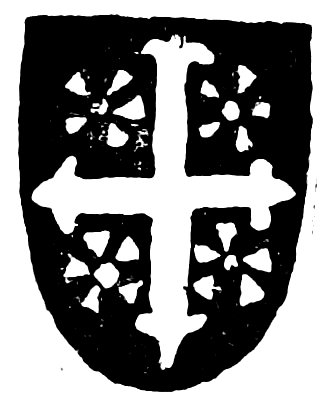
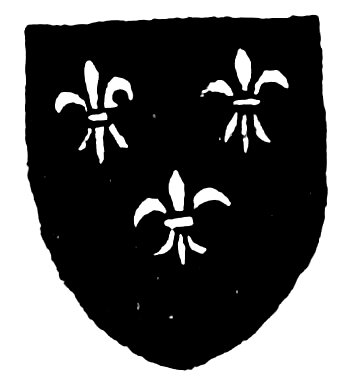
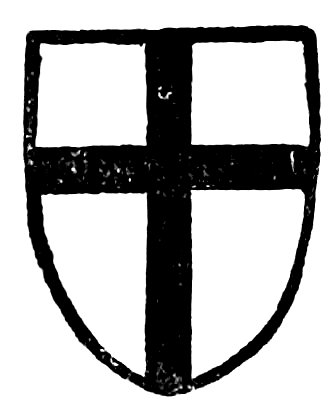
Now I turne agayne to the signe of the cros and aske a
question: how mony crossis be borne in armys. to the wich questtion
vnder a certan nowmbur I dare not answere. for crossis
innumerabuƚƚ ar borne now dayli. bot decendyng to eueri cros
the wich a fore tyme I haue seen as fer as I can I entende to
discribe. emong the wich first the playn cros shaƚƚ be discribed of
the with cros moo dowtis be made then of mony odyr crossies.
for as moch as wyse men in blasyng of armys holde for a veri
rule that ye moost begynne to blase at the lowyst poynt of the
sheelde. if the poynt be of oon coloure. and so that coloure thatt
is in the poynt of the sheelde is the felde of the armys
¶ Bot in that rule to remeue a way aƚƚ dowtis ye most merke
dyligently: that. that rule is true with a littyƚƚ addicion. yt
is to witte that in armys to be blased it is aƚƚ way to begynne
at the poynt of the sheelde: if the poynt be of oon coloure that is
true: if the coloure of the poynt be more copiose or gretter in thos
armys. and then with owte dowte ye shaƚƚ begyn ther. or ellys
not ¶ And weer the colowres be equaƚƚ ꝑtid other on length
or ouerwart then euermore ye shaƚƚ begynne to blase thoos
armys in the right side. and in that case ye shaƚƚ haue no respecte
to the poynt.
¶ And iff it be asked how berith Seynt george. it is to be
147knaw that ye most say. latine. ¶ Portat vnum
scutum de argento cum quadam cruce plana
de rubio. ¶ Gallice. Il port dargent vng cros
playn de gowlez. ¶ Anglice. He beris a felde
of Siluer with a playn cros of gowles. as here
apperith in theys armys.
And the same maner of wyse ar aƚƚ crossis hauyng a playn
cros to be blased Therfore thay er: yt say Seynt george beris
the felde of gowles with .iiij. quarteris of Siluer of whome the
resonis I lowue not. for by thoos resonis a playn cros shulde neuer
be founde in armys ner welny no differens in armys.
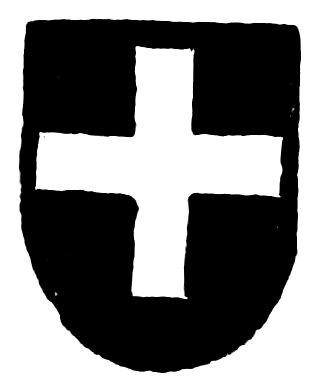
A Playn cros is founde in armys differyng from the first cros. and hit is of an equaƚƚ length on eu̇i parte as it apperith here. and theys armys be harder then the other to blase as hit is opyn. for thendys of thys cros towchis not the hemmys or the vtter parte of ye sheelde ī no parte in wich ye shaƚƚ say that he: that beris theis armys. latine. sic ¶ Ille portat de asuro cum vna cruce plana aurea equalis longitudinis ey omni parte ¶ Gallice. Il port daser vng cros playn dung longur ꝑ tont. ¶ Anglice. He berith asure with a playn golden cros of equaƚƚ length on eu̇y parte. And this is the differans in blasyng. that aƚƚ thendys of thys cros arne of equaƚƚ length the wich mai not be in the playn cros a fore. for the foote is the lengest parte. and hit be weƚƚ made. And this differens 148shaƚƚ appere bettir in a cootarmure: then it doth in a sheeld & so ther is an euydent differens be twix ye .ij. crossis aforsaid
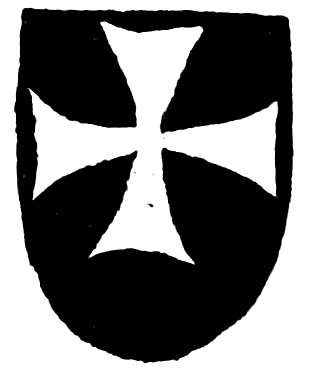
Ther is an oder cros aquaƚƚ straythyr in the myddis then in thenddys with opyn corneris as here not touchyng the vtterist parte of the sheelde in any parte ther of. and hit is calde a cros patent. And ye shaƚƚ say that he the wich beris this cros beris ī this maṅ. ¶ latine sic. Ille portat vnam crucem argentatam patentem in campo nigro. ¶ Gallice. Il port de sable vng cros patee dargent. ¶ Anglice sic. He berith Sable a cros paty of Siluer.

This cros patent is made dyuerse in the footo of the same as hit apperith here. And then hit is calde a cros patēe fixible. for ī the erth sych a cros may be pycchit. in the wich cros .iij. of the heyr partes ar opyn in the corneris and bradder thhan in the myddys. & his foote is disposid to piche ī the erthe. latine. ¶ Ille portat de rubio cum vna cruce figitiua de albo ¶ Gallice. Il port de gullis vng cros patee fiche dargent. ¶ Et anglice. He berith Gullys and a cros paty fixibiƚƚ of Siluer. And knawe ye that ther be mony crossis the wych may be maade fixibiƚƚ as hit shaƚƚ be shewd here folowyng in dyuerse.
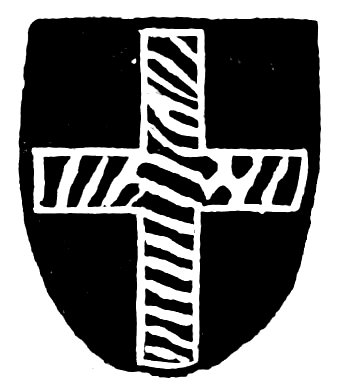
Emong odyr crossis oon is founde the wich is calde a corddid cros as here it is shewed ī this cros the wich is calde a corddid cros: for hit is made of cordys. the wich certan cros I se bott late: in tharmys of a nobuƚƚ man: the wich in very deed was summe tyme a crafty man a Roper as he hym selfe sayd. And ye shaƚƚ say of him that berith theys armys latine ¶ Ille portat gowlles cum vna cruce plana cordata de argento. Gallice sic. ¶ Il port de goullez & vng cros playn cordee dargent. Anglice sic. ¶ He berith gullis and a cros playn cordyd of Syluer.
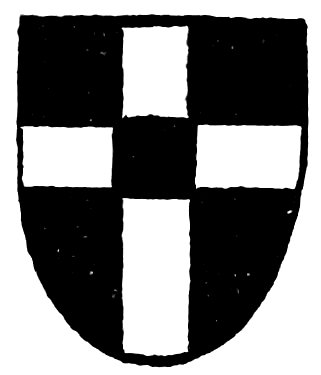
Ther is an odyr cros playn the wich meruelusly fro the playn cros of Saynt george differis. as here apperith. And here it is to be merkyd. that thoppynyon of sum men: sayng is. that theis armys be chekkerd armys. and this oppynyon is vtturli to be repreuyd for armys may not be checkerd bot at the lest in the nombur of .iiij. and in a grettyr nombur they may wele be made. as afterward shaƚƚ be shewed. Therfor it is to be said. latine sic. ¶ Ille portat vnam crucem argenteā ꝑforatam in campo nigro. Et gallice sic. ¶ Il port de Sable vng cros dargent ꝑtee. Anglice. ¶ He berith Sable and a cros perforatid of Siluer.
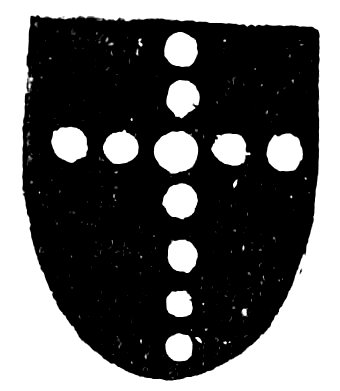
Over theis crossis we heue an odyr cros the wiche I sawe late in tharmys of a certan Ianuens as here it shewis And this is calde a besant cros for it is made aƚƚ of besanttis. and sych a cros may be made als sone with lytiƚƚ cakys as with besanttys. for besantys and lytiƚƚ cakys differ not bot in colore. for besanttis be euer of golden coloure. ne the coloure of the besant shaƚƚ be expressid in blasyng of armys. for it nedis not to say a besant of golde for ther be no besantis bot of golde Therfor it is to be sayd. latine sic. Ille portat vnam crucem talentatam in campo rubeo. Gallice sic. ¶ Il port de gowlez vng cros besauntee. Anglice sic. ¶ He berith gowles and a cros besauntid.
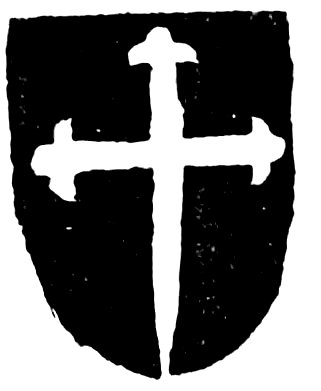
Now folowith an odyr cros flurry. the wich is so called as hit apperith here. And therfor hit is calde de florishyng cros. for hit has flouris in eueri ende vpwarde that is to say saue the foote. thys cros flurri sum tyme is borne in armys fixabuƚƚ. And then it is calde in armys a cros flurri fixabuƚƚ. for in iij. of his endys he is florishyng and in the foote pichabuƚƚ or fixabuƚƚ. Therfore it is to be sayde of him that beris hit. latine. ¶ Portat vnam cuccem auream floridam in campo asoreo. Et gallice. Il port dasor vng croys flouretee dor. Anglice. ¶ He berith asure and a cros flurri of golde.
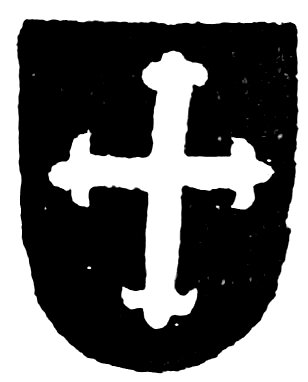
Now folowith a noḋ cros the wich is called a cros flurry patent. as here it apperith. And hit is calde a cros flurri patent for he hath his endis opyn and ī ye myddys of eueri ende apperith an other thryde in the maner of a flowre as it is opynli shewed in this cros. Therfore it shaƚƚ be sayd that the berer of theys armys: beris in this wyse as foloth first in latyn thus. ¶ Portat vnam crucem floridam patentem de auro in campo asureo. Et gallice sic. ¶ Il port dasor vng patee flouretee dor. Anglice sic. ¶ He berith asure with a cros patent flurri of golde.
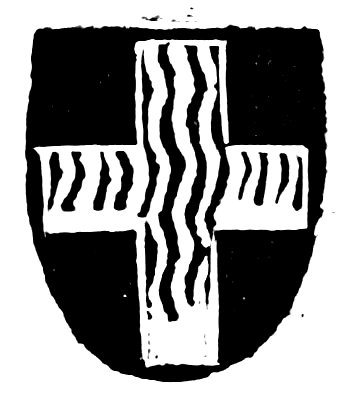
Moore ouer ye shaƚƚ vnderstonde that ther is an othere playn cros the wich certanly is calde a watery cros. and hit is calde a wateri cros for hit is made bi the maner of water trowbulled with wynde. as here hit shewys ī theys armys. Therfor he the wich berith theys armys beris in this wyse as it shaƚƚ folow first in latyn thus. ¶ Portat vnam crucem planam vndosam de argento in campo rubeo. Et gallice sic. ¶ Il port de gowlez vng cros playn vndee dargent. Anglice sic. ¶ He berith gowles and a playn wateri cros of Syluer.
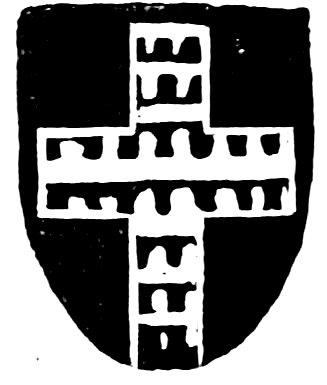
In armys also ar founde moo crossis the wich ar made of colowris inuekkyt or indentit as here in thys cros apperith And it is calde a cros inuekkyt for the cause that hit has .ij. colouris. oon put in to an other. And of him that beris theys armys ye shaƚƚ say first in latyn thus. ¶ Portat vnam crucem planam inuectam de coloribus albis & nigris in campo rubeo. Et gallice sic. ¶ Il port de gowlez vng cros playn verre dargent & sable. Anglice. ¶ He berith gowles and a cros of Siluer and Sable inuekkyt.

Yett folowith an other cros the wich es calde a cros crossit or croslet. and hit is calde crossit for ī eu̇r ende he is crossit as here apperis. Bot this cros is not so oft borne in armys by him selfe as other crossis neuer the lees mony tymys hit is borne ī dimynutiuys that is to say in littyƚƚ crossis crossit And then tharmys ar powderit with littyƚƚ crossis cruciatit. And ye shaƚƚ say thus of hym yt beris theys armys first in latyn. Ille portat vnam crucem cruciatam de argento in campo asoreo. Et gallice sic. ¶ Il port dasor vng crois croycee dargent. Anglice sic ¶ He berith asure & a cros croslet of Siluer. And whan such crossis ar borne and put ī armys as I said 153afore ī dymynutiuys &̄ wt owte any ċtan nombre then thay ar called in french Croslettys.
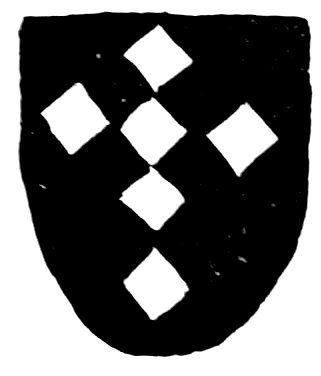
Wytt ye weƚƚ yit yt ther is an other cros the wych is called a cros masculatit as here it apperis. And this cros is called a cros masculatit for he is made of masculys of the wich certan masculis ye shaƚƚ se afterward in the chapitur of fusyllis mascult: and losyngys where this mater shaƚƚ be moor playnli tretit. And he that beris thys armys beris as it is shewed here after. first in latyn thus. ¶ Portat vnam crucem masculatam de argento in campo asereo. Et gallice sic. ¶ Il port dasor vng cros masculee dargent. Anglice sic. He berith asure and a cros masculatit of Syluer.
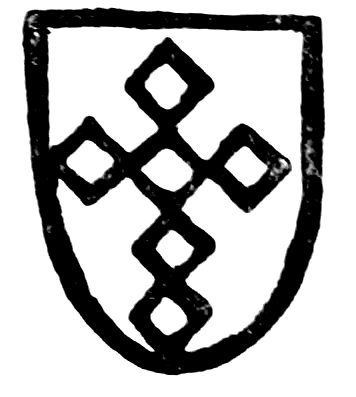
Be it knowe: that thys cros masculatit sum tyme is ꝑforatit. in the masculys as it is opyn in the persyng he e folowyng. And thus ye most blase hym. first in latyn in thys wyse. Ille portat vnam crucem masculatam perforatam de rubeo in scuto argenteo. Et gallice sic. ¶ Il port dargent vng cros de gullez mascule ꝑsee. Anglice sic. ¶ He berith Siluer with a cros of gowles masculatit persit.
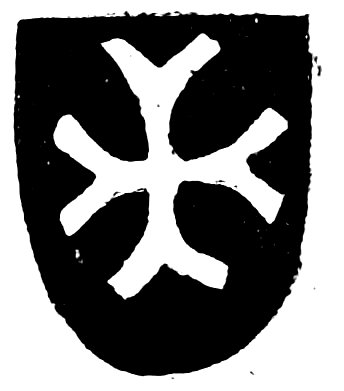
Here folowis an other cros the wich is calde the cros of a milne for hit is made to the simylitude of a ċtan īstrument of yrne in mylnys the wich berith the mylne ston by the wich īstrument: that ston in his cors is borne equally that he declyne not ouer myche on the right ꝑte ner on the lefte parte. bot mynisteryng to eueri parte that: that is his equally and with owte frawde. And thys is geuyn to Iugis to bere in theyr armys: and to thos that haue Iurisdiction vnder theym. That is to say as the forsayd īstrumēt is directe: to the mylne stone equalli and with owte gyle. So thos Iuges ar bondyn to gyffe equalli to eueri man his right. And it is to be sayd yt the possessor of theis army beris ī this wyse. first ī latyn thus. ¶ Portat vnam crucem molēdinarem argenteam in campo rubeo. Et iam gallice. ¶ Il port gowlez vng cros moleyne dargent. Anglice. He berith gowlles and a mylneris cros of Syluer.
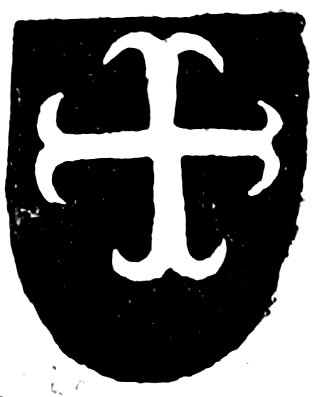
Certan we haue a cros the wich is calde a cros turnyt agayn. and this cros is calde retornyt: for the cause yt thendys of this cros on eueri side ar retornytt agayn bi the maner of a Rāmys horne. And he that beris theis armys beris ī this wise first in latyn thus. Portat vnam crucem auream īu̇sam in scuto asureo. Gallice sic. ¶ Il port dasor vng cros recercilee dor. Anglice sic. ¶ He beris asure with a cros reuersit of golde.
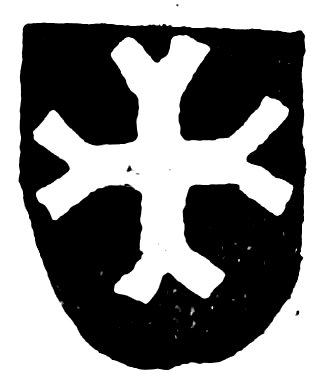
Under stande ye that ther be other men the wich beer in theyr armys a certan forkyd cros as thys is. And hit is called forkyd: for as moch as that aƚƚ thendys of hit ar clouyn and forkyd. Therfore hit shaƚƚ be sayd of thos men that berit theys armys in this whise. primo latine. ¶ Portat vnam crucem furcatam de auro in campo asereo. Gallice. Il port dasor vng cros dor. Anglice. ¶ He berith asure with a cros forkyd of golde
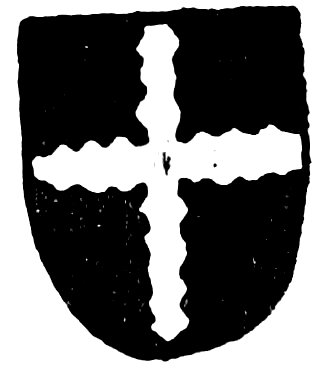
Also ther be certayn nobuƚƚ men the wich beer a cros engradyd
or engraylid. as it apperis here folowyng And
hit is calde a cros engraylid for hit is not playne
in ony parte of him bot engraylid also weƚƚ
ouer his length as ouer his breed. Neuer the
lees this engraylyng is no propur langage aftir
the sight of thys cros: bot rather an endentyng
as truth is Bot it is the comune maner of spekyng
in theys armys. Therfore ye most say as I sayd a fore.
And ye shaƚƚ say of him that beris theys armys in thys wyse.
First in latyne thus. Portat vnam crucem ingradatam
de albo in campo rubeo. Et iam Gallice.
¶ Il port de gullys vng cros ingral dargent. Anglice
¶ He beris gowlys and a cros ingrayled of Syluer.
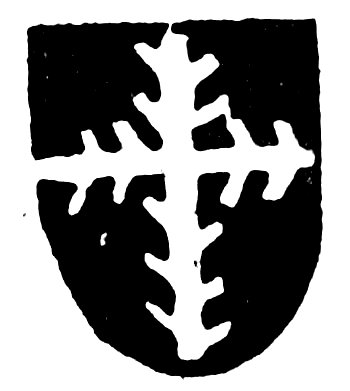
I Fynde yet an othyr cros: the wich is borne mony timys ī tharmys of nobuƚƚ men. the wich is calde a cros trūcatid. And hit is calde trunkatid for hit is made of .ij. treys the boys cut a way. as here. Therfore it is to be sayd that the possessor of theys armys beris in latine thus. ¶ Portat vnam crucem truncatam de argento in campo rubeo. Et gallice. Il port de gullez vng cros recopee dargent. Anglice. ¶ He berith gowles with a cros trunkatid of Siluer.
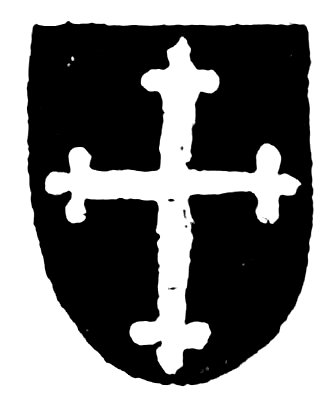
Knowe ye yit after theys crossis ther is an other cros the wiche is calde a knotty cros: the wich ī certan is calde so for hit has in eu̇y ende certan knottis. as here. And it is to be sayde of hym that beris theys armys in thys wyse. Primo latine. Ipse portat vnam crucem auream nodulatam ī scuto asoreo. Et gallice. ¶ Il port dasor vng cros botone dor. Anglice. ¶ He beris asure with a cros knotty of goolde.
And thys cros is founde other while pycche or figityue ī armys. and then his foote is figityue as I sayd a fore.
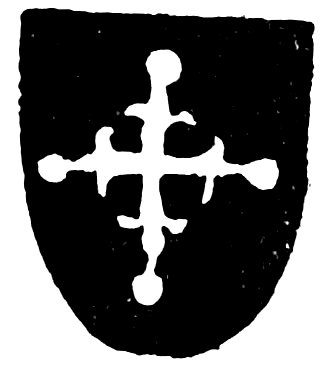
Over thies crossis we haue a certan cros flurri of the wiche it is spokyn a foore. the wiche cros flurri is founde knotty as here. And that is as I soyd a foore whan knottys ar founde ī thendys and the anglis of the sayd cros. And the berer of the sayd armys latine. ¶ Portat vnam crucem nodulatam floridam aurream in campo de asuro. Et gallice sic ¶ Il port dasor vng cros floretee botone dor. Anglice. ¶ He berith asure and a cros flurri knotty of golde.
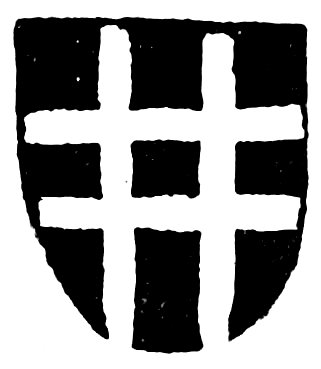
A Cros dowbuƚƚ is founde in the armys of dyuerse nobuƚƚ men the wych certan cros is calde a dowbuƚƚ ꝑtitid cros. For if it be deuydid or partid after the long way or the brode way yit ther a bydys on dowbuƚƚ cros as we may se here. Yit I haue seen many nobuƚƚ men dowttyng of thys cros moore then of any cros a fore said: the wich neuer the lees aftir long disputacionis in thoppynion a foresayd restid and concludid. Therfore he that beris theys armys. latine sic. ¶ Portat vnam crucem duplicatam argenteam in campo nigro. Gallice sic. ¶ Il port sable vng cros dowble petie dargent. Anglice sic. ¶ He berith Sable and a cros dowble pertitid of Siluer.
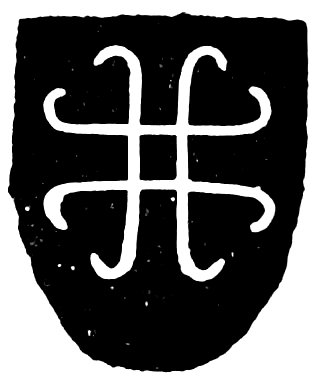
This cros dowble ꝑtitid is varied sum timys. and then hit is called a cros dowble partitid florishid. as here. Neuertheles hit is calde a cros flurri inpropurli as sum men sayen for hit faylith the myddys of that flowre as a noon hit shaƚƚ folow in the next armys. the wich certan myddys by no maner of wyse in that cros dowble ꝑtitid may be. as a noon it shaƚƚ be shewed. Bot he that berith theis armis latine. ¶ Portat vnam crucem duplam ꝑtitam auream in campo rubeo. Gallice. ¶ Il port de gowlez vng cros double ꝑtie floretee dor. Anglice. ¶ He berith gowles and a cros dowble ꝑtitid flurri of golde.
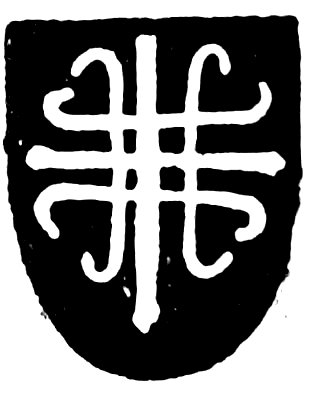
Bot as is shewed a fore this cros is calde a cros dowble ꝑtitid florisħid for ther faylith the myddys of the cros by the wich the cros florishid is made ꝑfite. as here hit is opyn. the wich certan myddys putt ther to it shaƚƚ not be called a cros dowble ꝑtitid florished Bot rathir it shaƚƚ be calde a cros threfolde ꝑtitid flurri. And then it is weƚƚ blased. for and it be dyuidid after the longnes or after the brodenes. aƚƚ way oon parte shaƚƚ a byde triꝑtitid in the myddis of the cros as it is opyn ī tharmys a fore writtyn. And therfore he that berith theis armis. latine. ¶ Portat vnā crucē triꝑtitā de argēo ī cāpo de asuro. Gallice. ¶ Il port daser vng cros trefoys ꝑtee floretee dargent. Anglice sic. ¶ He berith of asure with a cros triꝑtitid floree of Siluer.

A dowte theer is yit of a certayn shadow of a mylnerys cros as it shewith here folowyng. And knaw ye that it is called a shadow of a cros for euermore thys shadow is made of blacke coloure. of what sum euer coloure the felde be of. the shadow is made of blacke. and the bodi of the same shadow is of ye same coloure with the felde. ¶ And he that berith theys armys. latine. Portat vnam crucem vmbratam in campo aureo. ¶ Gallice sic. Il port dor vng cros moleyne vmbre. ¶ Anglice. He berith of golde with a mylneris cros vmbratid or shadowyd.
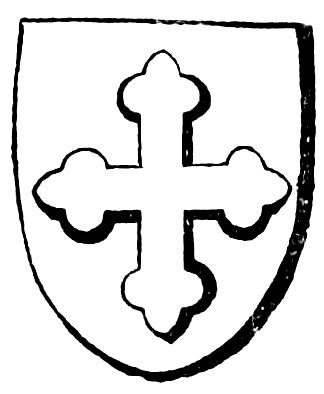
Another sampuƚƚ is sene of the vmbracion of a certayn cros. and thys cros is calde a cros floree vmbratid as apperith here. bot truly spekyng and propurli it is no cros: bott a shadow of such a cros. and the reson is. for the bodi of the said shadow is of the same coloure with the felde. And so the colore that is in the felde shewith by aƚƚ the body of the sayd shadow. ¶ And thoo that beer thes armys. latine. Portant vnam crucē floridam patentem vmbratam in campo rubeo ¶ Gallice sic. Il port de gowlez vng cros patee floritee vmbre ¶ Anglice sic. He berith of gowles and a cros potent flore vmbratyd.
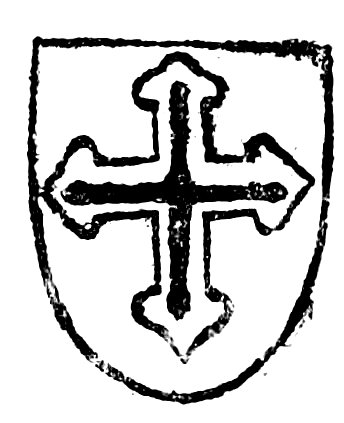
Neuertheles after sum men thys shadoyd cros other wyle
is persid maruelusly as hit folowith here and than hit
is calde a cros floori patent vmbratyd and perforatid
for hit accordis with the croos precedyng
exceppid the persyng in the myddys of the sayd shadoo.
¶ And then hit shaƚƚ be sayd that he
the wiche berith this cros. latine. Portat vnā
crucem floridam patentem vmbratam perforatam
cum rubio in campo aureo
¶ Et gallice sic Il port dor vng croys patee florotee vmbre
& partee de gowlez.
¶ Anglice He berith of golde a cros patent flurri shadoyd &
persyd with gowles.
Blaseris moost be ware of theis armys vmbratid of the wich: mony rewles be shewed a fore. Bot for the blasyng of theis certan armys sum ignorant men of thys crafte take the rule goyng a fore that is to wite of the colowris transmutid as ye saw a fore Bot ther be certan nobuls and gentilmen in englonde the wich beere shadoys diuerse in theyr armys as Lyon Antlop and other. and they that bere theys armis and hit be a lyon ye shaƚƚ sai in latyn ¶ Portat vnum leonē vmbratam in campo aureo ¶ Gallice. Il port dor et vng leon vmbree. ¶ Anglice. He beerith of golde and a lyon vmbratid. ¶ And men say that suche ꝑsonys as beer theys vmbratid armys had there ꝓgenitoris beryng the same not vmbratid bot hole Bot the possessionis & the patrimonyes descendid to other men. then the Neuoys or Kynnysmen leuyng in goode hoope and trustyng to haue the possessionis of their ꝓgenitoris: beer their armys vmbratid. aƚƚ oder differens a fore said leuīg. 161for when they haue that patrimony: that thai trustit oon. soon thay may beer that lion or other beest of the same coloure the wiche theyr progenytoris bare. and it is bettyr to beer thos armis vmbratit then hoolly to leeff theyr progenitouris armys.
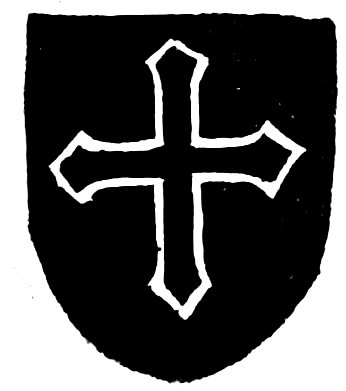
A Gret dowte yit remaynys a nendys blaseris of armys ī dyfferens be twix thys cros fimbriatit or borderit. as here now apperis and the forsayd cros vmbratit. in so moch that they are mych like. and it apperis in the first sight that they be bot oon. bot and a man beholde weƚƚ ther is a gret differens. for the bordir of thys cros is variet as weƚƚ fro the coloure of the cros as fro the coloure of the felde. and elles is ther no dowte. Therfore it shaƚƚ be sayde of hym that beris theys armys in thys wyse first in latyn thus. Portat vnam crucem nigram perforatam floridam patentem fimbriatam siue borduratam cum argento in campo rubeo. Gallice sic. ¶ Il port de gullez vng crois flouretee patee percee de sabuƚƚ bordure dargent. Anglice sic. ¶ He berith goules with a cros flurri patent persit of Sable borderit wt Silu̇.
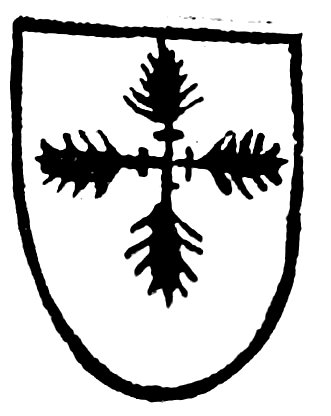
For certan ther is an Ermyn cros. & hitt is a meruelus cros of ye wich ther was a disputacion at london by a certan herrowde of Bretan. And it was determynyt that theys armys may be in non other coloure bot as here it apperis And thys cros is calde an Ermyn cros. and it 162shaƚƚ be sayd of him that beris theys armys in thys wyse as it shaƚƚ folow. first in latyn thus. ¶ Portat vnam crucem ereminalem. Et gallice sic. ¶ Il port vng croys Eremmee Anglice sic. ¶ He berith a cros ermyn And here ye moost note that the coloure ī theys armys shaƚƚ not be expressit for this cros ner theis armis may not be made bot of theys colouris that is to say allone of blacke and white the wich ar the propur coloris of theys armys.
Sufficientli is spokyn of crossis afore. now folowis an odir treteys of dyuerse armys quarteryt as here shaƚƚ be shewyt.
Off armys quarterit sum ar armis quarterit playn Sum quarterit engradit. Sum quarterit irrasit. Sum quarterit inueckyt. Sum quarterit indentit of the wich it shaƚƚ be spokyn euerich oon after other. and first of tharmys playn
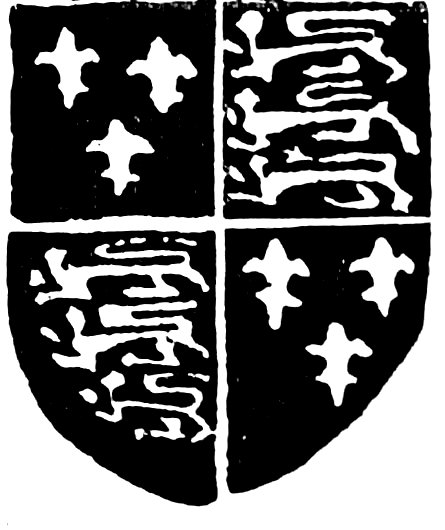
Thre maner of wyse armys may be quarterit. The first maner is opyn whan .ij. dyuerse armys ar borne quarterli as it is opyn and playn in tharmys of the kyng of Fraunce & of Englond And ye shaƚƚ say of hym yt beris theys armys thus as folowys. first ī latyn. Ille portat arma regis Francie & Anglie qurteriata. Et gallice sic. ¶ Il Port lez armes de Francee et dangleterre quarteles. Anglice sic. ¶ He beris tharmys of France & Englonde quarterli. 163And it shaƚƚ not be tedeus to no man that Fraunce is put before Englonde ī blasyng. bot the cause is this. for tharm̄ys of Fraunce in armys be put afore and we haue a gen̄aƚƚ rule yt whensumeu̇ in armys be .ij. colouris or moo ī the poynt of the shelde. then ye shaƚƚ not begyn at the poynt to blase them. bot in the right ꝑte or side of thos armys. that same coloure ther founde ī the right side of ye shelde is not the felde of tharmis. for it mai fortune it is not the gretist coloure ī tharmys aforsayd bot les or with othir equaƚƚ. and neu̇ the les ye shaƚƚ begyn to blase ther.
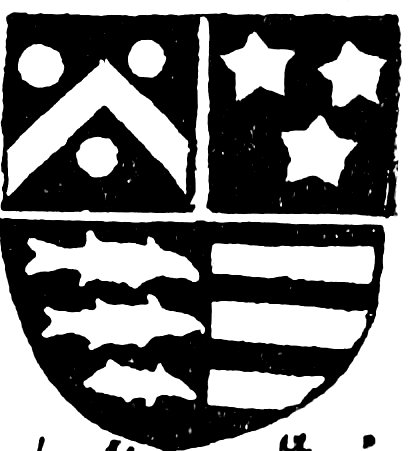
The secūde maner of wyse of beryng quarterit armys is
when .iiij. diu̇se armys quartli be borne as here is shewyt
And he that beris theys armys: beris .iiij. diu̇se
armys quartli. latine sic. Ille portat quatuor
arma diu̇sa quartiata. Gallice sic.
¶ Il port quarter armes diu̇sez quarteleez.
Anglice sic He berith .iiij. armys diu̇se
quartli. And then if it be askyt how theys armys
shulde be blasit. The blaser most begyn ī the heyst corneƚƚ ou̇
the right side ꝓcedyng to eu̇y armys. tharmys in the right side
blasit: ye most go to the odir side & then to the thirde side & afṫ to
the last. And ye most know that theys armys rehersit afore be
playn armys quarterit.
Ther is an othir man̄ of beryng of armys quarṫit when ij armis
quarterit be borne quart̄li. and it is borne most ī armis of
quenys and so bare that noble quene of Englond quene Anna
wyfe to that royaƚƚ prince Kyng Richard the secunde: the wiche
bare tharmes of Englond &̄ of Fraunce and of themꝑor of Almayn
quarṫli & in .xvi. ꝑtes. that is to say in the right side of
164the shelde in the first quarter she bare tharmys of fraunce .iij. floredelucis
of golde ī a felde of asure. & ī the secunde quarṫ .iij Libartis
of golde ī a felde of gowles. & ī ye thirde quarṫ an Egle
splayd wt .ij. neckis. & ī the .iiij. a blake Lyon rampyng ī a felde
of Silu̇. and so chaungeably she bare theys armys in .xvi.
quarteris the wich seldyn is seen in any armys.
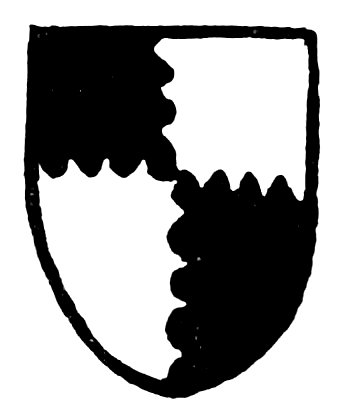
Now I shew yow yt sum time we haue armys quarterit &̄ engraylit. that is to witt whan eu̇y armys ī his quarṫ is engraylit as here apperis. & it shaƚƚ be sayd of him yt beris theis army thus. first ī latyn ¶ Ille portat de auro & rubio arma quarteriata & ingradata. Et gallice sic. ¶ Il port dor et gowlez quartlee engreylee. Anglice sic ¶ He berith of golde &̄ gewles quarteriy engraylit. And thei ar calde armys engradit for they ar made of .ij. colouris the wich graditly ar broght to gedir oon coloure in to an other coloure
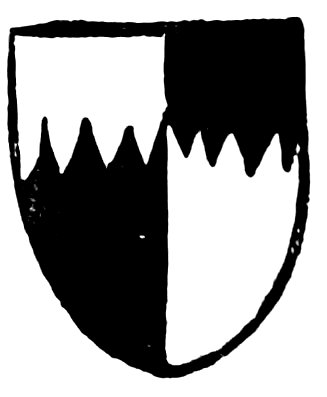
Certan armys ther be quarterit and irrasit as here apperis. the wich ċtan armys ar called quarterit armys irrasit. for the colouris be rasit owt as oon coloure ī rasyng ware take away from an othir. And it shaƚƚ be sayd of him yt beris theis armys in latyn thus. Portat arma quarteriata irrasa de albo & nigro. Gallice sic ¶ Il port dargent et Sable quartlee irrase. Anglice sic. ¶ He beris Siluer and Sable quarterely irrasyd.
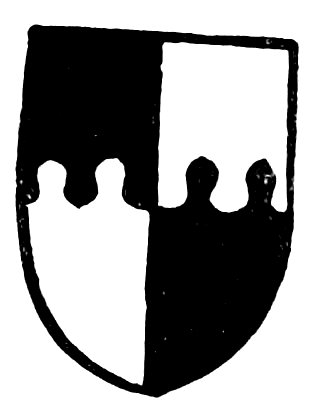
Ther be yet fownde armys quarṫli inueckyt. or as sum men say they be army quarterit of colowris inueckyt as here apperis. the wich for soth ar calde armis quarterit īueckit or of colowrus inueckyt. for ī them ar .ij. colouris quarṫli put: ye toon ī to the othir. & so oon colowre is īuehit ī to an othir. Therfore it is said of hī yt beris theis armys ī this wise. first ī latyn thus Ille portat quarṫiatim de asurio et auro īuectis Et gallice sic. ¶ Il port quartli verre dasor et dor. Anglice sic. ¶ He berith quarṫli inueckyt of asure and golde.
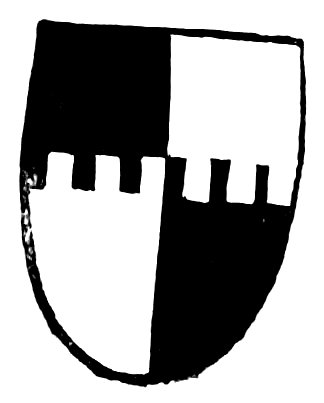
Qvarterit armys be founde diuerse the wych ar calde indentit as here apperis: and they are calde indentit for .ij. colowris oon in to an othir by the maṅ of teth ar indentit: as is opyn ī the shelde. And thus ye shaƚƚ blase theym first in laty. Portat arma quarteriata īdentata de rubio et auro. Gallice sic. Il port quartertlee endentlee de gowlez et dor. Anglice. ¶ He berith quarṫli endentit of gowles and golde.
I intende now to detmyn of armys partit after the longe way the wich ċtan partyng aft the long way or on length is made many maṅ of wyse. ¶ The first ꝑticion for soth is 166of .ij colouris in armys after the long way in the playne man̄
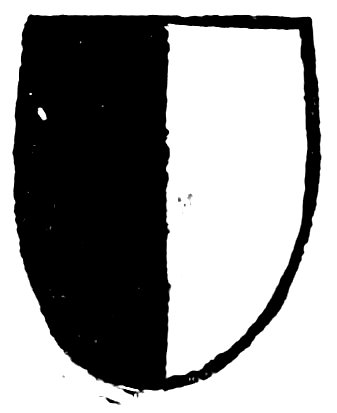
Fyrst I shewyd to yow that ther be certan armys partit after the long way of .ij. colowris in the playn way as here apperis ī theys armys. And they ar calde ꝑtit armys for they be made of .ij. colouris equalli ꝑtit. And he that beris theis armys beris thꝰ ī latyn. Ille portat arma partita plana secundum longum de asorio et albo. Gallice sic. ¶ Il port dasor et dargent playn ꝑtee. Anglice sic. He berith asure and Syluer playn ꝑtit.
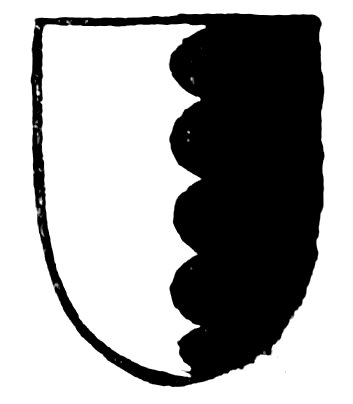
Also ther is ꝑticion of armys engralyt the long way as is said a fore bi engraylyng of .ij. colouris to gedir as here apperis. And theys armys ar calde armys engraylyt ꝑtit after the long way of siluer and Sable. And it shaƚƚ be sayd of him that berith thes armys ī latyn thus. Portat arma ꝑtita secundum longum īgradata de argento et nigro. Gallice sic ¶ Il port dargent ingraylee et Sable ꝑtee du long. Anglice sic He berith Syluer and Sable ingraylyt ꝑtit after the long way.
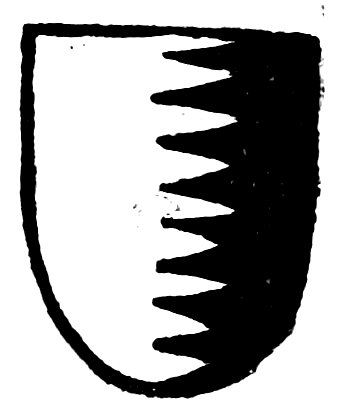
The thrid maner of wise ar founde armys partit of .ij. colowris & irrasit as here. of the wich it is to be sayd: as afore of quarterit armys irrasit. And he that beris theys armys: beris in this wyse as folowys first in latyn thus. Portat arma ꝑtita secundū longum irrasa de argento et rubio. Gallice sic. ¶ Il port ꝑtee du long dargent et de gowlez race Anglice sic. ¶ He berith armys partit on length of Siluer and gowles irrasit.
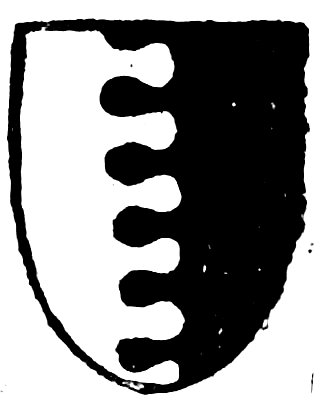
Also the fourith maner of wyse: armys partit ar borne after the longe way of .ij. colouris inueckyt as here apperis And theis armys be calde inueckyt for the colowris be put oon in to an othir on rounde wyse. And theys armys differ moch fro tharmys next beyng afore irrasit. Wherfore it shaƚƚ be sayd of hym the which beris theys armys thus as it shaƚƚ folow first in latyn thus. Ipse portat arma partita secundum longum de coloribus albo et rubio inuectis Gallice sic. ¶ Il port partee verre du long dargent et de gowlez. Anglice sic He berith partit inueckyt on lengthe of Siluer and gowles.
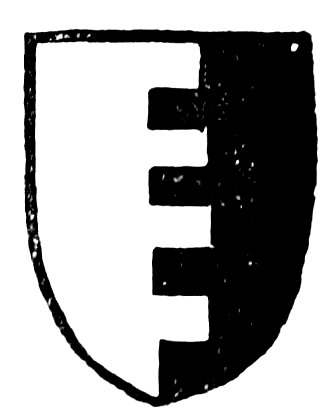
Sotheli an othir maner of partyt armys ther is the wiche is calde the fyfthe maner partyt after the long way of .ii. colouris and theys armys ar called partytt indentytt. for thys cause that .ij. diu̇se colowris ar put to gethir: that is to say white and blac ar put to geḋ aft the maṅ of mēnis tethe as it is sayd afore in the quarterit armys indentyt. And therfore ye shaƚƚ say of hym the wich beris theys armys in thys wyse. first in latyn thus. Portat arma partita secundum longum de argento et nigro indentata. Gallice sic. Il port partee endentee du long dargent & sable Et anglice sic. ¶ He berith armys ꝑtit indentit on length of Syluer and Sable.
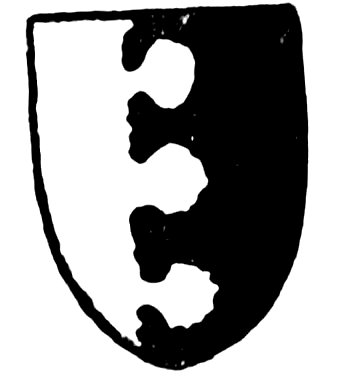
In the sext maṅ of wyse ther be armys borne partyt aft the long way nebulatyt as here it shaƚƚ be shewyd in this scochon. And theys armys be calde innebulatyd for .ij colowris ar put to gedre by the manere of clowdys. Therfore the possessor of theys armys beris in thys wyse as it shaƚƚ be sayd first ī latyn thus. Portat arma partita secundum longum de argento et asorio innebulata. Et gallice sic. ¶ Il port ꝑtie du long dargent & dasor innevve. Anglice sic. ¶ He beris armys partytt on length of Siluer and asure innebulatyt.

More ouer aft theys armys aforesayd yit ther be borne armys partyt after the longe way. and they be watteri as here in this scochon it apperith. and theys armis ar calde watteri: for .ij. colowris ar incariet oon in to an other by the maner of water trobulde wt wynde. And ye shaƚƚ say of him that beris theis armys in thys wyse as folowys: first in latyn. ¶ Portat arma ꝑtyta vndosa secundum longū de argento et rubio. Gallice sic. ¶ Il port ꝑtiee du long dargent et de gowlez vndee. Et anglice sic. ¶ He berith armys partyt the long way of Syluer and gowles watteri
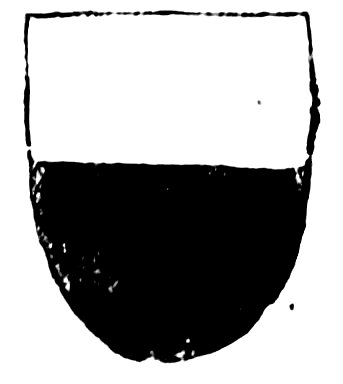
Here now folowys to se of armys ꝑtyt ouerwart. the wich certan particion ouerwart is made as mony wyse as is the ꝑtycion on length. that is to say on the playn way ouerwart. ingraylyt. irrasit. inueckyt. indentit. innebulatit. and watteri Werfore of theys certayn shaƚƚ be shewyd by signys. and first I begyne at playn armys ou̇wart. as here it shaƚƚ be shewyd. And it shaƚƚ be sayd of hym that berithe theys army in thys wyse first in latyn thus. ¶ Portat arma partita extransu̇so plana de auro & asorio. Et gallice sic. ¶ Il port ꝑtiee transu̇sie dor & dasor. Anglice sic. He berith golde and asure ꝑtit ou̇wart ¶ Knaw ye that here is no dowte of that first rule: that is to say that a man shaƚƚ begyn at the poynt of the shelde to blase for here is as mych coloure of golde as of asure.
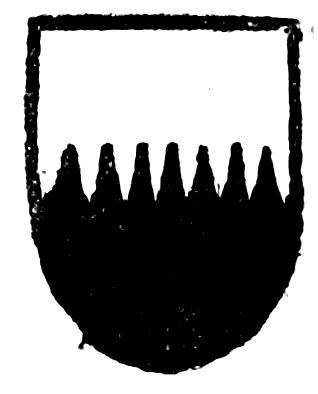
Now of a nothir maner of partycion of colouris in armis ou̇warte I wiƚƚ speke. And it is calde irrasit as here it shaƚƚ appere in this scochion. of the wich it is to be sayd that the gentyƚƚ man the wich beris theys armys beris in this maner as folowis. first in latyn thus. ¶ Portat arma partita extransu̇so irrasa de auro et rubio. Et gallice sic. ¶ Il port partiee transuerse irrase dor et gowlez. Anglice sic. ¶ He berith armys partyt ouerwart irrasyt of golde and gowles.
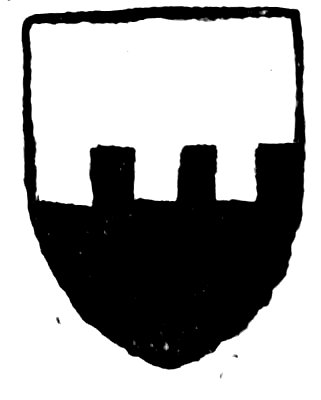
Armys ther be also īdentyd ou̇wart and partyt. And they be calde indentyd for theyre colowris as is sayd afore ar put oon in to an othir bi the maner of mennis tethe. And it shaƚƚ be sayd of him that beris theys armys in thys wyse. first in latyn thus.
Portat arma ꝑtita extransu̇so īdentata de auro et asorio as afore is rehersit. Et gallice sic.
Il port ꝑtiee de trauers dor et dasor endentee. Anglice sic ¶ He berith armys ꝑtyt ou̇warte indentytt of golde and asure
And to reherse moore of ꝑtyt armys ou̇warte it nedisnot for it is rehersyt sufficientli in the rules next afore ī armys ꝑtyt on lengthe. Therfore it shaƚƚ not be rehersytt here agayn. quia inutilis est repeticio vnius ad eiusdem. and that is to say 171It is an vnꝓfitabuƚƚ rehersyng of oon thyng to reherse the saame a gayn in the next sentans. Therfore to speke moore of armys partit and figure theym: other of ingraylit or irrasit inueckyt indentit nebulatyt and vndatyt: it nedys not. for they be taght sufficiently ī the long way. ¶ And I beleue it shaƚƚ be hard to fynde mony moo armys ꝑtyt afṫ the long way or ou̇wart then ar rehersit a fore Neu̇ the lees if any be founde or sene. in theym the same rules shaƚƚ be obseruit: as is rehersit a fore. and it is enogh for aƚƚ armys on that man̄ to be blasit that any gentyƚƚ man berith ꝑtyt.
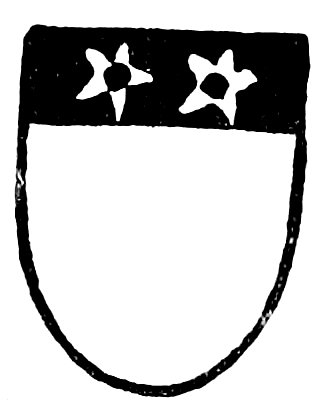
Sotheli certan men wolde: yt theys armys after rehersitt shulde be calde armys ꝑtyt. the wich certanli ir rfor yt: that ther is no verri ꝑticion of the colouris or any liclenes of dyuision of colouris. Certanly in armys ꝑtit it is requyrit alway that the ꝑtys of the colouris be equaƚƚ. and that is not trew in this figure. for the moore ꝑte by mych is Siluer. Therfore ye shaƚƚ say of him that beris theys armys thꝰ first in latyn. ¶ Portat de argento et caput scutti de asorio cū duabus maculis ꝑforatis de auro. Gallice sic. ¶ Il port dargent vng cheiff dasor et deux molettis ꝑtees dor. Et anglice sic. ¶ He berith Siluer a Cheiff or a Cheftan of asure and ij. molettys ꝑforat of golde.

¶ And ye shaƚƚ knaw that ī theys armys the rule afore wretyn most be considerit that is to say: that at the Coon it is to begyn to blase if that colowre of the Coon be gretter or more copyous coloure in armys as it is sayd afore And more ouer it is to be merkyt that no armis awe to be calde ꝑtyt armis bot iff they be made of .ij. colouris onys partit and no more for armys palit ar not callit: nor awe not to be calde partyt armys aƚƚ thogh they be made of ij. colouris for thes colowris not allonli onys bot dyuerse tymys ar partyt as here apperis And theys armys be calde palit armys for they be made bi the maṅ of palis. And it shaƚƚ be sayd of hym that beris theys armys ī latyn thus. Portat arma palata de auro et asorio. Gallice sic. ¶ Il port pale dor et dasor. Anglice sic. ¶ He berith pale of golde and asure.
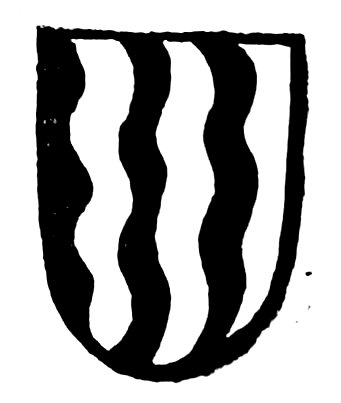
Palyt armys oftyme ar founde vndatyt that is to say watteri as here apperis. And theys be calde polyt armys vndatyt to the differance of barrit armys vndatyt. the wich armys barrit may also be vndatyt as after shaƚƚ be shewyt. And it shaƚƚ be sayd of him that beris theys armys thus in latyn Portat arma palata vndata vel vndosa de rubio et argēto. Et gallice sic. ¶ Il port polee vndee de gowlez et dargent. Et anglice sic. ¶ He berith paly vndatyt of gowles and Siluer.
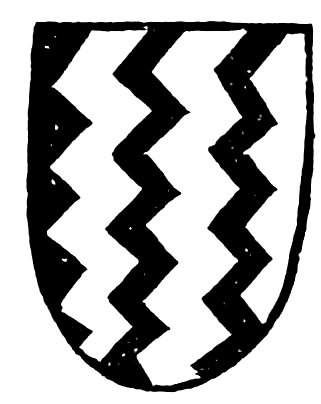
Loke and beholde how mony maner of wyse thes palit armys be borne dyuerseli. as it is shewyt in thys boke. and theis armys now shewyt here: be calde palit crokyt and sharpe. for in theys armys .ij. coloris paly ar put to gethir: oon in to an othir crokytly and sharpe. Therfore it shaƚƚ be sayd of hī the wich beris thes armis in thys wyse. first ī latyn thus. ¶ Portat arma palata tortuosa acuta de nigro et argento. Gallice sic. ¶ Il port pale daunsete de Sable et dargent. Anglice sic. ¶ He berith pale crokyt and sharpe of Sable and Syluer.
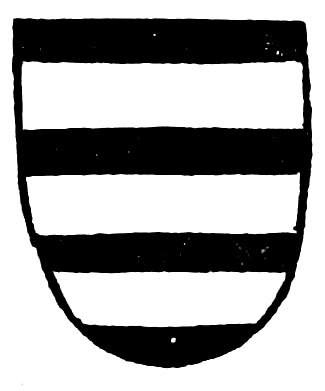
Here ī thys chapyture afore is determynyt of palit armis and in thys chapyture now folowyng it shaƚƚ be determynyt of barrit armys. for the wich it shaƚƚ be know that armys may be mony maner of wyse barrit. and the first maner of wyse is playn barrit. as here apperis. And ye shaƚƚ know that ther be certan armys barrit playn. and then ye shaƚƚ nott nede to say ī the blasyng of theys armys: he berith playne armys barrit. Bot ī aƚƚ othyr disperyng armys barrit: ye most nedys declare the blasyng of theym howe thoos barrit armys differ from playn. for sū be barrit wt a Lyon raumpyng or a grehonde or odir beestis &̄ sū be barrit & 174powderit with cros croslettys molettys Scresentis smale briddis or other difference bot as for theys playn armis afore ye shal say in latyn in thys wyse. Portat arma barrata de argento & nigro Et gallice sic. ¶ Il port barre dargent et Sable. Anglice sic. ¶ He berith barri of Siluer and Sable
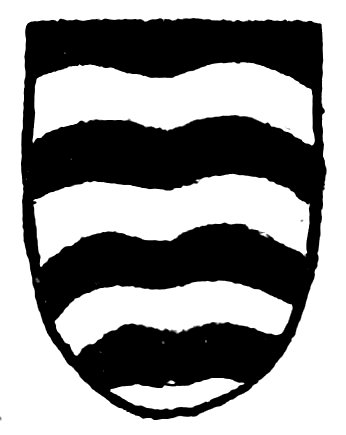
Knaw ye for ċtan that armys barrit othir wile be barrit &̄ vndatit that is to say wateri. as here it apperith. And they be called barrit vndatit for they be made of .ij. colouris metyng to gedre by the maner of a floyng watre as it is opyn afore. And ye shaƚƚ say of hym that beris theis armys ī this wyse. first ī latyn thus ¶ Portat arma barrata vndata de nigro et albo Gallice sic. ¶ Il port barri vndee de Sable et dargent. Anglice sic. ¶ He beris barri vndatit of Sable and Siluer.

Barrit armys inueckyt ar borne of diuerse gentiƚƚ men.
as here is shewyd. And thay ar called inueckyt for in
eueri barre .ij. colouris ar put inueckyt by the maner
of a rounde way as is sayd afore. And he yt
beris this armys beris in thys wyse. first in latyn
thus. ¶ Portat arma barrata de coloribus
rubeo et albo inuectis. Et gallice sic.
¶ Il port barri verree de gowlez et dargent.
Anglice sic. ¶ He berith barri inuetkyt of gowles and Siluer.
¶ And I begyn with gowles for that coloure is the
first in the right corneƚƚ.
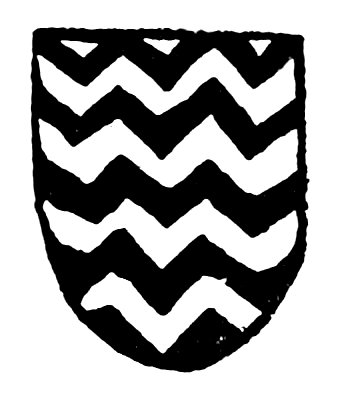
Gentill men ther be certanli the wich bere armis barrid crokyt and sharpe as here it apperith in theys armys. and thay be called armys barrit for differance of armys the same maṅ of wyse palit: and thay be called crokyt and sharpe. for as it is sayd a fore .ij colowris ar put to gethyr crokytli and sharpe. Thefore it shaƚƚ be sayd that the lorde the wich beris theys armys berith in this wyse. first ī latyn Ille portat arma barrata tortuosa et acuta de nigro et auro. Et gallice sic ¶ Il port barri dauncetee acute de Sable et dor Anglice sic. ¶ He berith barris crokyt and sharpe of Sable and golde.
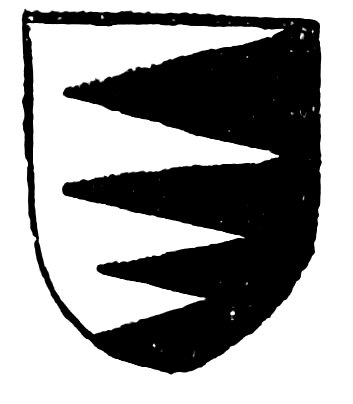
Ther be forsothe certan armys bendli barrit. and thei be called
bendly barrit. and for this cause they be calde bendly
barrit. for .ij. colouris ar iunyt to gether in euery
barre bendly. as it is opyn here ī theis armis
And therfore it shaƚƚ be sayd of him that beris
theis armys: in this wyse as folowis. first in latyn
thus. ¶ Ipse portat arma bendaria de rubio
et auro. Et gallice sic. ¶ Il port barre
bendee de gowlez et dor. Anglice sic. ¶ He berith barri
bendy of gowles and golde.
176
¶ Bot neuer the lees ye most dyltgentli attende in the blasyng
of sych armys: as palyt barrit and bendyt. for and they ben
not suttelly consauyt a man sodanly onsweryng may lightly in
thoos armys be dissayuyt. For certanly thoos armys be callede
palyt armys in the wich ar fownde so many palys of oon colowre
as ar of an other. And iff the palys of bothe the colowris ben
not equaƚƚ thoos armys be not palyt.
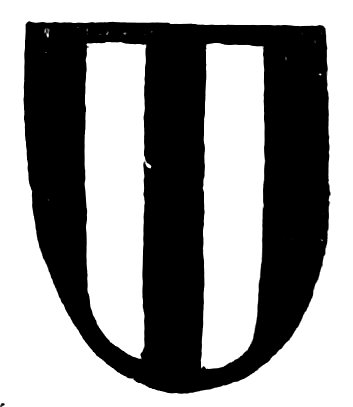
¶ In diuerse armys of gentiƚƚ men be fownde .ij. palis of oon colowre. and .iij. of an other as here in theis armys folowyng it shaƚƚ be shewed. that is to say ther be .iij. palys of gowles and .ij. of golde for of the colowre of reede apperith .iij. partes in the shelde and bot ij. allone of the colowre of golde Therfore the gētiƚƚ man that berith theis armys: beris ī this wise & thus ye shaƚƚ say of him. first in latyn thus. Portat duos palos aureos in campo rubeo. Et gallice sic. ¶ Il port de gowllez et deux pales dor. Et anglice sic. He berith gowlys and .ij. palis of golde.
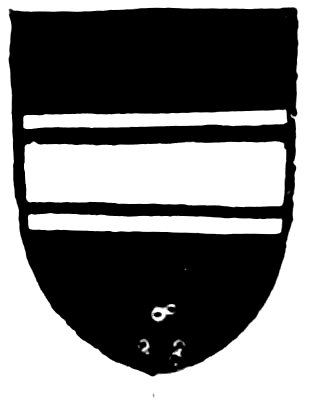
Ye most also dilygently attende to the nombre of both too colowris in armys palyt barrit or lees barrit of the wich lyttyƚƚ barris ye most be ware when thay be fownde in armys. as here it is shewyd in theys armys. for sych lynes be called lyttiƚƚ barris to the differance of littiƚƚ barris. And it shaƚƚ be sayde that the gentiƚƚ man the wich berith theys armys beris in this thys wyse. first in latyn thus as folowis 177¶ Portat vnam barram et duas barulas de albo in campo rubio Et gallice sic. ¶ Il port de gowlez vng barree et deux barrelettee dargent. Et anglice sic. ¶ He berith gowles oon barre and .ij. liteƚƚ barris of Syluer.
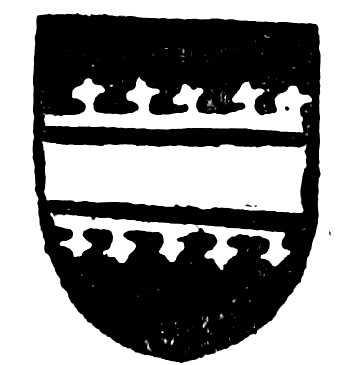
Beholde how the forsayd letiƚƚ barris ar othyrwyle made florishingli & than thei be calde florishyt as here ī thys scochon. And they be calde florishit: for they be made bi ye maner of a flowre deluce. And ye shaƚƚ say of him that is possessor of theys armys ī thys wise as folowys. first in latyn thus. Portat vnam barram et duas barulas floridas albas in scuto siue campo blodio. Gallice sic. Il port dasor vng barriee et deux barrelettes florit dargent. Anglice sic. He berith asure oon bar and .ij. litiƚƚ barris florishyt of Syluer.
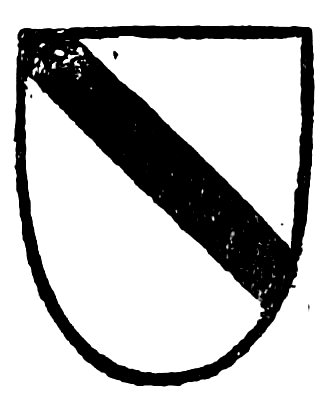
Other wyle ther is borne in armys a bende as is founde ī dyuerse armys of certan noble gentilmen as here now itt shaƚƚ beshewyt. And ye moost knawe that it is calde a bende the wich begynnys at the right corner or the horne of the shelde: and discendith to ye lefte side of the same sheelde: to the differans of fissures or of liteƚƚ stauys of the wich it shaƚƚ be spokyn after. And of hym that has theys armys ye shaƚƚ say thus as folowys. first in latyn. ¶ Portat vnam 178bendam de rubio in campo aureo. Gallice sic. ¶ Il port dor vng bende de gowlez. Anglice sic. ¶ He berit h golde &̄ a bende of gowles.
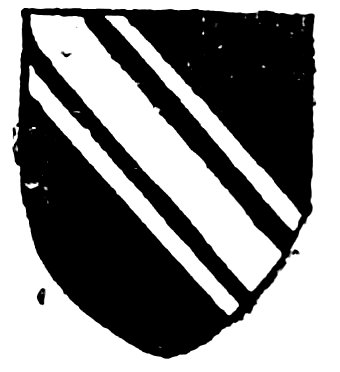
Knaw ye how afore it is sayd that certan littyƚƚ barris ar borne ī armys mony tymys. On the same maner of wise ar borne littiƚƚ bendys as here it shaƚƚ be shewyt. And they be calde bendyllys to the differans of grete bendys as it is opyn. And of hym that beris theys thꝰ it shaƚƚ be sayd. first in latyn as here folowys. Portat vnam bendam & duas bendulas de auro ī campo blodeo. Et gallice sic. Il port dasor vng bend et deux bendelettis dor. Anglice sic. He berith asure a bende and .ij. bendils of golde. And thes bendyls ar othirwyle florishyt as is shewyt in the figure a fore in barris. And in diu̇se armys they be founde that they be chenyt. And sum be powderit with molettis. and sum with odir dyfferans the wich nedys not to be figurit here
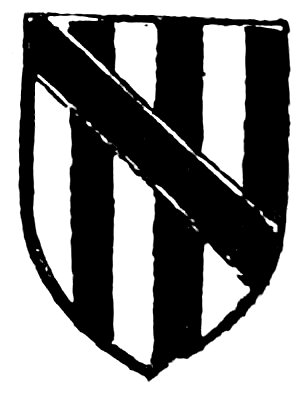
The best maner of wyse certanly of beryng of dyu̇se armys in oon sheelde is in theys bendys bering for a man that has a patrimony left by his fadyr. And other certan londys by his modyr cumyng to him to the wich londys of his moderis ar appropurt armys of olde tyme for it may hap that theys armys coom to hir by the way and discent of hir progenyturis. then may the hayre and hym list 179bere the hooƚƚ armys of his fadyr in ye hooƚƚ sheelde. And ī syche a bende he may bere his moderis armys as here in the scochon afor apperis. And it shaƚƚ be sayd of him that beris theys armys in latyn thus. Portat arma palata de argento et rubio cum vna benda de nigro. Gallice sic. Il port palee dargent et de gowles et vng bende de sabuƚƚ. Anglice sic. He berith palee of Syluer and gowles with a bende of sabuƚƚ.
¶ And othyrwyle ī syche a bende ther is founde .iij. molettys or macules of golde.
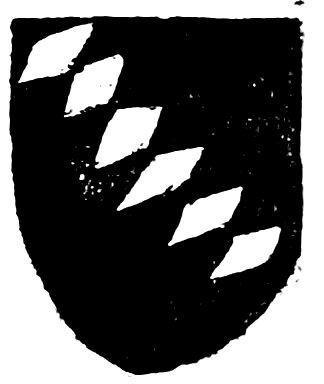
More ou̇ ther be founde in armys other certan bendys to sū man strange from theys. and here I wyƚƚ shew to yow a bende the wich is calde a bende fusillit: as here apperith in this scochon. And it is calde fusullit for it is made aƚƚ of fusillis of the wich certan fusillis more shaƚƚ be spokyn afṫward. Bot he the wich has theys armys beris in latyn thus. Portat vnam bendam fusillatum de auro in campo asorio Gallice sic. Il port dasor vng bendee fusillee dor. Anglice sic. ¶ He berith asure a bende fusillit of golde.
¶ And thys bende mony tymys is borne with strangeris and specialli in Burgon.
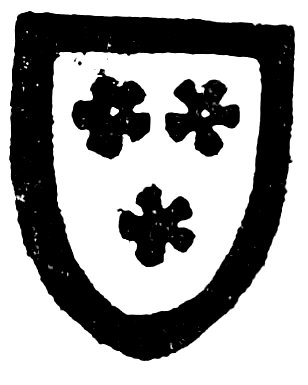
Bordures many and dyu̇se ar founde ī armys and ar borne of many nobuƚƚ men: of the wich sum be playn. sum īgraylit. sum talentit. sum playn powderit. sum chekerit. sum gobonettyt. sum inueckyt. of the wiche it shaƚƚ be spokyn eu̇yche oon after ordir. And first of playne borduris I wiƚƚ speke as here it apperis. And the bordure is calde playne when it is made playn of oon colowre aloon. as here in thys scochon. And it shaƚƚ be sayde of hym that is possessor of theys armys first in latyn thꝰ ¶ Portat tres rosas rubias in campo argenteo cum vna bordura de rubio. Et gallice sic. ¶ Il port dargent trois rosis de goulez et vng bordure de gowles. Et anglice sic ¶ He berith Siluer .iij. rosis of gowles and a bordure of gowles.
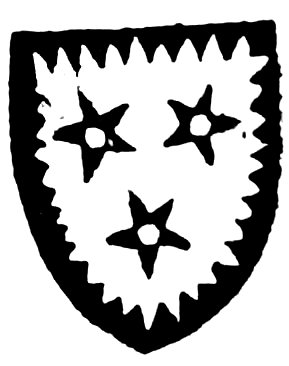
Armys with a bordure ingraylit other while ar borne of certan nobuƚƚ men as here now is shewit in thys scochon. And syche a bordure is calde a bordure ingraylit for the colowre of hym is put gre by gre in to the felde of tharmys as it is opyn here. And the possessor of theys armys beris ī latyn tong thus as folowys. ¶ Portat arma de auro fymbriata siue bordurata de nigro ingradata cum tribus maculis perforatis de nigro. Gallice sic. ¶ Il port dor trois mullettis perforatee de Sable vng borduree ingraylee de Sable. Anglice sic. ¶ He berith golde .iij. molettis perforatit of Sabuƚƚ and a bordure ingraylit of Sabuƚƚ.
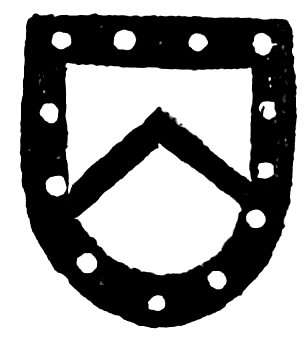
Ther is borne in armys a certan bordure talentit as here. and it is not necessari here to expres the colowre of the talentis or besantis: for thay be euer of golde. And it shaƚƚ be sayd of him that beris thes armis in thys wyse first in latyn thus. ¶ Portat vnum signum capitale de rubio in campo albo borduratum cum rubio talentatim. Gallice sic. Il port dargent vng cheueron de gowlez borduree de gowlez talentee. Et anglice sic. ¶ He berith siluer a Cheueron of gowles bordurit with gowles talentyt.
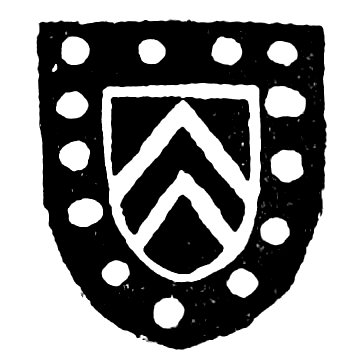
Understonde ye that certan tymys a bordure is borne in armys powderit dyuerse ways other wyle with molettis with rosis or with littyƚƚ crossis or with besantis or oder dyu̇se. And it is calde a bordure powderit when any thyng is ī that bordure: of what sum eu̇ signe it be. as it is sayd a fore. and theys signys as rosis moletis and other ar not countit for ċtan nombur: for ye nombur of that powderyng excedis the nombur of ix And then yt bordure is calde powderit as here. And ye shaƚƚ say that the possessor of theys armys beris in this wyse as folowys. first in latyn thus. ¶ Portat vnum scutum 182de rubio cum duobus signis capitalibus de albo et vna bordura pulu̇isota cum talentis. Et gallice sic. ¶ Il port de gowlez deux Cheuerons dargent et vng bordure de gowlez powdree telentee. Anglice sic. He berith gowles .ij. Cheuerons of Syluer and a bordure powderit with besantis.
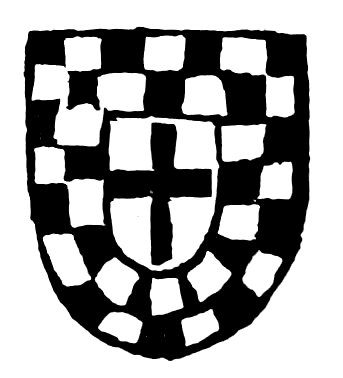
We haue yit an other bordure in armys the wich is calde a bordure chekkerit. And it is calde a chekkerit bordure for hit is made of .ij. colowris by the maner of a Chekker as here it apperis. And it shaƚƚ be sayd of hym the wich beris theys armys in this wyse as folowys. first in latyn thus. Portat vnam crucem rubiam planam ī campo argenteo cum vna bordura scaccata de nigro et argento. Et gallice sic. Il port dargent vng croys playn de gowles borduree chekkee de Sable et dargent. Et anglice sic. He berith Siluer oon cros playn of gowles a bordure chekkerit with Sabuƚƚ &̄ Siluer.

Knaw ye more ou̇ that yit by side theys armys the wich I haue spoke of afore wt borduris: ther is an other bordure that is calde a bordure gobonatit. as here it shaƚƚ be shewyt ī thys scooehon next folowyng. And hit is calde gobonatyt for 183hit is made of ij. colouris quadratli ioynyt. yt is to say of blacke &̄ white. & of hym that beris theys armys ye shaƚƚ sey in latyn thus as foloyis ¶ Portat de argento & duas bendas de nigro cū una bordura de nigro et albo gobonata. Et gallice sic. ¶ Il port dargent deux bendee et vng bordure de sable et dargent Anglice sic. ¶ He berith siluer ij bendys of Sable with a bordure gobonatit of Sable & siluer
¶ And thys same bordure baare that nobuƚƚ prynce the duke of Gloucestyr brothyr to that nobuƚƚ weriowre Kyng henri the fifth: the wich royaƚƚ duke bare in his armys the hooƚƚ armys of Fraunce and of Englond quartly with a bordure gobonatit of Siluer and sable as is shewyt in diu̇se placis. And to blase theys armys it nedis not to be rehersit. for it is suffisciently taght afore in diuerse placis.

Ther be yit borduris ī armys of ij. colowris inueckyt. as here in thys figure apperis. and hit is calde a bordure inueckyt for hit is made of .ij. colowris to gedyr inueckyt. And ye shaƚƚ say of hym the wich berith theys armys in latyn thus. Portat arma quarṫiata de rubio et auro cum vna bordura de argento et nigro simul inuectis. Et gallice sic. ¶ Il port quartelee de gowlez et dor ouesqꝫ 184vng bordure verre dargent et de sable. Anglice sic
¶ He berith quartly gowles and golde with a bordure inuekkyt of siluer and sable.
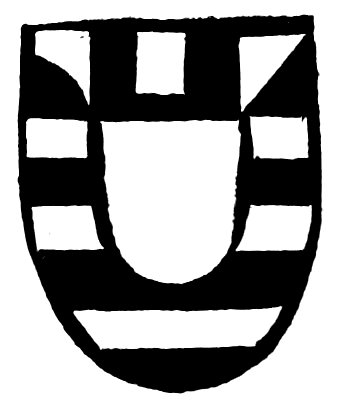
Bott ī thes borduris ther is a grete differans emōg men pretendyng theym exꝑte and wyse in thys sciens as specially it is opyn ī tharmys in olde tyme of therle of Marche wheḋ they shulde be calde borduris or not. as here ī thys figure. And certan men say yt men not puttyng a merueles differans of blasyng say: that the forsayd Erle of marche the wiche wos calde Roger Mortememer when that he leuyd bare armys in latyn in thys wyse to say ¶ Portauit arma palata barrata et contraconata de asorio & auro cum vno simplici scuto de argento. Gallice sic. ¶ Il port pale barree girone dasor & dor et vng escu simple dargent. Anglice sic. ¶ He berith paly barri contrari conyt of asure &̄ golde with a sīple shelde of silu̇.
¶ And this opynyon afore rehersit in the blasyng plesyt many a man the wich in no maṅ of whise may be trw. For if thes armys as it is sayd afore war contrari conatit. then the lawist corner or the coone of tharmys that is to say the lawyst poynt of the shelde may neu̇ be of oon colowre as certanly it is of asure.
Over theys thyngys afore rehersit in theys armis it is ċtan that in aƚƚ armys contrari conyt aƚƚ the conys of what sum eu̇ colowre tharmys be made they mete to gedyr conally in the middis of the shelde. as in the next figure of the shelde opynly it shaƚƚ 185be shewyd. Wher fore as it apperith to my reson trulier they shal be blasit on this wyse: exceppit the gretter autorite that the forsoyd Erle of Marche berith thus in latyn. Portauit arma barrata et caput scuti palatum & angulatum de asorio & auro cum quodam scuto simplici de argento. Et gallice sic. Il port barree et vng Chieff palee cunecte dasor & dor et vng escu simple dargent. Et anglice sic. ¶ He berith barri and a Cheeff pale angulatit of asure and golde with a symple shelde of Silu̇.
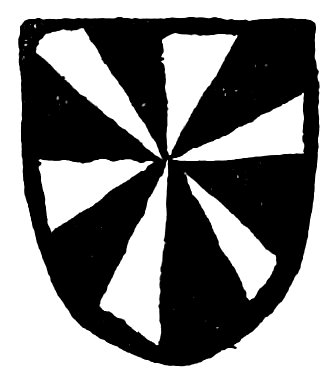
Ther be yit for sooth diuerse noble men the wich bore armys contrari conyt. as here in thys scochon apperith. And theys armys be calde contrari conyt for this cause. for aƚƚ the colouris of theys armys meete to gedir at oon coone. that is to say at the myddyst poyntt of the shelde oonly. For eu̇y body triangulit is moore of lengthe then of brede and naamly conyt vt pꝫ. Therfore the opynyon of thos men the wyche sayd that the armys afore rehersit: that is to witte of therles armys of Marche war palyt barrit and contrari conyt is to be repreuyt. for so mych that the conys of the forsayd armys 186accorde not the wich of necessite shulde accorde iff the forsayd opynyon wer trw. And of hym that beris theys armys ye shaƚƚ say in latyn. Portat arma contraconata de blodio et albo Et gallice sic. Il port girone dasor et dargent. Anglice sic. He berith contrari conyt of asure and siluer.
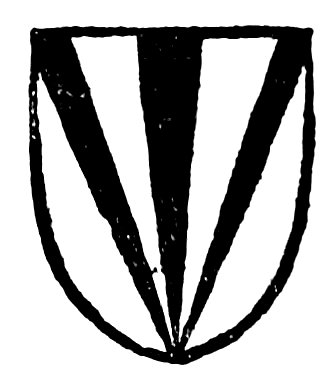
For as mych as it is spokyn afore of armys: in the wich the colowris mete to gedyr in the myddist poynt coonly. Now folowyth of certan armys in the wich iij. pilis mete to gedyr in oon coone. as here in thys figure. And it shaƚƚ be sayde of hym the wiche beris theys armys in latyn in thys wyse. ¶ Portat tres pilas nigras in campo aureo. Gallice sic. Il port dor trois piles de sable. Et anglice sic. ¶ He berith golde .iij. pilis of sable.

Neuer the les ye most consydyr a differans ī theys blasyngys of theys armys afore: and theys that cum after when ye blase theym in latyn tong. for other while thys terme pila ī latyn is take for to be a peese of tymbre to be put vnder the pelor of a bryge: or to syche a like werke as ī thexempuƚƚ afor And odyr while this terme pila is take for a certan rounde īstrumēt to play wt: the wich īstrumēt ẜuys other while to the hande 187and then it is calde ī latyn pila manualis as here And other while it is an instrument for the foote and then it is calde in latyn pila pedalis a fote bal Therfor it shaƚƚ be sayd of ħym that beris thes armys in latyn Portat tres pilas argenteas in campo rubio. Et gallice sic. ¶ Il port de gowlez trois pelettit dargent. Et anglice sic. ¶ He berith gowles iij. ballis of Siluer.
Certanli ye most merke that ī this figure of ballis a mā may soon er. Werfore shortly it is to be knaw that sich ballis may haue aƚƚ colowris bot the colowre of golde for & thei be of goldyn colouris: they shulde be calde talentis or besantis the wiche be eu̇ of golden colowre.
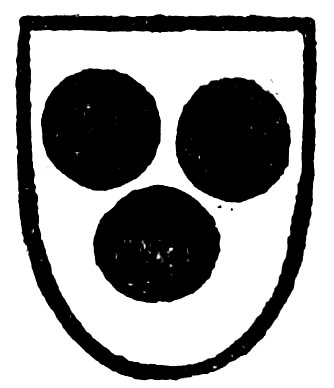
Ther be also tortellis yt be litiƚƚ Cakys the wich be grettir then ballys & tharmys be truly made as here it is opyn. And he that beris theys armys beris in this wyse first ī latyn. ¶ Portat tres tortellas rubias ī campo aureo. Gallice sic. ¶ Il port dor et trois torteulx de gowlez. Et anglice sic. ¶ He berith golde & .iij. Cakys of gowles.
More ouer merke: that as wele ballys in armys as kakis and besantis aƚƚ way ar hooƚƚ rownde figuris &̄ not ꝑforat
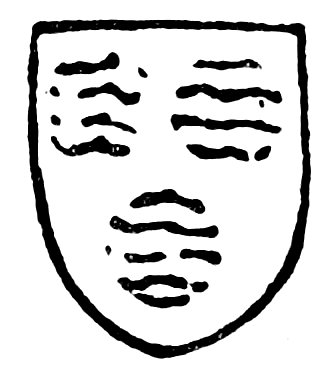
Neu̇ the les ther be ċtan nobuƚƚ men the wich beer siche rounde figuris: the wich figuris ar calde fontanys or wellis as here apperis. 188the wich fontans eu̇more most be of whyte colowre for the thyng the wich they represent. For they represent eu̇more the colowre of the water of a weƚƚ the wich is white And of hym yt beris thes armys ye most say in latyn thus. Portat tres fontes ī campo aureo. Gallice sic Il port dor et trois fonteyns. Anglice sic. ¶ He berith of golde and .iij. wellis.
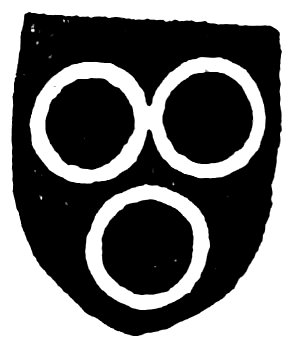
After theis rownde figuris a fore rehersyt ther be ċtan figuris the wich be ꝑforatit as be ryngys: as here apperis. And it shaƚƚ be sayd of hym that beris theis armys ī latyn thꝰ. Pertat tres anulos aureos ī campo negro. Gallice sic Il port de sable et trois anulettis dor. Anglice sic. He berith Sabuƚƚ and .iij ryngys of golde

Afore it is sayd of borduris ī armys. now it folowith to se of tractis or lynys. and first of a symple tract. and they be calde tractis for as mych as the felde remaynyng of tharmys as wele with ī as with owte. & an other lyne is drawyn of an other colowre as here: to the maṅ of a shelde. And it shaƚƚ be sayd of hym that beris thes armys ī latyn. Portat vnū tractū sīplicem planam aureū ī campo asoreo Gallice sic. ¶ Il port dasor vng trace playn dor. Anglice sic ¶ He berith asure a playn tract of golde.

A tract or a lyne othir while is ingraylyt on booth the partes
as here in thys fygure apperith. And then it shaƚƚ
189be sayd of hym that beris theys armys ī thys wyse
first in latyn thus. ¶ Portat vnum tractū
ex vtraque parte īgradatum de aupo ī campo rubio
Et gallice sic. ¶ Il port de gowlez vng trace
ingrayle de chestim coste dor. Anglice sic.
He berith gowles wyth a tract ingraylyt on booth
the sidys of golde.
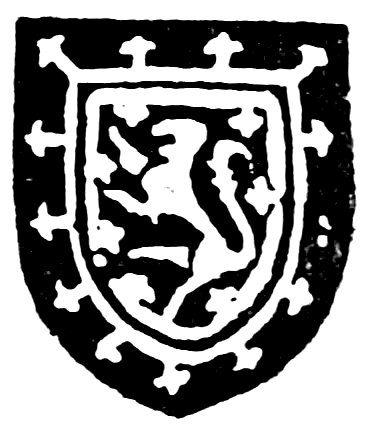
Thys tract is other wyle dowbuƚƚ as in tharmys of the Kyng of Scottelonde. as here in this scochon apperis. & the forsayd Kyng of Scottelond beris ī thys wyse first in latyn thus. Portat duplicem tractum cum floribus gladioli contrapositis et vno leone rapaci de rubio in campo aureo. Et gallice sic. Il port dor vng dowble trace floretee countree et vng leon rampant de gowlez. Anglice sic. ¶ He berith golde a dowble trace florishyt contrari and a Lyon rampyng of gowles.
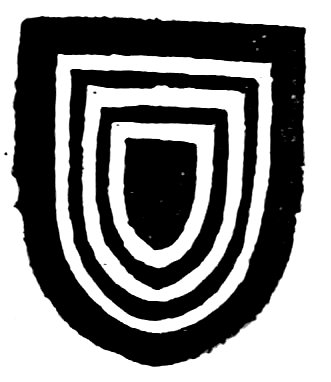
Also of theys armys afore rehersit I fynde more dyuersite for ther be certan nobuƚƚ men the wich bere theys tractis triplatit as here in thys fygure. and sum bere hit quatriplatit as is founde ī diu̇se armis. And ye shaƚƚ say of him that beris theys armys triplatit ī latyn thus. ¶ Portat tractum triplicatū de albo ī campo aureo. Gallice sic. Il port dor vng trace triplee dargent. Anglice sic. ¶ He berith golde a trace triplatit of Siluer.
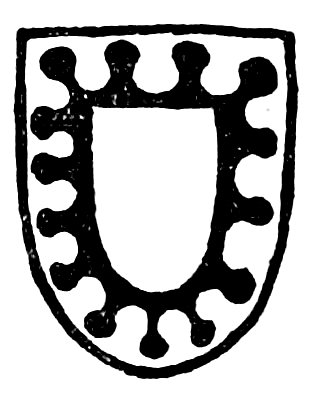
Ther be other nobuƚƚ men the wich bere a simpuƚƚ tract of .ij colowris inueckyt as here now it shaƚƚ be shewyt in thys scochon. And the possessor of theys armys beris in this wyse as folowis first in latyn. Portat vnum tractum simplicem de coloribus asorio argenteo inuectis in scuto aureo. Et gallice sic. ¶ Il port dor vng trace simple verre dasor et dargent Anglice sic. ¶ He berith golde and a tract symple inueckyt of asure and Siluer.

Afore theys fyssuris it is spokyn of bendys: and their differans. Now it shaƚƚ be spokyn of fyssuris. the wych ċtan fyssuris or stauys begynne in the lefte horne of the shelde: &̄ ar drawne to the right parte of the shelde beneeth to the differance of bendys the wych begynne in the right horne of the shelde &̄ ar drawne to the lefte side of the shelde beneeth. and thys way most the fyssure be drawne as here apperis ī thys fygure. And ye shaƚƚ vndirstonde that theis fissuris differ as mony ways as the forsayd bendys dyfferyt. bot it nedys not to be rehersyt for it is playn shewyt afore. Ther be fyssuris or stauys playn. ingradyt. inueckyt. and fusyllatit. as I sayd afore in the place of bendys. And theys stauys bastardys ar wont to bere or namli thay shulde bere thaym. And then thys fyssure is calde a staffe: & ī french it is cald a baston 191Bot commynli it is calde a fissure for as mych that he cleuys his faderis armys in .ij partes for that bastard is clouyn and deuydyt from the patrimony of his fader. And so sych a bastard is forbedyn to bere the hooƚƚ armys of his fader for the reuerans of his blode. bot his faderis armys he may bere with sych a staffe as is sayd afore: in signe and finaƚƚ declaracion of his bastardy and to the differance of propur and naturaƚƚ hayre of his fader. And when ye haue any sych a playn fissure or a staffe ī armys or ingraylit inueckyt or fusillatit: of that same staffe ye shaƚƚ say as a fore is rehersit in the chapiture of bendys moore playnli. And the bastarde the wich berith theys armys possessis in latyn on thys maner as now here folowys. Portat vnam fissuram siue baculum aureum ī campo asorio. Gallice sic. Il port dasor et vng fees dor. Anglice sic ¶ He berith asure and a fissure or a staffe of golde.

Ther be certan nobuƚƚ men the wich bere armis hedit as here it apperith. And ye most knaw that theis armys be called hedyt: when the hyer parte of the shelde that is to say the hede is made of oon coloure or of moo then of oon. & that parte extendys not to the myddis of the shelde as aboon is shewyt by the shelde. And knwe ye that in the hedit armys is a good maṅ of beryng of dyu̇se armys as by fortune sū noble man has mony londis and grete lordshippys by his modyr for the wych londys of his moderis he intendys to bere the armys of his modyr. and so he may do for it is rightwys. 192Bot he that discendys of a nobuƚƚ fadyr or of a gentiƚƚ man. by the wych he had any simple patrimony. then sych a nobuƚƚ man: and he wiƚƚ: may bere the hooƚƚ armys of his moodyr in the lawyr parte of his shelde. and in sych an hede as I sayd a fore he may and he wiƚƚ bere the hooƚƚ armys of his fadyr And it shaƚƚ be sayd of hym that beris theys armys ī thys wyse first in latyn thus. ¶ Portat vnum signum capitale de nigro in campo aureo cum vno capite rubio et tribus talentis ī eodem. Et gallice sic. Il port dor vng cheueron de Sabuƚƚ et vng Cheeff de gowlez et trois besantis en la mesmes. Anglice sic. ¶ He berith golde a cheueron of Sabuƚƚ wt a Cheeff of gowles and .iij. besantis ther in.
¶ And ther be certan nobuƚƚ ꝑsones the wich beer in the shelde afore rehersit of golde as is sayd a fore a Cheueron of Sabuƚƚ or of sum odyr colowre and .iij. rede roosis or whyte or sum other sygnys as crossis cressantis briddys or flowris and a cheeff sum of Sabuƚƚ sum of other colowre with the signe of molettis or oder tokynyngꝭ the wich need not to be rehersit. And then shaƚƚ euerich oon of theym be blasit in his nombur like as the felde and the signes require: as by fortune sum men bere thus to say. He berith Sabuƚƚ a Cheueron of golde .iij. rede rosys of gowles a Cheeff of asure with .iij. molettys perforatit of vert and thus of aƚƚ other differansys.
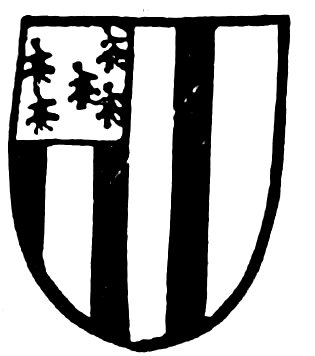
Certanly ther be sum nobuƚƚ men the wych bere in ther armys oon quarter of an other colowre dyfferyng from the 193coloure or the colowris of the shelde as here. in the wich armis it is to be sayd that the nobuƚƚ man the wich beris theym berith in this wyse first in latyn. Portat arma palata de aserio & auro cum vna quarteria eremetica. Et gallice sic. Il port palee dasor et dor vng quarṫ dermyn. Et anglice sic. He berith paly asor and golde with oon quarṫ of Ermyn.
¶ And it is to be notit that ye most haue a respebkyt to the colowre of that pale the wich shulde ascendee to the right horne of the shelde iff that quarter wer not ther. and ī that colowre ye most eu̇ moore begyn to blase thoos armys like as the quart were not ther as afor is rehersit.

More ouer other whyle we se armys chekkerit as here now it apperith in thys figure folowyng and they be calde armys chekkerit when they ar made of .ij. colouris to the maner of a chekker. And theys armys resayue many differens as in hedys or quarteris ī barris and bendis and other wyles ī Cheuerons of ye wich it shaƚƚ be spokyn a noon foloyng. And of hym the wich possessis theys armys ye shaƚƚ say in latyn thus. Portat arma scakkata de aserio et auro. Et gallice sic. ¶ Il port scakke dasor et dor. Anglice sic. ¶ He berith Chekker of asure and of golde
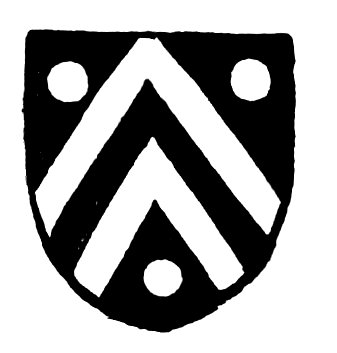
We haue sotheli in armys certan signys the wich ar calde Cheuerons in french. And they be calde in latyn Signa capitalia vel tigna. and in englisħ a cowpuƚƚ of sparris as here is shewyd ī theys signes: the wich signes by liklenes first war borne of carpentaries and makeris of howses. for an howse is neu̇ made ꝑfite tyƚƚ thoos sparris be put a pon hit: by the maner of an hede. and .ij. syche sparris or cheuerons ionyt to gedyr make a capitaƚƚ sygne. yt is to say a cowpuƚƚ of sparris. and other while .ij. syche be borne ī armys and othyr while .iij. odyr while .iiij. as it is knawyn. And of him that beris theys armys afore ye shaƚƚ say thus as folowys first ī latyn. ¶ Portat de rubio et duo signa capitalia de auro cū tribus talentis. Et gallice sic. ¶ Il port de gowz et deux Cheuėrons dor et trois talenṫ. Anglice sic. ¶ He berith gowles and .ij. Cheuerons of golde with iij besantis.
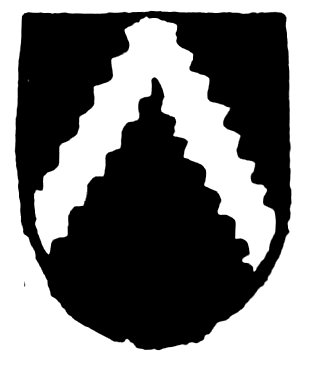
Also a Cheueron is othir while engraylyt as here and then it is to be sayd of hym the wich beris theys armys in latyn in thys wyse. ¶ Portat vnum signum capitale ingradatum de albo in campo asoreo. Et gallice sic. ¶ Il port dasor vng Cheueron dargent ingraylee. Anglice sic. ¶ He berith asure and a Cheueron of Syluer engraylyt.
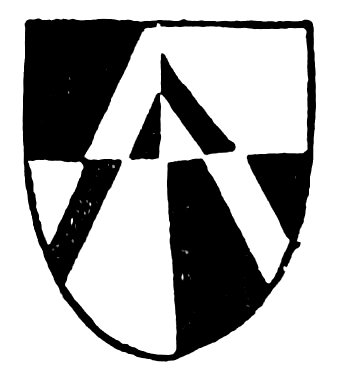
More ouer yit ī theys signys of Cheuerons other while is fownde a dowte in the blasyng of theym. when thei be made of dyuerse colowris transmutit as here in this scochon apperith. And of hym the wych beris thes armys ye shaƚƚ say in latyn. ¶ Portat arma quarteriata de nigro & argento cum vno signo capitali de dictis coloribus transmutatis. Gallice sic. Il port quarterlee de sable & dargent & vng Cheueron chaungee lung de laultre. Anglice sic. ¶ He berith quarterly Sable and Siluer with a Cheueron of the sayd colowris transmutit.
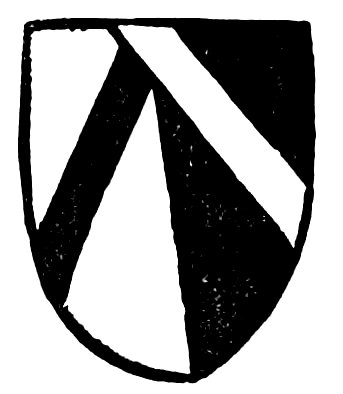
Also theys signes or Cheuerons be differit after the long way in armys as here in this figure apperith. And then of hym the wich beris theys armys ye shaƚƚ say in latī. ¶ Portat arma partita secūdū lōgū de coloribus aureo & rubeo cum vno signo capitali de dictis coloribus transmutatis. Gallice sic. Il port partie du long de dor & gowlez vng cheueron chaunge lung de laultre. Anglice sic. ¶ He berith party afṫ the longe way of .ij colouris golde and goules with a Cheueron of sayd colowris transmutit.
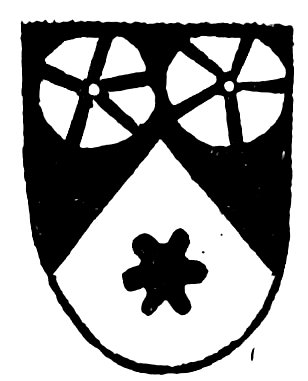
Emong othyr dowtis: a bowte the blasyng of tharmis here folowyng now next I haue herde herroddys pretendyng 196theym selfe veri conȳng in blasyng of armys meruelusli to dreeme in the blasyng of theys armys. And sum holde oon opynyon and sum an othyr. neuer the les it is no grete neede to dowte in the blasyng of theym as to conyng men. Thefore of hym yt beris thes armys ye shaƚƚ say ī latyn. Portat duas ꝑtes capitis scuti de rubio & ṫciam ꝑtem de albo ad modum signi capitalis et tres rosas de coloribus transmutatis. Et gallice sic. ¶ Il port lez deux ꝑties du chief de gowlez et le troisune dargent ꝑtiez en manere du cheueron̄ et trois roses lung de laultre. Anglice sic. He berith .ij partis of the heede of the shelde gowles and the thride ꝑte Siluer by the maner of a cheueron and .iij. roses of the same colowris transmutit.
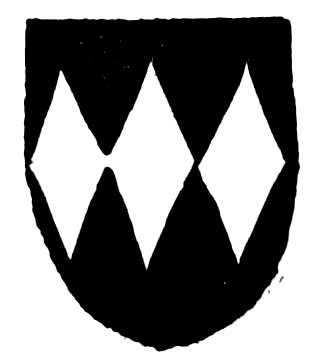
Ther be certan gentylmen and nobuls the wich beere in theyr armys fusellis: of the nombur of the wich: my lorde of Glaucestur yt nobuƚƚ prince vncle to Kyng henri the sext was. For he had in his armys .iij. fusillis of gowles by the maṅ of a bar in a felde of siluer the wich ctan armys this nobuƚƚ duke bare by the reson of certan londis belongyng to the mounte. Bot ye shaƚƚ say of hym that beris theys armys ī this scochon in latyn thꝰ ¶ Portat de rubio et tres fusulos de argento. Et gallice sic. Il port de gowlez et trois fusulez dargent. Anglice sic. ¶ He berith gowles and .iij fusules of Siluer. And otherwhyle theys .iij. fusules or .iiij. be borne by the maner of a paale.
197It is to be notit that when .iii fusules or .ij. ar borne or moo to the nombur of .ix. the wich nombur if thei excede: say euermore that thos armys be powderit with fusillis or other thyngys and noon othyr wyse. ¶ And so generalli ye most knaw that iff any thyng be borne in armys ouer the nombur of .ix. then thoos armys what sum euer they be thay ar powderit.

Other while oon fusyƚƚ is borne allon in armys as here ī thys figure it apperith. in wich mater I haue herd certan herroddis dowte in theyr opynyonys. Neu̇ the lees it is ċtan that ye shaƚƚ say of hym the wich beris theys armys with owte dowte ī latyn thus as folowis. Portat de rubio cum vno fusulo de auro Et gallice sic. Il port de gowlez vng fusiƚƚ oor Anglice sic. ¶ He berith gowles and a fusiƚƚ of golde.
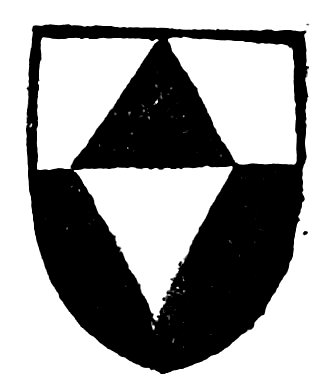
Also theys fusyllis sum tyme ar borne of dyuerse colowris as here in thys figure it is shewyd. Bot it is a moore dowte how theys armys shulde be blasit then tharmys afore. bot ye shaƚƚ say ī latyn of hym the wyche has thes armys in this wyse. Portat arma partita ex transuerso de albo et nigro cum vno fusulo ex eisdem coloribus transmutatis. Et gallice sic. Il port partie de trauers dargent et sable et vng fusyƚƚ de mesmes colours lung de laultre. Et anglice sic 198He berith armys partit ouerwart of Siluer & sable with a fusyƚƚ of the saam colowris transmutit.
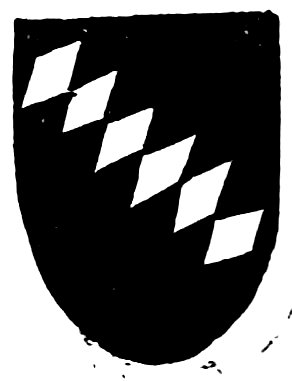
More ouer sych fusyllis ar borne in armys by the maner of a bende. as here now apperith And then ye shaƚƚ say of hym the wich possessis theys armys in this wyse first in latyn thus. ¶ Portat vnam bendam fusillatam de auro in campo rubeo. Et gallice sic Il port de gowlez vng bende fusyƚƚ dor. Et anglice sic. ¶ He berith gowles and a bende fusyllit of golde.
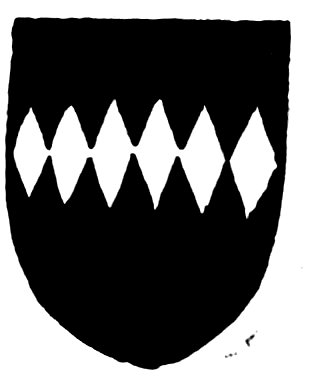
Also ther be borne in armys theys fusyllys in a bar fusyllit as here it apperith. And then it is to be sayd of hym the wich hath theys armys in latyn thus. ¶ Portat de rubio cum vna barra fusillata de argento. Gallice sic. ¶ Il port de gowlez vng barre fusulee dargent. Et anglice sic. ¶ He berith gowles and a bar fusyllyt of Siluer. And sum men say that the forsayd armys began of weueris for as mych as weueris vse sich fusillys made of sponnyn woƚƚ
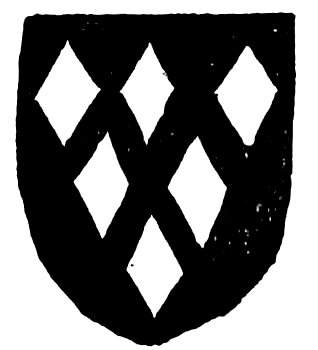
Now here ye shaƚƚ knaw the differans be twix fusillis masculys and losyngys. Wherfore it is to be knaw that 199fusyllis ar euer more long also fusyllis ar strattyr ouerwart in the baly then ar Mascules. And Mascules ar larger ou̇wartt in the baly: and shorter in the length then be fusylles. as here ī this scochon it apperith. And it shaƚƚ be sayd of hym that possessis theys armys in this wyse. first ī latyn. Portat de rubio & sex masculas de auro. Et gallice sic. Il port de gowles et .vi. mascules dor: Et anglice sic. ¶ He berith gowles and sex mascules of golde.
And theys mascules other while ar ꝑforatit as I sayd ofore in the chapiture of the cros masculatit.
Off an othyr maner of mascules yit here I wiƚƚ speke.
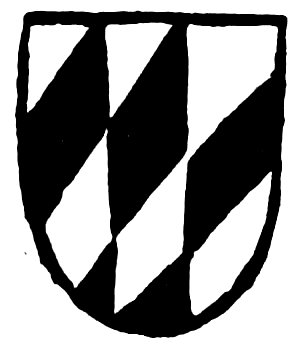
Also other while ar borne armys masculatit as here now in this figure folowyng is shewyt. And ye shaƚƚ vnderstande that thos armys be calde masculatit in the wich the forsayd mascules begyn most plentuysly in the right angle of the shelde. and ar endid towarde the lefte ꝑte. the wich certan armys in u̇y deed ar palit. & ar deuydit ī to .iij. palys yf thei be subtile consayuyt. And of hym that beris theys armys it shaƚƚ be sayd ī this wyse first in latyn. Portat arma masculata de argento & asorio. Et gallice sic Il port dargent et dasor masculee. Et anglice sic. ¶ He berith of Siluer and asure masculatit.
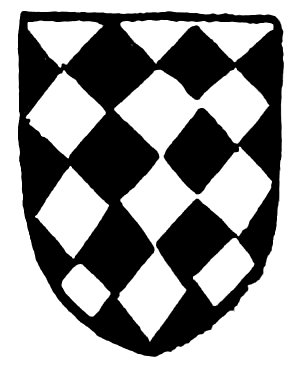
Also losyngye no maner of wyse be made bot ī armys bendit. ner they may not be made by ther selfe. and they be made aƚƚ way as theys be made bendit. And ye shaƚƚ haue the moost verey differans by twix the forsayd masculatit armys and bendid in the picturis of the forsayd armys. And ye most take thys for a generaƚƚ enformacion and instruccion thatt certanli losyngꝭ eu̇more stande vpright: that is to say that the heyst poynt or the heght: eu̇ ascendis to heuen or to a mannys heed. so that the heyst poynt extendys vttirly to the heed of the shelde. and of the ouerwart corneris oon extendis vtterly to the right side. and that other corner extendys to the lefte side of the shelde. and the lawist parte extendys to the lawist parte of the shelde dyametraliṫ as it is opyn in the shelde next a fore. And so with owte dowte we haue the differans of the forsayd signes. that is to wete of Mascules and Losynges. Nota also the forsayd fusyllis neuer be founde ꝑforatit ner losyngys afore sayd be neu̇ ꝑforatit.
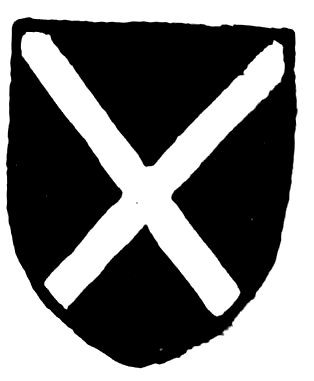
Ther is an other maner of signe in armys: by dyu̇se nobuƚƚ men borne: the wich is calde a Saltori. and it is made by the maṅ of a cros of Sayntandrew as here now it apperith. And thys cros is lickynt after certan men to an instrument made in dyuerse parkys the wich is of a grete magnytude or largenes: to the comparison of thys signe. And it is weƚƚ know of nobuƚƚ gentelmen and 201huntteris that sych saltatories ar ordant in mony parkys & plaas to take wilde beestys the wich onys their enteryng: by thatt instrumente may neu̇ goo a gayn. Wherfore in olde tyme thes signys were geuyn to rich men. and otherwyse calde auaris Nygonys or keperis the wich men suffir not their tresures ī what maner of wyse they be getyn: to passe from theym. And of hym the wich possessis theys armys ye shaƚƚ say in latyn. Portat de asorio et vnum saltatorium de auro. Et gallice sic. Il port dasor vng saultiere dor. Et anglice sic. ¶ He berith asure and a Saltory or a sawtri of golde.
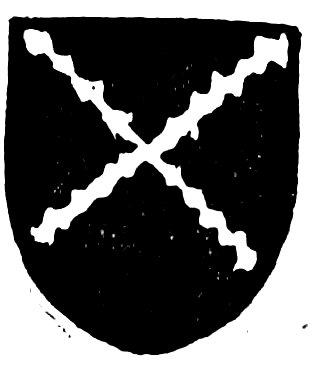
Now here ye most knaw that theys armys Sawtre be other while engradit as here in thys figure now apperith And then they be calde sawtre engradit as it is sayd afore in mony placis. as of the cros ingradit of barris and bendys. And of hym that beris theys armys ye shaƚƚ say in latyn. Portat vnum saltatorium ingradatum de auro in campo asorio. Et gallice sic. Il port dasor vng saultier dor engraylee. Et anglice sic. ¶ He berith asure and a cros sawtre of golde engradit.
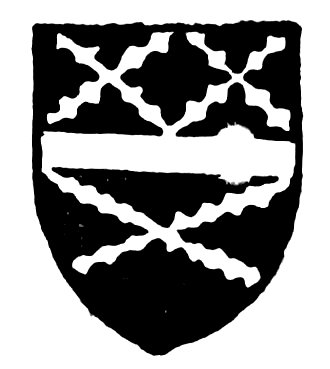
Other while ther be borne mony crossis sawtre ī armys engradit in oon shelde. other while .ij. other while .iij. as 202here. And of hym that beris theys armys thus it shaƚƚ be sayd in latyn. ¶ Portat vnam barram planam et tria saltatoria ingradata de auro ī campo rubeo. Et gallice sic. ¶ Il port de gowlez vng barre playn et trois saultiers engreilez dor Et anglice sic. He berith gowles oon bar playn and iii. sawtre crossis engradyt of golde.
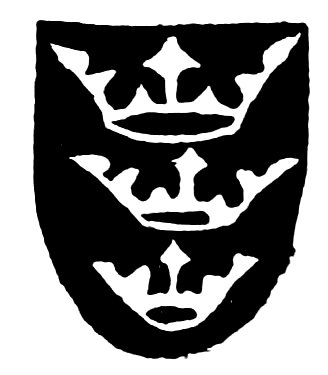
It is diligentli to be markyt that when we say sich a lorde berith in sych sygnys. How theys .iij. signes ar borne in armys we say not aƚƚ way. For other while theys .iij. signys ar put in a shelde by the maner of a pale. And then ther be calde signes palit. as here ī thys figure it apperith. And of hym that has theys armys ye shaƚƚ say in latyn. Portat iij. coronas de auro palatas in campo asorio. Et gallice sic. Il port dasor et trois corones dor paleez. Anglice sic He berith asure and iij cronys of golde palit.
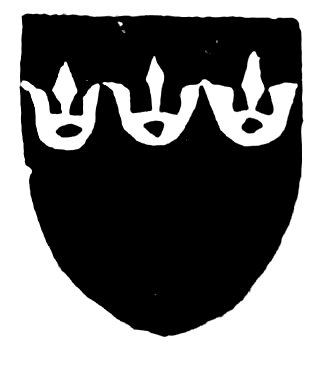
How theys .iij. signes othrr while be borne barrit here now apperith in thys figure. And then of him that beris theys armys ye shaƚƚ say in latyn. ¶ Portat tres coronas aureas ī campo asorio. Et gallice sic. ¶ Il port dasor et trois corones barrez dor. Et anglice sic. ¶ He berith asure & .iij. crounys of golde barritt.
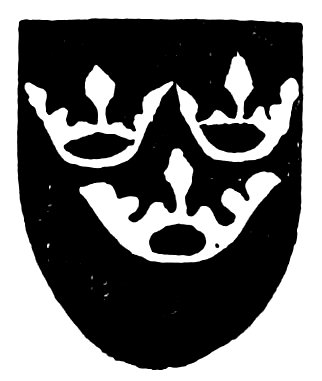
Certanly theys: iij cronys be borne ī the most comyn way in the corneris of the shelde as here in thys scochon it apperith And then ye most thus say that thes .iij signes be borne in the corneris of the shelde. for that is the most comune & the moost famust maner of beryng of thes .iij signes or ani maner signes Therfore ye shaƚƚ say that sych a lorde berith ī latyn in thys wise as here folowys. ¶ Portat de asorio et tres coronas aureas. non expremendo loca. Et gallice sic. ¶ Il port dasor et trois corones dor. Et anglice sic. ¶ He berith asure and .iij crownys of golde.

A new dowte yit is founde in armys. for as mych as ther was a certan man that heght Petrus de rupibus in tyme passit the bisshop of Wyṅchester: the wich baar ī his armys iij Rochys after hys awne naam in wich armys it is dowtit. whether it is enogh to say in the blasyng of them: that he bare sych iij fisħys allone. as here in thys scochon. And certanly I thynke nay. for the rule goyng a fore. Bot it is thus to be sayd: of the sayd Petur in latyn. ¶ Portauit tres huiusmodi pisces argenteos natantes in campo nigro. Et gallice sic. ¶ Il port de Sable et trois Rochez nāyantz dargent. Et anglice sic. ¶ He berith Sable and iij Roches swymmyng of Siluer.

¶ And then to tharmys of Galfride lucy as here now apperis ī this figure And ye most say yt he bare thus in latyn. ¶ Portauit tres lucios aureos in campo rubeo. Et gallice sic. ¶ Il port de gowlez et trois lucez dor. Anglice sic. ¶ He berith gowles and iij luces of golde. the wich certan blasyng with owte declaracion here is enogh. for the sayd fishes ar in thare propur placis as I sayd in the rule afore.
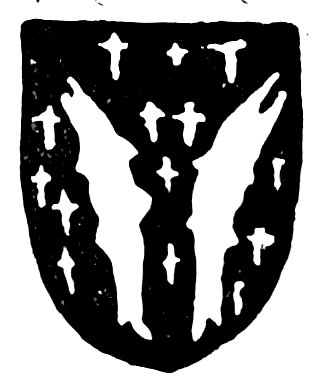
Bot what shaƚƚ be sayd of thys man then: the wich beris .ij. barbellis turnyng theyr backys to geder as here apperis. Ye most say in latyn thꝰ ¶ Portat duos barbillos aureos adinuicem ṫga vertentes in scuto asorio puluerisato cū crucibus cruciatis figitiuis de auro. Et gallice sic. Il port dasor poudree dez croys crocelez fichez et deux barbulx dors an dors dor. Et anglice sic. ¶ He berith asure powderit with crossis croslettys pycche and .ij. barbellis of golde backe to backe.

A certan nobuƚƚ baron that is to say the lorde awdeley of the Reame of Englonde baar in his armys a frecte. the wich certan frectis ī mony armys of dyu̇erse gentiƚƚ men ar founde. other while reede other while golde. and other whyle blac oderwhile simple and oderwhile dowble otherwhile tripuƚƚ 205and other while it is multepliet ou̇ aƚƚ the sheld as here it apperith. and ye most vndirstande on gret differans by twix armys bendit and theis armys the wich be made with the forsayd frettys wherfore it is to be markyt that in bendyt armys the colouris contenyt equally ar dyuydit. Bot ī thes frectis the felde alwai a bydys hooƚƚ as here. and this forsayd lorde audeley beris thus in latyn. ¶ Portat arma frectata de auro in campo rubeo. Et gallice sic. Il por de gowlez vng frette dor. Anglice sic. ¶ He berith gowles and a frecte of golde.
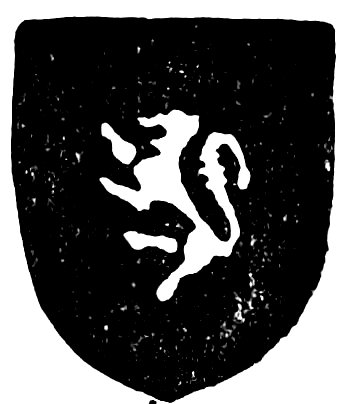
Beestis in tharmys of dyuerse nobuƚƚ ar borne rampyng as here ī thys figure folowyng apperith. of the wich ī the boke afore I haue made no mencion. And of hym that is possessor of theys armys ye shaƚƚ say ī latyn. ¶ Portat de rubio & vnum leonem de argento. Et gallice sic. ¶ Il port de gowlez vng Leon saliantz dargent. Et anglice sic. ¶ He berith gowles & a lion rampyng of siluer. And he is calde a Lion ramppyng for thys cause. for as mych as the right foote ascendyth to the right horne of the shelde. and the lefte foote descendyth in to the foote of the shelde as apperith ī the figure. And this same maṅ is obseruyt in aƚƚ beestis hauyng .iiij. feete. that is to say in lionys leopardis beeris doggis with other like to them.
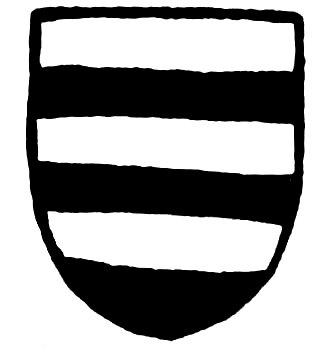
First note weƚƚ tharmys of the fadyr as here. and then the differancis as it shaƚƚ be shewyt. for certan ther be dyu̇se nobuƚƚ men ye wich bere labellis in theyr armys as it shaƚƚ be shewyt ī figure after. for the wich it is to be knawe that sych labellis ar not propurli calde signes in armys bot dyfferancis of signes. that when it is so: that any nobuƚƚ man haue mony lefuƚƚ getyn sonnys: then ye first son the wich is his faderis ayre: shaƚƚ bere the hooƚƚ armys of his fadyr with sum lyttiƚƚ differans as here. to whom specialli is geuyn a moon encresyng. for that first son̄ is in hoope of augmentacion and encressyng of his patrimony. & thys differans may be sum littiƚƚ molet or a cros croslet or sych a like differans.
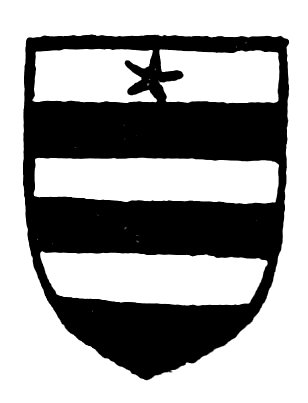
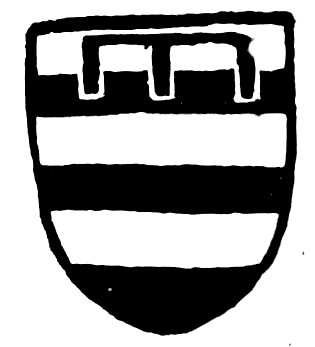
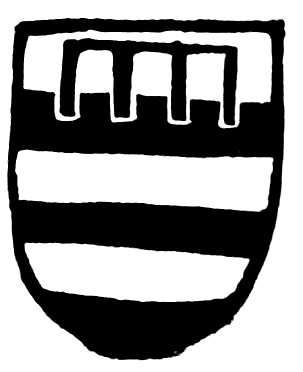
¶ The secunde broder shaƚƚ bere the hooƚƚ armys of his fader with .iij. labellis to the differans and in to the signe that he is the thride that beris thos armys. ¶ Also the thride broder if ther be any shall bere iiij. labellis ī tokyn that he is the faurith: that berith thos armis of whom the fader is the first. the ayre is the secunde. and the secunde broder is ye thride: that beris thoos armys. And so folowys that the thride broder shaƚƚ beere .iiij. labellis as here it apperith in thys figure. And so forthe iff ther be moo brether ye shaƚƚ encree yowre labellys after the forme afore rehersit.
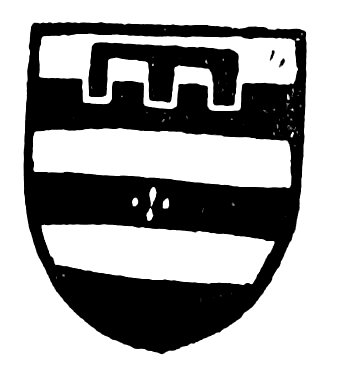
¶ And the sunnys of thoos same brether shaƚƚ beere the same labelis. ¶ And ī case that the secunde brother the wich berith iij. labeles haue .ij sonnys certanly thelder soon of thos .ij. the wich is hayre to his fadyr shaƚƚ bere the hooƚƚ armys of his fadyr: with also many labelys as his fadyr did. with a littyƚƚ differans as here it apperith in thys scochon. ¶ And hys secunde brodyr shaƚƚ bere the hooƚƚ armys of hys fadyr with the same labellis as his fadyr baare and no moo with a bordure as here in thys figure next folowyng it shaƚƚ be shewyt. and as it is rehersit in the chapiture of borduris.
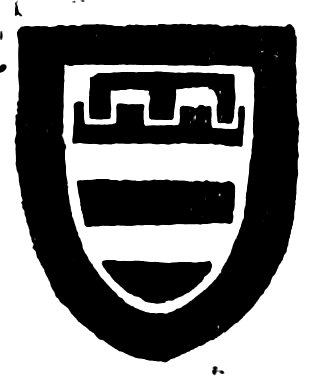
¶ And iff ther be the thride brodyr then he shaƚƚ beere hys faderis armys with the same labellis and a bordure of an other colowre to the differans of hys brothyr as it shaƚƚ be shewyt ī thys scochon next suyng
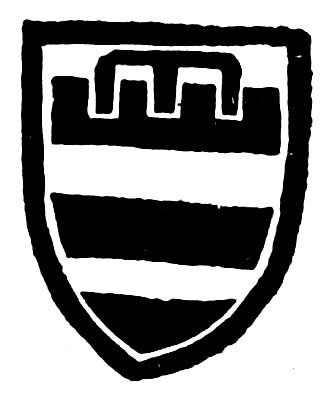
¶ And the chyldyr of thoos men shaƚƚ beere theyr dyfferans not in theyr faderis armys, bot in borduris and dyuysionys dyu̇se.
¶ And like as the chylder of the secunde brodyr beryng iij. labellis ar dyuydyt and dyfferit: by theye signys and theyr borduris. So the chylder of the thride broder beryng .iiij. labellis: bere the same armys that theye fader did &̄ also mony labellis. And they ar dyfferit by theyr signys and theyr borduris as afore is rehersit: and dyu̇se othyr. as oder while a Lyon raumpyng oon parte reed an othdr blakke.
Now certanly of aƚƚ the signys the wich ar founde ī armys as of flowris leuys and other merueƚƚys tokenys I can not declare here: ther be so mony. Bot ye shaƚƚ knaw generally that for aƚƚ tharmys the wich lyghtly any man has seen ī his days: ye haue rules sufficient as I be leue. to dyscerne and blase any of theym: and it be so that ye be not in yowre mynde to hasty or to swyfte in the dyscernyng. Ner ye may not ouerryn swyftly the forsayd rules. bot dyligently haue theym in yowre mynde. and be not to fuƚƚ of consaitis. For he that wiƚƚ hunt ij haris ī oon owre: or oon while oon. an other while an other lightly he losys both. Therfore take heede to the rules. Iff so be that they be not a generaƚƚ doctrine: yet shaƚƚ thai profecte for thys sciens gretly.
Bot now to a question I wiƚƚ procede. and that is thys Whethyr tharmys of the grauntyng of a prynce or of other lordys ar better or of sych dignyte: as armys of a manis propur auctorite take. when that it is leefuƚƚ to eueri nobuƚƚ man to take to hym armys at his plesure For the wich question it is to be knaw that .iiij. maner of wyse we haue armys
¶ The first maner of wyse we haue owre awne armis the wiche we beer of owre fadyr or of owre moodyr or of owre predycesessoris. the wych maner of beryng is comune and famus in the wych I wiƚƚ not stonde long. for that maner is best ṗuyt
209¶ The secunde maner we haue armys by owre merittys as verey playnly it apperith by the addicion of tharmys of Fraūce to tharmys of Englonde getyn by that moost nobuƚƚ man prynce Edward the first getyn sone of Kyng Edward the thride yt tyme Kyng of Englond after the takyng of Kyng Iohn̄ of Fraunce ī the bateƚƚ of Peyters. The wich certan addicion wos lefuƚƚ and rightwysli doon. and on the saame maner of whyse myght a poore archeṙ haue take a prynce or sum nobuƚƚ lorde. &̄ so tharmys of that prysoner: by hym so take rightwisly he may put to hym and to his hayris.
¶ On the thride maner of whise whe haue armys the wich we beere by the grauntyng of a prynce or of sum other lordys.
¶ And ye most knaw that thoos armys the wych we haue of the grawntyng of a prynce or of a lorde resayue no question why that he berith thoos same. for whi the prynce wyƚƚ not: that sich a question be askyt. whi he gaue to any man sych an armys as it is playn in the lawe of nature and Ciuyƚƚ. For that same that pleses ther prynce has the strength of lawe. bot if any mā bare thoos armys afore. for that thyng the wich is myne with a rightwys tityƚƚ with owte deseruyng may not be take fro me. ner the prynce may not do hit rightwysly.
¶ The faurith maner of whise we haue thoos armys the wich we take on owre awne ꝓpur auctorite. as in theys days opynly we se. how many poore men by thayr grace fauoure laboure or deseruyngꝭ: ar made nobuls. Sum by theyr prudens. Sū bi ther māhod. sū bi ther strength. sū bi ther conīg. sū bi oḋ u̇tuys 210And of theys men mony by theyr awne autorite haue take armys to be borne to theym and to ther hayris of whoom it nedys not here to reherse ye namys. Neu̇ the lees armys that be so takyn they may lefully and frely beer. Bot yit they be not of so grete dignyte and autorite as thoos armys the wich ar grauntyt day by day by the autorite of a prynce or of a lorde. Yet armys bi a mannys propur auctorite take: if an other man haue not borne theym afore: be of strength enogh.
¶ And it is the opynyon of moni men that an herrod of armis may gyue armys. Bot I say if any sych armys be borne by any herrod gyuyn that thoos armys be of no more auctorite then thoos armys the wich be take by a mannys awne auctorite.
¶ Here in thys boke afore ar contenyt the bokys of haukyng and huntyng with other plesuris dyuerse as in the boke apperis and also of Cootarmuris a nobuƚƚ werke. And here now endyth the boke of blasyng of armys translatyt and compytyt to gedyr at Seynt albons the yere from thincarnacion of owre lorde Ihū Crist. M. CCCC. lxxx vi.
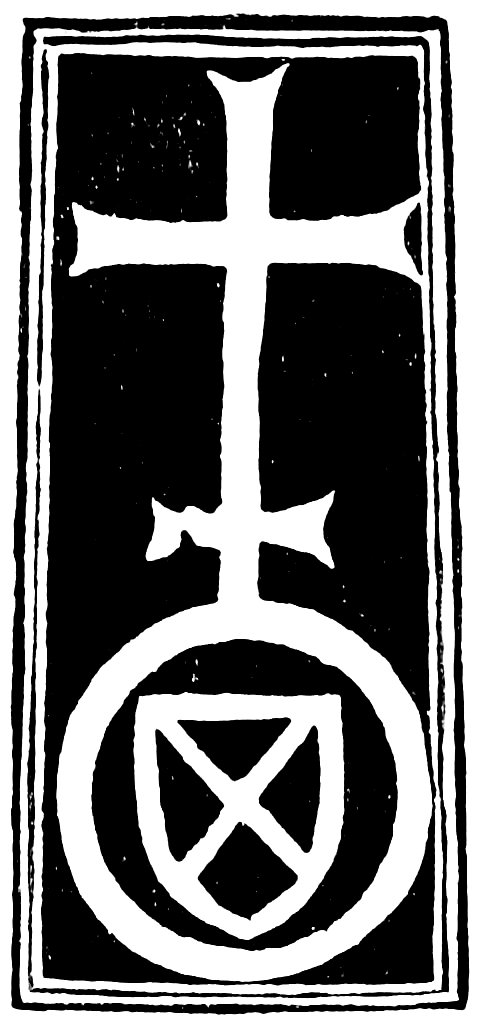
| Page | Original | Changed to |
|---|---|---|
| 38 | For sum gobbit wiƚƚ be yolow and sum geene | For sum gobbit wiƚƚ be yolow and sum greene |
| 38 | she e:genderith the Ry | she engenderith the Ry |
| 40 | How ẏe maẏ cawse ẏowre hawke to flẏe withe a cnrrage in the morow | How ẏe maẏ cawse ẏowre hawke to flẏe withe a currage in the morow |
| 42 | shaƚƚ make hit to loue meet the bettir for loue of the oyntement | shaƚƚ make hir to loue meet the bettir for loue of the oyntement |
| 45 | a cownde legge | a rownde legge |
| 50 | and co ther vppon | and colde ther vppon |
| 50 | like he: abowte the sere &̄ thossame | like heres about the sere &̄ thossame |
| 52 | same penne shƚƚ frete asonder | same penne shaƚƚ frete asonder |
| 52 | and then weete the slesħ ther in | and then weete the flesħ ther in |
| 53 | Whan ye haue ensaymed yowre hawke: and Rerlaymyd hir | Whan ye haue ensaymed yowre hawke: and Reclaymyd hir |
| 54 | wan ye haue so coon | wan ye haue so doon |
| 55 | and is dewarded as I haue sayde | and is rewarded as I haue sayde |
| 55 | she haue Reiosed hir | she haue Reioysed hir |
| 55 | Lrene wele oon thyng | Lerne wele oon thyng |
| 63 | The Croampe commyth to an hawke with takyng of colode in hir yowthe | The Croampe commyth to an hawke with takyng of coolde in hir yowthe |
| 68 | anoyt her meete therin | anoȳt her meete therin |
| 68 | fede hennys or ehykynnes therwith | fede hennys or chykynnes therwith |
| 74 | secunde yeue hir epatike with the fhesħ of a chycon | secunde yeue hir epatike with the flesħ of a chycon |
| 74 | for furfete of federis that be yeuen to hawkis | for surfete of federis that be yeuen to hawkis |
| 75 | she is waked she assayeth to put ouer ot | she is waked she assayeth to put ouer at |
| 75 | A medeeẏne for the Entreẏllis | A medecẏne for the Entreẏllis |
| 75 | the hawke wiƚƚ be very eegre and gleetous of the seekenes | the hawke wiƚƚ be very eegre and glettous of the seekenes |
| 76 | For blaẏnis ī haukes monthes cald frounches | For blaẏnis ī haukes mouthes cald frounches |
| 76 | Wete hir fleshe in sarsoiƚƚ or ellis seeth Rafue in water | Wete hir fleshe in sarfoiƚƚ or ellis seeth Rafne in water |
| 77 | ellis fille the hooƚƚ with a powdre of arnemelit Ibrent | ellis fille the hooƚƚ with a powdre of arnement Ibrent |
| 79 | Perchẏth. Ioẏkith. Puttihouer Proẏnẏth | Perchẏth. Ioẏkith. Puttithouer Proẏnẏth |
| 79 | She tytith vppon Rumppys | She tyrith vppon Rumppys |
| 81 | The wodecok is comboroue to sle | The wodecok is comborous to sle |
| 84 | Nowe ẏe shall vnderstonde if a man wlll make | Nowe ẏe shall vnderstonde if a man will make |
| 87 | And theis be of an oder maner kynde. for thay flie to Ouerre | And theis be of an oder maner kynde. for thay flie to Querre |
| 89 | declared in the boooke folowyng | declared in the booke folowyng |
| 92 | Sane that yowre howndes eete | Saue that yowre howndes eete |
| 98 | And iff yowre houudes chace weeƚƚ at yowre wiƚƚ | And iff yowre houndes chace weeƚƚ at yowre wiƚƚ |
| 101 | What is the cause quod the man naister I the pray | What is the cause quod the man maister I the pray |
| 102 | Now of the Nomblis nierhe wele the termẏs | Now of the Nomblis merke wele the termẏs |
| 108 | To vudo the wẏlde Boore. | To vndo the wẏlde Boore. |
| 111 | Than bryng it hoom. aud the skynne with aƚƚ | Than bryng it hoom. and the skynne with aƚƚ |
| 117 | a Festre of Brweris | a Festre of Brewris |
| 123 | the oryente thow shat take that other theirde parte of the worlde which shaƚƚ be calde affrica | the oryente thow shalt take that other theirde parte of the worlde which shaƚƚ be calde affrica |
| 132 | By the Olif tree he vnderstode vietery for to wyn̄ | By the Olif tree he vnderstode victery for to wyn̄ |
| 133 | Oon is a gentylman of Cotarmure of the gynges bagge | Oon is a gentylman of Cotarmure of the kynges bagge |
| 133 | a kyng geuyng a lorshipp to a yoman | a kyng geuyng a lordshipp to a yoman |
| 133 | same knyght is a gentyman of blode | same knyght is a gentylman of blode |
| 134 | modre may bere the right heyris cotamrure | modre may bere the right heyris cotarmure |
| 138 | The fifthe quadrate is calde Endently of .iij. diuse weis | The fifthe quadrate is calde Endently of .iij. diu̇se weis |
| 139 | Here shall be shewed what Cootarmtris restrẏal | Here shall be shewed what Cootarmuris restrẏal |
| 152 | crucem planom inuectam de coloribus albis & nigris | crucem planam inuectam de coloribus albis & nigris |
| 160 | And then hit shaƚƚ be sayd that he the the wiche berith this cros. | And then hit shaƚƚ be sayd that he the wiche berith this cros. |
| 165 | men say they be army quarterit of cololowris inueckyt | men say they be army quarterit of colowris inueckyt |
| 166 | Ther is also a ꝑtyng of .ij. colowris clowdit or nbulatit | Ther is also a ꝑtyng of .ij. colowris clowdit or nebulatit |
| 166 | calde ptit armys for they be made of .ij. colouris equalli ptit | calde ꝑtit armys for they be made of .ij. colouris equalli ꝑtit |
| 166 | He berith asure and Syluer playn ptit | He berith asure and Syluer playn ꝑtit |
| 166 | Also ther is pticion of armys engralyt the long way as is | Also ther is ꝑticion of armys engralyt the long way as is |
| 166 | Il port dargent ingraylee et Sable ptee du long | Il port dargent ingraylee et Sable ꝑtee du long |
| 167 | ere now it shaƚƚ be shewyt of armys partit and irrasit | now it shaƚƚ be shewyt of armys partit and irrasit |
| 167 | Il port ꝑtee du long dargent et de gwlez race | Il port ꝑtee du long dargent et de gowlez race |
| 169 | Off armys ꝑtyt watėi of Syluer and gowles this scochon is | Off armys ꝑtyt watṫi of Syluer and gowles this scochon is |
| 172 | made bi the man of palis | made bi the maṅ of palis |
| 174 | Il port barre dargent et Sale | Il port barre dargent et Sable |
| 178 | Il port dor vng bende de gwlez Anglice | Il port dor vng bende de gowlez Anglice |
| 178 | He beth golde &̄ a bende of gowles | He berith golde &̄ a bende of gowles |
| 179 | bere the booƚƚ armys | bere the hooƚƚ armys |
| 180 | Protat arma de auro fymbriata siue bordurata | Portat arma de auro fymbriata siue bordurata |
| 182 | ther is an other bor- that is calde a bordure gobonatit | ther is an other bordure that is calde a bordure gobonatit |
| 182 | it shaƚƚ be shewyt ī thys scooehon neyt folowyng | it shaƚƚ be shewyt ī thys scooehon next folowyng |
| 190 | wych begynne in the right borne of the shelde | wych begynne in the right horne of the shelde |
| 195 | Off Cheueuerons differyng on the longe way | Off Cheuerons differyng on the longe way |
| 195 | Also theys signes or Cheuroens be differit after the long | Also theys signes or Cheuerons be differit after the long |
| 200 | to a mannye heed | to a mannys heed |
| 200 | And so wich owte dowte | And so with owte dowte |
| 201 | wich onys their enteryng: by tbatt instrumente | wich onys their enteryng: by thatt instrumente |
| 201 | How here ye most knaw that theys armys Sawtre be other | Now here ye most knaw that theys armys Sawtre be other |
| 210 | And they they be calde sawtre engradit | And then they be calde sawtre engradit |
| 202 | it shaƚƚ be sayd in lotyn | it shaƚƚ be sayd in latyn |
| 202 | signys ar put in a shelde by the mauer of a pale | signys ar put in a shelde by the maner of a pale |
| 202 | Il port dasor et et trois corones barrez dor | Il port dasor et trois corones barrez dor |
| 203 | pisces argnteos natantes in campo nigro | pisces argenteos natantes in campo nigro |
| 204 | the hoke afore I haue made no mencion | the boke afore I haue made no mencion |
| 208 | an other while an other lightly be losys both | an other while an other lightly he losys both |
| 208 | other rordys ar better or of sych dignyte | other lordys ar better or of sych dignyte |
| 209 | sū bi od u̇tuys | sū bi oḋ u̇tuys |
This eBook is for the use of anyone anywhere in the United States and most other parts of the world at no cost and with almost no restrictions whatsoever. You may copy it, give it away or re-use it under the terms of the Project Gutenberg License included with this eBook or online at www.gutenberg.org. If you are not located in the United States, you will have to check the laws of the country where you are located before using this eBook.